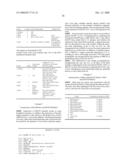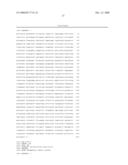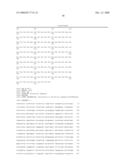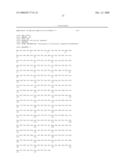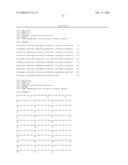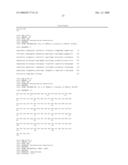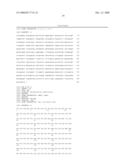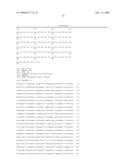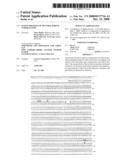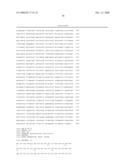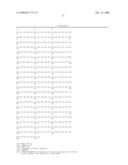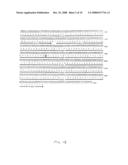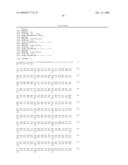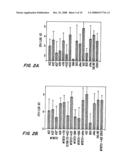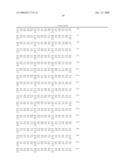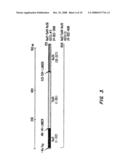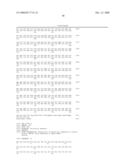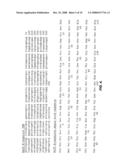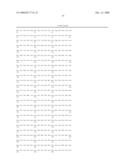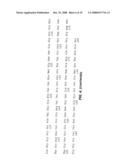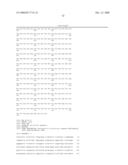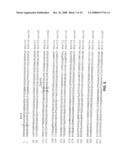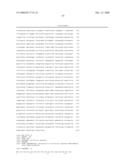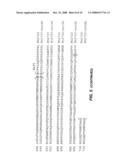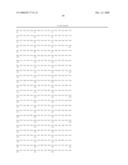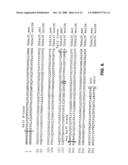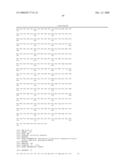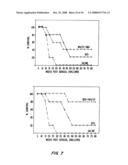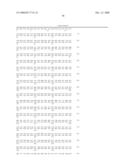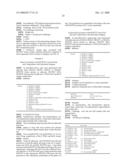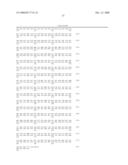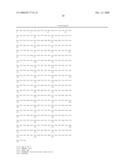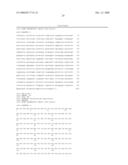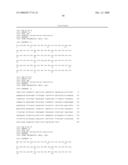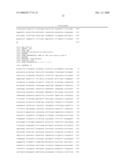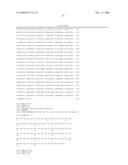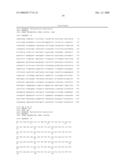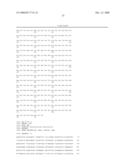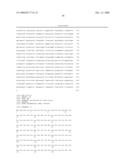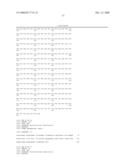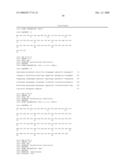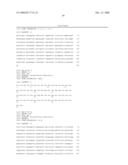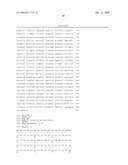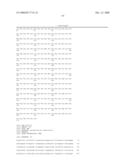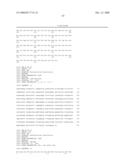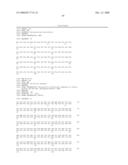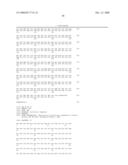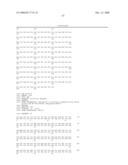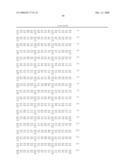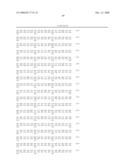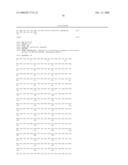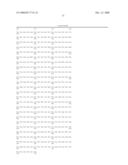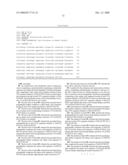Patent application title: Fusion proteins of mycobacterium tuberculosis
Inventors:
Yasir Skeiky (Bellevue, WA, US)
Steven Reed (Bellevue, WA, US)
Mark Alderson (Bainbridge Island, WA, US)
Mark Alderson (Bainbridge Island, WA, US)
Assignees:
Corixa Corporation
IPC8 Class: AA61K3574FI
USPC Class:
424 932
Class name: Drug, bio-affecting and body treating compositions whole live micro-organism, cell, or virus containing genetically modified micro-organism, cell, or virus (e.g., transformed, fused, hybrid, etc.)
Publication date: 2008-12-25
Patent application number: 20080317716
Claims:
1-88. (canceled)
89. An isolated host cell transfected with an expression vector comprising a polynucleotide comprising a nucleotide sequence encoding a fusion polypeptide, said fusion polypeptide comprising a first amino acid sequence having at least 95% sequence identity to SEQ ID NO:14 and a second amino acid sequence having at least 95% sequence identity to SEQ ID NO:8, and wherein the amino acid corresponding to position 176 in SEQ ID NO:8 is not a serine.
90. The host cell of claim 89, wherein the encoded fusion polypeptide further comprises a third amino acid sequence having at least 95% sequence identity to SEQ ID NO:10.
91. The host cell of claim 89, wherein the encoded fusion has an amino acid corresponding to position 176 in SEQ ID NO:8 which is an alanine.
92. The host cell of claim 90, wherein the encoded fusion has an amino acid corresponding to position 176 in SEQ ID NO:8 which is an alanine.
93. The host cell of claim 89, wherein the encoded fusion polypeptide has at least 95% sequence identity to SEQ ID NO:18 or SEQ ID NO:20.
94. The host cell of claim 89, wherein the encoded fusion polypeptide comprises the amino acid sequence of SEQ ID NO:14 and the amino acid sequence of SEQ ID NO:8, and wherein the amino acid corresponding to position 176 in SEQ ID NO:8 is not a serine.
95. The host cell of claim 94, wherein the encoded fusion polypeptide further comprises the amino acid sequence of SEQ ID NO:10.
96. The host cell of claim 89, wherein the encoded fusion polypeptide comprises the amino acid sequence of SEQ ID NO:18.
97. The host cell of claim 89, wherein the encoded fusion polypeptide comprises the amino acid sequence of SEQ ID NO:20 with an alanine replacing the serine at position 577.
98. The host cell of any one of claims 89 to 97, wherein the host cell is a Bacillus-Calmette-Guerrin.
99. A method for the treatment and/or prevention of tuberculosis comprising administering an effective amount of a Bacillus-Calmette-Guerrin which expresses on its cell surface or secretes a fusion polypeptide, said fusion polypeptide comprising a first amino acid sequence having at least 95% sequence identity to SEQ ID NO:14 and a second amino acid sequence having at least 95% sequence identity to SEQ ID NO:8, and wherein the amino acid corresponding to position 176 in SEQ ID NO:8 is not a serine.
100. The method of claim 99, wherein the fusion polypeptide further comprises a third amino acid sequence having at least 95% sequence identity to SEQ ID NO:10.
101. The method of claim 99 or 100, wherein the fusion polypeptide has an amino acid corresponding to position 176 in SEQ ID NO:8 which is an alanine.
102. The method of claim 99, wherein the fusion polypeptide has at least 95% sequence identity to SEQ ID NO:18 or SEQ ID NO:20.
103. The method of claim 99, wherein the encoded fusion polypeptide comprises the amino acid sequence of SEQ ID NO:14 and the amino acid sequence of SEQ ID NO:8, and wherein the amino acid corresponding to position 176 in SEQ ID NO:8 is not a serine.
104. The method of claim 103, wherein the fusion polypeptide further comprises the amino acid sequence of SEQ ID NO:10.
105. The method of claim 99, wherein the fusion polypeptide comprises the amino acid sequence of SEQ ID NO:18.
106. The method of claim 99, wherein the fusion polypeptide comprises the amino acid sequence of SEQ ID NO:20 with an alanine replacing the serine at position 577.
Description:
CROSS-REFERENCES TO RELATED APPLICATIONS
[0001]The present application claims priority to U.S. patent application Ser. No. 09/597,796, filed Jun. 20, 2000, and U.S. patent application No. 60/265,737, filed Feb. 1, 2001, herein each incorporated by reference in their entirety.
[0002]The present application is related to U.S. patent application Ser. No. 09/056,556, filed Apr. 7, 1998; U.S. patent application Ser. No. 09/223,040, filed Dec. 30, 1998; U.S. patent application Ser. No. 09/287,849, filed Apr. 7, 1999; published PCT application No. WO99/51748, filed Apr. 7, 1999 (PCT/US99/07717), U.S. patent application No. 60/158,338, filed Oct. 7, 1999, and U.S. application No. 60/158,425, filed Oct. 7, 1999; U.S. application Ser. No. 09/688,672, filed Oct. 10, 2000; and published PCT application No. WO01/24820, filed Oct. 10, 2000 (PCT/US00/28095); herein each incorporated by reference in its entirety.
STATEMENT AS TO RIGHTS TO INVENTIONS MADE UNDER FEDERALLY SPONSORED RESEARCH AND DEVELOPMENT
[0003]Not applicable.
FIELD OF THE INVENTION
[0004]The present invention relates to fusion proteins containing at least two Mycobacterium sp. antigens. In particular, it relates to nucleic acids encoding fusion proteins that include two or more individual M. tuberculosis antigens, which increase serological sensitivity of sera from individuals infected with tuberculosis, and methods for their use in the diagnosis, treatment, and prevention of tuberculosis infection.
BACKGROUND OF THE INVENTION
[0005]Tuberculosis is a chronic infectious disease caused by infection with M. tuberculosis and other Mycobacterium species. It is a major disease in developing countries, as well as an increasing problem in developed areas of the world, with about 8 million new cases and 3 million deaths each year. Although the infection may be asymptomatic for a considerable period of time, the disease is most commonly manifested as an acute inflammation of the lungs, resulting in fever and a nonproductive cough. If untreated, serious complications and death typically result.
[0006]Although tuberculosis can generally be controlled using extended antibiotic therapy, such treatment is not sufficient to prevent the spread of the disease. Infected individuals may be asymptomatic, but contagious, for some time. In addition, although compliance with the treatment regimen is critical, patient behavior is difficult to monitor. Some patients do not complete the course of treatment, which can lead to ineffective treatment and the development of drug resistance.
[0007]In order to control the spread of tuberculosis, effective vaccination and accurate early diagnosis of the disease are of utmost importance. Currently, vaccination with live bacteria is the most efficient method for inducing protective immunity. The most common mycobacterium employed for this purpose is Bacillus Calmette-Guerin (BCG), an avirulent strain of M. bovis. However, the safety and efficacy of BCG is a source of controversy and some countries, such as the United States, do not vaccinate the general public with this agent.
[0008]Diagnosis of tuberculosis is commonly achieved using a skin test, which involves intradermal exposure to tuberculin PPD (protein-purified derivative). Antigen-specific T cell responses result in measurable induration at the injection site by 48-72 hours after injection, which indicates exposure to mycobacterial antigens. Sensitivity and specificity have, however, been a problem with this test, and individuals vaccinated with BCG cannot be distinguished from infected individuals.
[0009]While macrophages have been shown to act as the principal effectors of Mycobacterium immunity, T cells are the predominant inducers of such immunity. The essential role of T cells in protection against Mycobacterium infection is illustrated by the frequent occurrence of Mycobacterium infection in AIDS patients, due to the depletion of CD4.sup.+ T cells associated with human immunodeficiency virus (HIV) infection. Mycobacterium-reactive CD4.sup.+ T cells have been shown to be potent producers of γ-interferon (IFN-γ), which, in turn, has been shown to trigger the anti-mycobacterial effects of macrophages in mice. While the role of IFN-γ in humans is less clear, studies have shown that 1,25-dihydroxy-vitamin D3, either alone or in combination with IFN-γ or tumor necrosis factor-alpha, activates human macrophages to inhibit M. tuberculosis infection. Furthermore, it is known that IFN-γ stimulates human macrophages to make 1,25-dihydroxy-vitamin D3. Similarly, interleukin-12 (IL-12) has been shown to play a role in stimulating resistance to M. tuberculosis infection. For a review of the immunology of M. tuberculosis infection, see Chan & Kaufmann, Tuberculosis: Pathogenesis, Protection and Control (Bloom ed., 1994), and Harrison's Principles of Internal Medicine, volume 1, pp. 1004-1014 and 1019-1023 (14th ed., Fauci et al., eds., 1998).
[0010]Accordingly, there is a need for improved diagnostic reagents, and improved methods for diagnosis, preventing and treating tuberculosis.
SUMMARY OF THE INVENTION
[0011]The present invention therefore provides compositions comprising at least two heterologous antigens, fusion proteins comprising the antigens, and nucleic acids encoding the antigens, where the antigens are from a Mycobacterium species from the tuberculosis complex and other Mycobacterium species that cause opportunistic infections in immune compromised patients. The present invention also relates methods of using the polypeptides and polynucleotides in the diagnosis, treatment and prevention of Mycobacterium infection.
[0012]In one aspect, the present invention provides compositions and fusion proteins comprising a mutated version of Ra35 (N-terminal portion of MTB32A) or Ra35FL (full length MTB32A), in which one, two, or three of the three amino acids histidine, aspartate, or serine at the active site has been mutated to a different amino acid. In one embodiment, in Ra35FL, the serine at position 183 has been mutated to an alanine residue, creating Ra35FLMutSA. In one embodiment, the DNA encoding Ra35FL has been mutated by changing a T to a G, resulting in a serine to alanine mutation at amino acid 183 of SEQ ID NO:4. In another embodiment, the present invention provides the fusion protein MTB72FMutSA, in which the Ra35 component of the fusion protein has a serine to alanine mutation at amino acid position 710 of the MTB72F sequence. In another embodiment, the present invention provides a nucleic acid encoding the fusion protein MTB72F, in which the nucleic acid encoding the Ra35 component has been mutated by changing a T to a G, resulting in a serine to alanine mutation at amino acid position 710 of the MTB72F sequence.
[0013]The present invention is based, in part, on the inventors' discovery that fusion polynucleotides, fusion polypeptides, or compositions that contain at least two heterologous M. tuberculosis coding sequences or antigens are highly antigenic and upon administration to a patient increase the sensitivity of tuberculosis sera. In addition, the compositions, fusion polypeptides and polynucleotides are useful as diagnostic tools in patients that may have been infected with Mycobacterium.
[0014]In one aspect, the compositions, fusion polypeptides, and nucleic acids of the invention are used in in vitro and in vivo assays for detecting humoral antibodies or cell-mediated immunity against M. tuberculosis for diagnosis of infection or monitoring of disease progression. For example, the polypeptides may be used as an in vivo diagnostic agent in the form of an intradermal-skin test. The polypeptides may also be used in in vitro tests such as an ELISA with patient serum. Alternatively, the nucleic acids, the compositions, and the fusion polypeptides may be used to raise anti-M. tuberculosis antibodies in a non-human animal. The antibodies can be used to detect the target antigens in vivo and in vitro.
[0015]In another aspect, the compositions, fusion polypeptides and nucleic acids may be used as immunogens to generate or elicit a protective immune response in a patient. The isolated or purified polynucleotides are used to produce recombinant fusion polypeptide antigens in vitro, which are then administered as a vaccine. Alternatively, the polynucleotides may be administered directly into a subject as DNA vaccines to cause antigen expression in the subject, and the subsequent induction of an anti-M. tuberculosis immune response. Thus, the isolated or purified M. tuberculosis polypeptides and nucleic acids of the invention may be formulated as pharmaceutical compositions for administration into a subject in the prevention and/or treatment of M. tuberculosis infection. The immunogenicity of the fusion protein or antigens may be enhanced by the inclusion of an adjuvant, as well as additional fusion polypeptides, from Mycobacterium or other organisms, such as bacterial, viral, mammalian polypeptides. Additional polypeptides may also be included in the compositions, either linked or unlinked to the fusion polypeptide or compositions.
BRIEF DESCRIPTION OF THE DRAWINGS
[0016]FIG. 1 shows percent survival of Guinea pigs vaccinated with MTB72F polyprotein.
[0017]FIG. 2 shows CFUs from spleen cells (FIG. 2A) and lung cells after immunization with MTB72F, MTB59F, MTB72F DNA, or a composition comprising Ra12, TbH9, and Ra35 antigens.
[0018]FIG. 3 shows a schematic diagram of MTB72F.
[0019]FIG. 4 shows the nucleotide and amino acid sequence of Ra35 (195 amino acids from the N-terminal portion of MTB32A).
[0020]FIG. 5 shows an alignment of the amino acid sequences of MTB72F and the mutated version MTB72FMutSA.
[0021]FIG. 6 shows an alignment of the amino acid sequences of mature (full length) Ra35/MTB32A and the mutated version Ra35FLMutSA.
[0022]FIG. 7 shows long term survival of guinea pigs vaccinated with Mtb72F formulations.
DESCRIPTION OF THE SPECIFIC EMBODIMENTS
[0023]The present invention relates to compositions comprising antigen compositions and fusion polypeptides useful for the diagnosis and treatment of Mycobacterium infection, polynucleotides encoding such antigens, and methods for their use. The antigens of the present invention are polypeptides or fusion polypeptides of Mycobacterium antigens and immunogenic thereof. More specifically, the compositions of the present invention comprise at least two heterologous polypeptides of a Mycobacterium species of the tuberculosis complex, e.g., a species such as M. tuberculosis, M. bovis, or M. africanum, or a Mycobacterium species that is environmental or opportunistic and that causes opportunistic infections such as lung infections in immune compromised hosts (e.g., patients with AIDS), e.g., BCG, M. avium, M. intracellulare, M. celatum, M. genavense, M. haemophilum, M. kansasii, M. simiae, M. vaccae, M. fortuitum, and M. scrofulaceum (see, e.g., Harrison's Principles of Internal Medicine, volume 1, pp. 1004-1014 and 1019-1023 (14th ed., Fauci et al., eds., 1998). The inventors of the present application surprisingly discovered that compositions and fusion proteins comprising at least two heterologous Mycobacterium antigens, or immunogenic fragments thereof, where highly antigenic. These compositions, fusion polypeptides, and the nucleic acids that encode them are therefore useful for eliciting protective response in patients, and for diagnostic applications.
[0024]The antigens of the present invention may further comprise other components designed to enhance the antigenicity of the antigens or to improve these antigens in other aspects, for example, the isolation of these antigens through addition of a stretch of histidine residues at one end of the antigen. The compositions, fusion polypeptides, and nucleic acids of the invention can comprise additional copies of antigens, or additional heterologous polypeptides from Mycobacterium sp., such as MTB8.4 antigen, MTB9.8 antigen, MTB9.9 antigen, MTB40 antigen, MTB41 antigen, 38-1, TbRa3, 38 kD, DPEP, TbH4, DPPD, ESAT-6 antigen, MTB85 complex antigen (e.g., MTB85b), or α-crystalline antigen, and Erd14. The compositions, fusion polypeptides, and nucleic acids of the invention can also comprise additional heterologous polypeptides from other non-Mycobacterium sources. For example, the compositions and fusion proteins of the invention can include polypeptides or nucleic acids encoding polypeptides, wherein the polypeptide enhances expression of the antigen, e.g., NS1, an influenza virus protein, or an immunogenic portion thereof (see, e.g. WO99/40188 and WO93/04175). The nucleic acids of the invention can be engineered based on codon preference in a species of choice, e.g., humans.
[0025]The compositions of the invention can be naked DNA, or the compositions, e.g., polypeptides can also comprise adjuvants, e.g., MPL, 3D-MPL, IFA, AS adjuvants such as AS2, AS2', AS2'', AS4, AS6, ENHANZYN (Detox), QS21, CWS, TDM, AGP, CPG, Leif, saponin, and saponin mimetics, and derivatives thereof. In addition, the compositions of the invention can comprise BCG or Pvac as an adjuvant.
[0026]In one embodiment, the compositions and fusion proteins of the invention are composed of at least two antigens selected from the group consisting of a MTB39 antigen or an immunogenic fragment thereof from a Mycobacterium species of the tuberculosis complex, and a MTB32A antigen or an immunogenic fragment thereof from a Mycobacterium species of the tuberculosis complex.
[0027]In another embodiment, the antigens are selected from the group consisting of a MTB39 antigen or an immunogenic fragment thereof from a Mycobacterium species of the tuberculosis complex, and a polypeptide comprising at least 205 amino acids of the N-terminus of a MTB32A antigen from a Mycobacterium species of the tuberculosis complex.
[0028]In another embodiment, the antigens are selected from the group consisting of a MTB39 antigen or an immunogenic fragment thereof from a Mycobacterium species of the tuberculosis complex, a polypeptide comprising at least about 205 amino acids of the N-terminus of a MTB32A antigen from a Mycobacterium species of the tuberculosis complex, and a polypeptide comprising at least about 132 amino acids from the C-terminus of MTB32A antigen from a Mycobacterium species of the tuberculosis complex.
[0029]In the nomenclature of the application, Ra35 refers to the N-terminus of MTB32A (Ra35FL), comprising at least about 195 to 205 amino acids of MTB32A from M. tuberculosis, or the corresponding region from another Mycobacterium-species. Ra12 refers to the C-terminus of MTB32A (Ra35FL), comprising at least about the last 132 amino acids from MTB32A from M. tuberculosis, or the corresponding region from another Mycobacterium species.
[0030]The following provides sequences of some antigens-used in the compositions and fusion proteins of the invention:
[0031]SEQ ID NO:1-4: MTB32A (Ra35FL or Ra35 mature), the sequence of which is also disclosed as SEQ ID NO:17 (cDNA) and SEQ ID NO:79 (protein) in the U.S. patent application Ser. Nos. 08/523,436, 08/523,435, Ser. No. 08/658,800, Ser. No. 08/659,683, Ser. No. 08/818,112, Ser. No. 09/056,556, and Ser. No. 08/818,111 and in the WO97/09428 and WO97/09429 applications, see also Skeiky et al., Infection and Immunity 67:3998-4007 (1999). The term MTB32A also includes MTB32A amino acid sequences in which any one of the three amino acids at the active site triad (His, Asp, Ser), e.g., the serine residue at amino acid position 207 in SEQ ID NO:2 or amino acid position 183 in SEQ ID NO:4, has been changed to another amino acid (e.g., alanine, Ra35FLMutSA, see, e.g., FIG. 6 and SEQ ID NO:6).
[0032]SEQ ID NO:5 and 6: Ra35FLMut SA, the mature version of RA35FL in which the serine residue at amino acid position 183 of SEQ ID NO:4 has been changed to an alanine residue.
[0033]SEQ ID NO:7 and 8: Ra35, the N-terminus of MTB32A (Ra35FL), comprising at least about 195 amino acids from the N-terminus of MTB32A from M. tuberculosis, the nucleotide and amino acid sequence of which is disclosed in FIG. 4 (see also amino acids 33-227 of SEQ ID NO:2 and amino acids 8 to 202 of SEQ ID NO:4). The term Ra35 (N-term) also includes Ra35 amino acid sequences in which any one of the three amino acids at the active site triad (i.e., His, Asp, or Ser) has been changed as described above.
[0034]SEQ ID NO:9 and 10: MTBRa12, the C-terminus of MTB32A (Ra35FL), comprising at least about 132 amino acids from the C-terminus of MTB32A from M. tuberculosis (see, e.g., amino acids 224 to 355 of SEQ ID NO:2 and amino acids 199 to 330 of SEQ ID NO:4), the sequence of which is disclosed as SEQ ID NO:4 (DNA) and SEQ ID NO:66 (predicted amino acid sequence) in the U.S. patent application Ser. No. 09/072,967.
[0035]SEQ ID NO:11, 12, 13, and 14: MTB39 (TbH9), the sequence of which is disclosed as SEQ ID NO:106 (cDNA full length) and SEQ ID NO:107 (protein full length) in the U.S. patent applications No. 08/658,800, Ser. No. 08/659,683, Ser. No. 08/818,112, and No. 08/818,111 and in the WO97/09428 and WO97/09429 applications. The sequence is also disclosed as SEQ ID NO:33 (DNA) and SEQ ID NO:91 (amino acid) in U.S. patent application Ser. No. 09/056,559.
[0036]The following provides sequences of some fusion proteins of the invention
[0037]SEQ ID NO:15 and 16: MTB72F (Ra12-TbH9-Ra35), the sequence of which is disclosed as SEQ ID NO:1 (DNA) and SEQ ID NO:2 (protein) in the U.S. patent application Ser. No. 09/223,040, Ser. No. 09/223,040, and in the PCT/US99/07717 application. The term MTB372F also includes MTB72F amino acid sequences in which any one of the three amino acids at the active site triad in Ra35FL (i.e., His, Asp, or Ser), has been changed as described above (see, e.g., MTB72FMutSA, FIG. 5).
[0038]SEQ ID NO:17 and 18: MTB72FMutSA (Ra12-TbH9-Ra35MutSA), wherein, in the Ra35 component of the fusion protein, the serine at position 710 has been changed to an alanine.
[0039]SEQ ID NO:19 and 20: TbH9-Ra35 (MTB59F), the sequence of which is disclosed as SEQ ID NO:23 (cDNA) and SEQ ID NO:24 (protein) in the U.S. patent application Ser. No. 09/287,849 and in the PCT/US99/07717 application.
[0040]The following provides sequences of some additional antigens used in the compositions and fusion proteins of the invention:
[0041]SEQ ID NO: 21 and 22: MTB8.4 (DPV), the sequence of which is disclosed as SEQ ID NO:01 (cDNA) and SEQ ID NO:102 (protein) in the U.S. patent application Ser. No. 08/658,800, Ser. No. 08/659,683, Ser. No. 08/818,112 and Ser. No. 08/818,111 and in the WO97/09428 and WO97/09429 applications.
[0042]SEQ ID NO:23 and 24: MTB9.8 (MSL), the sequence of which is disclosed as SEQ ID NO:12 (DNA), SEQ ID NO:109 (predicted amino acid sequence) and SEQ ID NO:110 to 124 (peptides) in the U.S. patent application Ser. No. 08/859,381, Ser. No. 08/858,998, Ser. No. 09/073,009 and Ser. No. 09/073,010 and in the PCT/US98/10407 and PCT/US98/10514 applications.
[0043]SEQ ID NO:25, 26, and 27: MTB9.9A (MTI, also known as MTI-A), the sequence of which is disclosed as SEQ ID NO:3 and SEQ ID NO:4 (DNA) and SEQ ID NO:29 and SEQ ID NO:51 to 66 (ORF peptide for MTI) in the U.S. patent application Ser. No. 08/859,381, Ser. No. 08/858,998, Ser. Nos. 09/073,009 and 09/073,010 and in the PCT/US98/10407 and PCT/US98/10514 applications. Two other MTI variants also exist, called MTI-B and MTI-C.
[0044]SEQ ID NO:28 and 29: MTB40 (HTCC#1), the sequence of which is disclosed as SEQ ID NO:137 (cDNA) and 138 (predicted amino acid sequence) in the U.S. patent applications No. 09/073,009 and No. 09/073,010 and in the PCT/US98/10407 and PCT/US98/10514 applications.
[0045]SEQ ID NO:30 and 31: MTB41 (MTCC#2), the sequence of which is disclosed as SEQ ID NO:140 (cDNA) and SEQ ID NO:142 (predicted amino acid sequence) in the U.S. patent applications No. 09/073,009 and No. 09/073,010 and in the PCT/US98/10407 and PCT/US98/10514 applications.
[0046]SEQ ID NO:32 and 33: ESAT-6, the sequence of which is disclosed as SEQ ID NO:103 (DNA) and SEQ ID NO:104 (predicted amino acid sequence) in the U.S. patent application Ser. No. 09/072,967. The sequence of ESAT-6 is also disclosed in U.S. Pat. No. 5,955,077.
[0047]SEQ ID NO:34 and 35: Tb38-1 or 38-1 (MTb1), the sequence of which is disclosed in SEQ ID NO:46 (DNA) and SEQ ID NO:88 (predicted amino acid) in the U.S. patent application Ser. Nos. 09/072,96; 08/523,436; 08/523,435; 08/818,112; and 08/818,111; and in the WO97/09428 and WO97/09429 applications.
[0048]SEQ ID NO:36 and 37: TbRa3, the sequence of which is disclosed in SEQ ID NO:15 (DNA) and SEQ ID NO:77 (predicted amino acid sequence) of WO 97/09428 and WO97/09429 applications.
[0049]SEQ ID NO:38 and 39: 38 kD, the sequence of which is disclosed in SEQ ID NO:154 (DNA) and SEQ ID NO:155 (predicted amino acid sequence) in the U.S. patent application Ser. No. 09/072,967. 38 kD has two alternative forms, with and without the N-terminal cysteine residue.
[0050]SEQ ID NO:40 and 41: DPEP, the sequence of which is disclosed in SEQ ID NO:52 (DNA) and SEQ ID NO:53 (predicted amino acid sequence) in the WO97/09428 and WO97/09429 publications.
[0051]SEQ ID NO:42 and 43: TbH4, the sequence of which is disclosed as SEQ ID NO:43 (DNA) and SEQ ID NO:81 (predicted amino acid sequence) in WO97/09428 and WO97/09429 publications.
[0052]SEQ ID NO:44 and 45: DPPD, the sequence of which is disclosed in SEQ ID NO:240 (DNA) and SEQ ID NO:241 (predicted amino acid sequence) in U.S. Ser. No. 09/072,967 and in the PCT/US99/03268 and PCT/US99/03265 applications. The secreted form of DPPD is shown herein in FIG. 12 of PCT/US00/28095.
[0053]MTb82 (MTb867), the sequence of which is disclosed in FIGS. 8 (DNA) and 9 (amino acid) of PCT/US00/28095.
[0054]Erd14 (MTb16), the cDNA and amino acids sequences of which are disclosed in Verbon et al., J. Bacteriology 174:1352-1359 (1992).
[0055]-crystalline antigen, the sequence of which is disclosed in Verbon et al., J. Bact. 174:1352-1359 (1992);
[0056]85 complex antigen, e.g., 85b antigen, the sequence of which is disclosed in Content et al., Infect. & Immunol. 59:3205-3212 (1991).
[0057]The following provides sequences of some additional fusion proteins used in the compositions and fusion proteins of the invention:
[0058]SEQ ID NO:46 and 47: DPV-MTI-MSL-MTCC#2 (MTb71F), the sequence of which is disclosed as SEQ ID NO:15 (nucleic acid) and in SEQ ID NO:16: (protein) in the U.S. patent application Ser. No. 09/287,849 and in the PCT/US99/07717 application.
[0059]SEQ ID NO:48 and 49: DPV-MTI-MSL (MTb31F), the sequence of which is disclosed in SEQ ID NO:18 (cDNA) and SEQ ID NO:19 (protein) in the U.S. patent application Ser. No. 09/287,849 and in the PCT/US99/07717 application.
[0060]Each of the above sequences is also disclosed in Cole et al. Nature 393:537 (1998) and can be found at, e.g., http://www.sanger.ac.uk and http:/www.pasteur.fr/mycdb/.
[0061]The above sequences are disclosed in U.S. patent application Ser. Nos. 08/523,435, 08/523,436, 08/658,800, 08/659,683, 08/818,111, 08/818,112, 08/942,341, 08/942,578, 08/858,998, 08/859,381, 09/056,556, 09/072,596, 09/072,967, 09/073,009, 09/073,010, 09/223,040, 09/287,849 09/597,796; and in PCT patent applications PCT/US00/28095; PCT/US98/10407, PCT/US98/10514, PCT/US99/03265, PCT/US99/03268, PCT/US99/07717, WO97/09428 and WO97/09429, WO98/16645, WO98/16646, each of which is herein incorporated by reference.
[0062]The antigens described herein include polymorphic variants and conservatively modified variations, as well as inter-strain and interspecies Mycobacterium homologs. In addition, the antigens described herein include subsequences or truncated sequences. The fusion proteins may also contain additional polypeptides, optionally heterologous peptides from Mycobacterium or other sources. These antigens may be modified, for example, by adding linker peptide sequences as described below. These linker peptides may be inserted between one or more polypeptides which make up each of the fusion proteins.
DEFINITIONS
[0063]Fusion polypeptide" or "fusion protein" refers to a protein having at least two heterologous Mycobacterium sp. polypeptides covalently linked, either directly or via an amino acid linker. The polypeptides forming the fusion protein are typically linked C-terminus to N-terminus, although they can also be linked C-terminus to C-terminus, N-terminus to N-terminus, or N-terminus to C-terminus. The polypeptides of the fusion protein can be in any order. This term also refers to conservatively modified variants, polymorphic variants, alleles, mutants, subsequences, interspecies homologs, and immunogenic fragments of the antigens that make up the fusion protein. Mycobacterium tuberculosis antigens are described in Cole et al., Nature 393:537 (1998), which discloses the entire Mycobacterium tuberculosis genome. The complete sequence of Mycobacterium tuberculosis can also be found at http://www.sanger.ac.uk and at http://www.pasteur.fr/mycdb/ (MycDB). Antigens from other Mycobacterium species that correspond to M. tuberculosis antigens can be identified, e.g., using sequence comparison algorithms, as described herein, or other methods known to those of skill in the art, e.g., hybridization assays and antibody binding assays. Fusion proteins of the invention can also comprise additional copies of a component antigen or immunogenic fragment thereof.
[0064]A polynucleotide sequence comprising a fusion protein of the invention hybridizes under stringent conditions to at least two nucleotide sequences, each encoding an antigen polypeptide selected from the group consisting of MTB39 or an immunogenic fragment thereof and MTB32A or an immunogenic fragment thereof. The polynucleotide sequences encoding the individual antigens of the fusion polypeptide therefore include conservatively modified variants, polymorphic variants, alleles, mutants, subsequences, immunogenic fragments, and interspecies homologs of MTB39 and MTB32A. The polynucleotide sequence encoding the individual polypeptides of the fusion protein can be in any order.
[0065]In some embodiments, the individual polypeptides of the fusion protein are in order (N- to C-terminus) from large to small. Large antigens are approximately 30 to 150 kD in size, medium antigens are approximately 10 to 30 kD in size, and small antigens are approximately less than 10 kD in size. The sequence encoding the individual polypeptide may be as small as, e.g., an immunogenic fragment such as an individual CTL epitope encoding about 8 to 9 amino acids, or, e.g., an HTL or B cell epitope. The fragment may also include multiple epitopes. The immunogenic fragment may also represent a larger part of the antigen sequence, e.g., about 50% or more of MTB39 and MTB32A, e.g., the N- and C-terminal portions of MTB32A. Preferred immunogenic fragments of MTB32A include Ra12, Ra35, and Ra35MutSA.
[0066]A fusion polypeptide of the invention specifically binds to antibodies raised against at least two antigen polypeptides, wherein each antigen polypeptide is selected from the group consisting of MTB39 or an immunogenic portion or fragment thereof and MTB32A or an immunogenic portion thereof. The antibodies can be polyclonal or monoclonal. Optionally, the fusion polypeptide specifically binds to antibodies raised against the fusion junction of the antigens, which antibodies do not bind to the antigens individually, i.e., when they are not part of a fusion protein. The fusion polypeptides optionally comprise additional polypeptides, e.g., three, four, five, six, or more polypeptides, up to about 25 polypeptides, optionally heterologous polypeptides or repeated homologous polypeptides, fused to the at least two heterologous antigens. The additional polypeptides of the fusion protein are optionally derived from Mycobacterium as well as other sources, such as other bacterial, viral, or invertebrate, vertebrate, or mammalian sources. The individual polypeptides of the fusion protein can be in any order. As described herein, the fusion protein can also be linked to other molecules, including additional polypeptides. The compositions of the invention can also comprise additional polypeptides that are unlinked to the fusion proteins of the invention. These additional polypeptides may be heterologous or homologous polypeptides.
[0067]The term "fused" refers to the covalent linkage between two polypeptides in a fusion protein. The polypeptides are typically joined via a peptide bond, either directly to each other or via an amino acid linker. Optionally, the peptides can be joined via non-peptide covalent linkages known to those of skill in the art.
[0068]FL" refers to full-length, i.e., a polypeptide that is the same length as the wild-type polypeptide.
[0069]The term "immunogenic fragment thereof" refers to a polypeptide comprising an epitope that is recognized by cytotoxic T lymphocytes, helper T lymphocytes or B cells. Preferred immunogenic fragments of, e.g., MTB32A, are RA35, Ra35MutSA, or Ra12.
[0070]The term "Mycobacterium species of the tuberculosis complex" includes those species traditionally considered as causing the disease tuberculosis, as well as Mycobacterium environmental and opportunistic species that cause tuberculosis and lung disease in immune compromised patients, such as patients with AIDS, e.g., M. tuberculosis, M. bovis, or M. africanum, BCG, M. avium, M intracellulare, M. celatum, M. genavense, M. haemophilum, M. kansasii, M. simiae, M. vaccae, M. fortuitum, and M. scrofulaceum (see, e.g., Harrison's Principles of Internal Medicine, volume 1, pp. 1004-1014 and 1019-1023 (14th ed., Fauci et al., eds., 1998).
[0071]An adjuvant refers to the components in a vaccine or therapeutic composition that increase the specific immune response to the antigen (see, e.g., Edelman, AIDS Res. Hum Retroviruses 8:1409-1411 (1992)). Adjuvants induce immune responses of the Th1-type and Th-2 type response. Th1-type cytokines (e.g., IFN-γ, IL-2, and IL-12) tend to favor the induction of cell-mediated immune response to an administered antigen, while Th-2 type cytokines (e.g., IL-4, IL-5, Il-6, IL-10 and TNF-β) tend to favor the induction of humoral immune responses.
[0072]Nucleic acid" refers to deoxyribonucleotides or ribonucleotides and polymers thereof in either single- or double-stranded form. The term encompasses nucleic acids containing known nucleotide analogs or modified backbone residues or linkages, which are synthetic, naturally occurring, and non-naturally occurring, which have similar binding properties as the reference nucleic acid, and which are metabolized in a manner similar to the reference nucleotides. Examples of such analogs include, without limitation, phosphorothioates, phosphoramidates, methyl phosphonates, chiral-methyl phosphonates, 2-O-methyl ribonucleotides, peptide-nucleic acids (PNAs).
[0073]Unless otherwise indicated, a particular nucleic acid sequence also implicitly encompasses conservatively modified variants thereof (e.g., degenerate codon substitutions) and complementary sequences, as well as the sequence explicitly indicated. Specifically, degenerate codon substitutions may be achieved by generating sequences in which the third position of one or more selected (or all) codons is substituted with mixed-base and/or deoxyinosine residues (Batzer et al., Nucleic Acid Res. 19:5081 (1991); Ohtsuka et al., J. Biol. Chem. 260:2605-2608 (1985); Rossolini et al., Mol. Cell. Probes 8:91-98 (1994)). The term nucleic acid is used interchangeably with gene, cDNA, mRNA, oligonucleotide, and polynucleotide.
[0074]The terms "polypeptide," "peptide" and "protein" are used interchangeably herein to refer to a polymer of amino acid residues. The terms apply to amino acid polymers in which one or more amino acid residue is an artificial chemical mimetic of a corresponding naturally occurring amino acid, as well as to naturally occurring amino acid polymers and non-naturally occurring amino acid polymer.
[0075]The term "amino acid" refers to naturally occurring and synthetic amino acids, as well as amino acid analogs and amino acid mimetics that function in a manner similar to the naturally occurring amino acids. Naturally occurring amino acids are those encoded by the genetic code, as well as those amino acids that are later modified, e.g., hydroxyproline, γ-carboxyglutamate, and O-phosphoserine. Amino acid analogs refers to compounds that have the same basic chemical structure as a naturally occurring amino acid, i.e., an αcarbon that is bound to a hydrogen, a carboxyl group, an amino group, and an R group, e.g., homoserine, norleucine, methionine sulfoxide, methionine methyl sulfonium. Such analogs have modified R groups (e.g., norleucine) or modified peptide backbones, but retain the same basic chemical structure as a naturally occurring amino acid. Amino acid mimetics refers to chemical compounds that have a structure that is different from the general chemical structure of an amino acid, but that functions in a manner similar to a naturally occurring amino acid.
[0076]Amino acids may be referred to herein by either their commonly known three letter symbols or by the one-letter symbols recommended by the IUPAC-IUB Biochemical Nomenclature Commission. Nucleotides, likewise, may be referred to by their commonly accepted single-letter codes.
[0077]Conservatively modified variants" applies to both amino acid and nucleic acid sequences. With respect to particular nucleic acid sequences, conservatively modified variants refers to those nucleic acids which encode identical or essentially identical amino acid sequences, or where the nucleic acid does not encode an amino acid sequence, to essentially identical sequences. Because of the degeneracy of the genetic code, a large number of functionally identical nucleic acids encode any given protein. For instance, the codons GCA, GCC, GCG and GCU all encode the amino acid alanine. Thus, at every position where an alanine is specified by a codon, the codon can be altered to any of the corresponding codons described without altering the encoded polypeptide. Such nucleic acid variations are "silent variations," which are one species of conservatively modified variations. Every nucleic acid sequence herein which encodes a polypeptide also describes every possible silent variation of the nucleic acid. One of skill will recognize that each codon in a nucleic acid (except AUG, which is ordinarily the only codon for methionine, and TGG, which is ordinarily the only codon for tryptophan) can be modified to yield a functionally identical molecule. Accordingly, each silent variation of a nucleic acid which encodes a polypeptide is implicit in each described sequence.
[0078]As to amino acid sequences, one of skill will recognize that individual substitutions, deletions or additions to a nucleic acid, peptide, polypeptide, or protein sequence which alters, adds or deletes a single amino acid or a small percentage of amino acids in the encoded sequence is a "conservatively modified variant" where the alteration results in the substitution of an amino acid with a chemically similar amino acid. Conservative substitution tables providing functionally similar amino acids are well known in the art. Such conservatively modified variants are in addition to and do not exclude polymorphic variants, interspecies homologs, and alleles of the invention.
[0079]The following eight groups each contain amino acids that are conservative substitutions for one another:
1) Alanine (A), Glycine (G);
[0080]2) Aspartic acid (D), Glutamic acid (E);
3) Asparagine (N), Glutamine (Q);
4) Arginine (R), Lysine (K);
5) Isoleucine (I), Leucine (L), Methionine (M), Valine (V);
6) Phenylalanine (F), Tyrosine (Y), Tryptophan (W);
7) Serine (S), Threonine (T); and
8) Cysteine (C), Methionine (M)
[0081](see, e.g., Creighton, Proteins (1984)).
[0082]The term "heterologous" when used with reference to portions of a nucleic acid indicates that the nucleic acid comprises two or more subsequences that are not found in the same relationship to each other in nature. For instance, the nucleic acid is typically recombinantly produced, having two or more sequences from unrelated genes arranged to make a new functional nucleic acid, e.g., a promoter from one source and a coding region from another source. Similarly, a heterologous protein indicates that the protein comprises two or more subsequences that are not found in the same relationship to each other in nature (e.g., a fusion protein).
[0083]The phrase "selectively (or specifically) hybridizes to" refers to the binding, duplexing, or hybridizing of a molecule only to a particular nucleotide sequence under stringent hybridization conditions when that sequence is present in a complex mixture (e.g., total cellular or library DNA or RNA).
[0084]The phrase "stringent hybridization conditions" refers to conditions under which a probe will hybridize to its target subsequence, typically in a complex mixture of nucleic acid, but to no other sequences. Stringent conditions are sequence-dependent and will be different in different circumstances. Longer sequences hybridize specifically at higher temperatures. An extensive guide to the hybridization of nucleic acids is found in Tijssen, Techniques in Biochemistry and Molecular Biology--Hybridization with Nucleic Probes, "Overview of principles of hybridization and the strategy of nucleic acid assays" (1993). Generally, stringent conditions are selected to be about 5-10° C. lower than the thermal melting point (Tm) for the specific sequence at a defined ionic strength pH. The Tm is the temperature (under defined ionic strength, pH, and nucleic concentration) at which 50% of the probes complementary to the target hybridize to the target sequence at equilibrium (as the target sequences are present in excess, at Tm, 50% of the probes are occupied at equilibrium). Stringent conditions will be those in which the salt concentration is less than about 1.0 M sodium ion, typically about 0.01 to 1.0 M sodium ion concentration (or other salts) at pH 7.0 to 8.3 and the temperature is at least about 30° C. for short probes (e.g., 10 to 50 nucleotides) and at least about 60° C. for long probes (e.g., greater than 50 nucleotides). Stringent conditions may also be achieved with the addition of destabilizing agents such as formamide. For selective or specific hybridization, a positive signal is at least two times background, optionally 10 times background hybridization. Exemplary stringent hybridization conditions can be as following: 50% formamide, 5×SSC, and 1% SDS, incubating at 42° C., or, 5×SSC, 1% SDS, incubating at 65° C., with wash in 0.2×SSC, and 0.1% SDS at 65° C.
[0085]Nucleic acids that do not hybridize to each other under stringent conditions are still substantially identical if the polypeptides which they encode are substantially identical. This occurs, for example, when a copy of a nucleic acid is created using the maximum codon degeneracy permitted by the genetic code. In such cases, the nucleic acids typically hybridize under moderately stringent hybridization conditions. Exemplary "moderately stringent hybridization conditions" include a hybridization in a buffer of 40% formamide, 1 M NaCl, 1% SDS at 37° C., and a wash in 1×SSC at 45° C. A positive hybridization is at least twice background. Those of ordinary skill will readily recognize that alternative hybridization and wash conditions can be utilized to provide conditions of similar stringency.
[0086]Antibody" refers to a polypeptide comprising a framework region from an immunoglobulin gene or fragments thereof that specifically binds and recognizes an antigen. The recognized immunoglobulin genes include the kappa, lambda, alpha, gamma, delta, epsilon, and mu constant region genes, as well as the myriad immunoglobulin variable region genes. Light chains are classified as either kappa or lambda. Heavy chains are classified as gamma, mu, alpha, delta, or epsilon, which in turn define the immunoglobulin classes, IgG, IgM, IgA, IgD and IgE, respectively.
[0087]An exemplary immunoglobulin (antibody) structural unit comprises a tetramer. Each tetramer is composed of two identical pairs of polypeptide chains, each pair having one "light" (about 25 kDa) and one "heavy" chain (about 50-70 kDa). The N-terminus of each chain defines a variable region of about 100 to 110 or more amino acids primarily responsible for antigen recognition. The terms variable light chain (VL) and variable heavy chain (VH) refer to these light and heavy chains respectively.
[0088]Antibodies exist, e.g., as intact immunoglobulins or as a number of well-characterized fragments produced by digestion with various peptidases. Thus, for example, pepsin digests an antibody below the disulfide linkages in the hinge region to produce F(ab)'2, a dimer of Fab which itself is a light chain joined to VH-CH1 by a disulfide bond. The F(ab)'2 may be reduced under mild conditions to break the disulfide linkage in the hinge region, thereby converting the F(ab)'2 dimer into an Fab' monomer. The Fab' monomer is essentially Fab with part of the hinge region (see Fundamental Immunology (Paul ed., 3d ed. 1993). While various antibody fragments are defined in terms of the digestion of an intact antibody, one of skill will appreciate that such fragments may be synthesized de novo either chemically or by using recombinant DNA methodology. Thus, the term antibody, as used herein, also includes antibody fragments either produced by the modification of whole antibodies, or those synthesized de novo using recombinant DNA methodologies (e.g., single chain Fv) or those identified using phage display libraries (see, e.g., McCafferty et al., Nature 348:552-554 (1990)).
[0089]For preparation of monoclonal or polyclonal antibodies, any technique known in the art can be used (see, e.g., Kohler & Milstein, Nature 256:495-497 (1975); Kozbor et al., Immunology Today 4: 72 (1983); Cole et al., pp. 77-96 in Monoclonal Antibodies and Cancer Therapy (1985)). Techniques for the production of single chain antibodies (U.S. Pat. No. 4,946,778) can be adapted to produce antibodies to polypeptides of this invention. Also, transgenic mice, or other organisms such as other mammals, may be used to express humanized antibodies. Alternatively, phage display technology can be used to identify antibodies and heteromeric Fab fragments that specifically bind to selected antigens (see, e.g., McCafferty et al., Nature 348:552-554 (1990); Marks et al., Biotechnology 10:779-783 (1992)).
[0090]The phrase "specifically (or selectively) binds" to an antibody or "specifically (or selectively) immunoreactive with," when referring to a protein or peptide, refers to a binding reaction that is determinative of the presence of the protein in a heterogeneous population of proteins and other biologics. Thus, under designated immunoassay conditions, the specified antibodies bind to a particular protein at least two times the background and do not substantially bind in a significant amount to other proteins present in the sample. Specific binding to an antibody under such conditions may require an antibody that is selected for its specificity for a particular protein. For example, polyclonal antibodies raised to fusion proteins can be selected to obtain only those polyclonal antibodies that are specifically immunoreactive with fusion protein and not with individual components of the fusion proteins. This selection may be achieved by subtracting out antibodies that cross-react with the individual antigens. A variety of immunoassay formats may be used to select antibodies specifically immunoreactive with a particular protein. For example, solid-phase ELISA immunoassays are routinely used to select antibodies specifically immunoreactive with a protein (see, e.g., Harlow & Lane, Antibodies, A Laboratory Manual (1988), for a description of immunoassay formats and conditions that can be used to determine specific immunoreactivity). Typically a specific or selective reaction will be at least twice background signal or noise and more typically more than 10 to 100 times background.
[0091]Polynucleotides may comprise a native sequence (i.e., an endogenous sequence that encodes an individual antigen or a portion thereof) or may comprise a variant of such a sequence. Polynucleotide variants may contain one or more substitutions, additions, deletions and/or insertions such that the biological activity of the encoded fusion polypeptide is not diminished, relative to a fusion polypeptide comprising native antigens. Variants preferably exhibit at least about 70% identity, more preferably at least about 80% identity and most preferably at least about 90% identity to a polynucleotide sequence that encodes a native polypeptide or a portion thereof.
[0092]The terms "identical" or percent "identity," in the context of two or more nucleic acids or polypeptide sequences, refer to two or more sequences or subsequences that are the same or have a specified percentage of amino acid residues or nucleotides that are the same (i.e., 70% identity, optionally 75%, 80%, 85%, 90%, or 95% identity over a specified region), when compared and aligned for maximum correspondence over a comparison window, or designated region as measured using one of the following sequence comparison algorithms or by manual alignment and visual inspection. Such sequences are then said to be "substantially identical." This definition also refers to the compliment of a test sequence. Optionally, the identity exists over a region that is at least about 25 to about 50 amino acids or nucleotides in length, or optionally over a region that is 75-100 amino acids or nucleotides in length.
[0093]For sequence comparison, typically one sequence acts as a reference sequence, to which test sequences are compared. When using a sequence comparison algorithm, test and reference sequences are entered into a computer, subsequence coordinates are designated, if necessary, and sequence algorithm program parameters are designated. Default program parameters can be used, or alternative parameters can be designated. The sequence comparison algorithm then calculates the percent sequence identities for the test sequences relative to the reference sequence, based on the program parameters.
[0094]A "comparison window", as used herein, includes reference to a segment of any one of the number of contiguous positions selected from the group consisting of from 25 to 500, usually about 50 to about 200, more usually about 100 to about 150 in which a sequence may be compared to a reference sequence of the same number of contiguous positions after the two sequences are optimally aligned. Methods of alignment of sequences for comparison are well-known in the art. Optimal alignment of sequences for comparison can be conducted, e.g., by the local homology algorithm of Smith & Waterman; Adv. Appl. Math. 2:482 (1981), by the homology alignment algorithm of Needleman & Wunsch, J. Mol. Biol. 48:443 (1970), by the search for similarity method of Pearson & Lipman, Proc. Nat'l. Acad. Sci. USA 85:2444 (1988), by computerized implementations of these algorithms (GAP, BESTFIT, FASTA, and TFASTA in the Wisconsin Genetics Software Package, Genetics Computer Group, 575 Science Dr., Madison, Wis.), or by manual alignment and visual inspection (see, e.g., Current Protocols in Molecular Biology (Ausubel et al., eds. 1995 supplement)).
[0095]One example of a useful algorithm is PILEUP. PILEUP creates a multiple sequence alignment from a group of related sequences using progressive, pairwise alignments to show relationship and percent sequence identity. It also plots a tree or dendogram showing the clustering relationships used to create the alignment. PILEUP uses a simplification of the progressive alignment method of Feng & Doolittle, J. Mol. Evol. 35:351-360 (1987). The method used is similar to the method described by Higgins & Sharp, CABIOS 5:151-153 (1989). The program can align up to 300 sequences, each of a maximum length of 5,000 nucleotides or amino acids. The multiple alignment procedure begins with the pairwise alignment of the two most similar sequences, producing a cluster of two aligned sequences. This cluster is then aligned to the next most related sequence or cluster of aligned sequences. Two clusters of sequences are aligned by a simple extension of the pairwise alignment of two individual sequences. The final alignment is achieved by a series of progressive, pairwise alignments. The program is run by designating specific sequences and their amino acid or nucleotide coordinates for regions of sequence comparison and by designating the program parameters. Using PILEUP, a reference sequence is compared to other test sequences to determine the percent sequence identity relationship using the following parameters: default gap weight (3.00), default gap length weight (0.10), and weighted end gaps. PILEUP can be obtained from the GCG sequence analysis software package, e.g., version 7.0 (Devereaux et al., Nuc. Acids Res. 12:387-395 (1984).
[0096]Another example of algorithm that is suitable for determining percent sequence identity and sequence similarity are the BLAST and BLAST 2.0 algorithms, which are described in Altschul et al., Nuc. Acids Res. 25:3389-3402 (1977) and Altschul et al., J. Mol. Biol. 215:403-410 (1990), respectively. Software for performing BLAST analyses is publicly available through the National Center for Biotechnology Information (http://www.ncbi.nlm.nih.gov/). This algorithm involves first identifying high scoring sequence pairs (HSPs) by identifying short words of length W in the query sequence, which either match or satisfy some positive-valued threshold score T when aligned with a word of the same length in a database sequence. T is referred to as the neighborhood word score threshold (Altschul et al., supra). These initial neighborhood word hits act as seeds for initiating searches to find longer HSPs containing them. The word hits are extended in both directions along each sequence for as far as the cumulative alignment score can be increased. Cumulative scores are calculated using, for nucleotide sequences, the parameters M (reward score for a pair of matching residues; always >0) and N (penalty score for mismatching residues; always <0). For amino acid sequences, a scoring matrix is used to calculate the cumulative score. Extension of the word hits in each direction are halted when: the cumulative alignment score falls off by the quantity X from its maximum achieved value; the cumulative score goes to zero or below, due to the accumulation of one or more negative-scoring residue alignments; or the end of either sequence is reached. The BLAST algorithm parameters W, T, and X determine the sensitivity and speed of the alignment. The BLASTN program (for nucleotide sequences) uses as defaults a wordlength (W) of 11, an expectation (E) or 10, M=5, N=-4 and a comparison of both strands. For amino acid sequences, the BLASTP program uses as defaults a wordlength of 3, and expectation (E) of 10, and the BLOSUM62 scoring matrix (see Henikoff & Henikoff, Proc. Natl. Acad. Sci. USA 89:10915 (1989)) alignments (B) of 50, expectation (E) of 10, M=5, N=-4, and a comparison of both strands.
[0097]The BLAST algorithm also performs a statistical analysis of the similarity between two sequences (see, e.g., Karlin & Altschul, Proc. Nat'l. Acad. Sci. USA 90:5873-5787 (1993)). One measure of similarity provided by the BLAST algorithm is the smallest sum probability (P(N)), which provides an indication of the probability by which a match between two nucleotide or amino acid sequences would occur by chance. For example, a nucleic acid is considered similar to a reference sequence if the smallest sum probability in a comparison of the test nucleic acid to the reference nucleic acid is less than about 0.2, more preferably less than about 0.01, and most preferably less than about 0.001.
Polynucleotide Compositions
[0098]As used herein, the terms "DNA segment" and "polynucleotide" refer to a DNA molecule that has been isolated free of total genomic DNA of a particular species. Therefore, a DNA segment encoding a polypeptide refers to a DNA segment that contains one or more coding sequences yet is substantially isolated away from, or purified free from, total genomic DNA of the species from which the DNA segment is obtained. Included within the terms "DNA segment" and "polynucleotide" are DNA segments and smaller fragments of such segments, and also recombinant vectors, including, for example, plasmids, cosmids, phagemids, phage, viruses, and the like.
[0099]As will be understood by those skilled in the art, the DNA segments of this invention can include genomic sequences, extra-genomic and plasmid-encoded sequences and smaller engineered gene segments that express, or may be adapted to express, proteins, polypeptides, peptides and the like. Such segments may be naturally isolated, or modified synthetically by the hand of man.
[0100]The terms "isolated," "purified," or "biologically pure" therefore refer to material that is substantially or essentially free from components that normally accompany it as found in its native state. Of course, this refers to the DNA segment as originally isolated, and does not exclude other isolated proteins, genes, or coding regions later added to the composition by the hand of man. Purity and homogeneity are typically determined using analytical chemistry techniques such as polyacrylamide gel electrophoresis or high performance liquid chromatography. A protein that is the predominant species present in a preparation is substantially purified. An isolated nucleic acid is separated from other open reading frames that flank the gene and encode proteins other than the gene.
[0101]As will be recognized by the skilled artisan, polynucleotides may be single-stranded (coding or antisense) or double-stranded, and may be DNA (genomic, cDNA or synthetic) or RNA molecules. RNA molecules include HnRNA molecules, which contain introns and correspond to a DNA molecule in a one-to-one manner, and mRNA molecules, which do not contain introns. Additional coding or non-coding sequences may, but need not, be present within a polynucleotide of the present invention, and a polynucleotide may, but need not, be linked to other molecules and/or support materials.
[0102]Polynucleotides may comprise a native sequence (i.e., an endogenous sequence that encodes a Mycobacterium antigen or a portion thereof) or may comprise a variant, or a biological or antigenic functional equivalent of such a sequence. Polynucleotide variants may contain one or more substitutions, additions, deletions and/or insertions, as further described below, preferably such that the immunogenicity of the encoded polypeptide is not diminished, relative to a native tumor protein. The effect on the immunogenicity of the encoded polypeptide may generally be assessed as described herein. The term "variants" also encompasses homologous genes of xenogenic origin.
[0103]In additional embodiments, the present invention provides isolated polynucleotides and polypeptides comprising various lengths of contiguous stretches of sequence identical to or complementary to one or more of the sequences disclosed herein. For example, polynucleotides are provided by this invention that comprise at least about 15, 20, 30, 40, 50, 75, 100, 150, 200, 300, 400, 500 or 1000 or more contiguous nucleotides of one or more of the sequences disclosed herein as well as all intermediate lengths there between. It will be readily understood that "intermediate lengths", in this context, means any length between the quoted values, such as 16, 17, 18, 19, etc.; 21, 22, 23, etc.; 30, 31, 32, etc.; 50, 51, 52, 53, etc.; 100, 101, 102, 103, etc.; 150, 151, 152, 153, etc.; including all integers through 200-500; 500-1,000, and the like.
[0104]The polynucleotides of the present invention, or fragments thereof, regardless of the length of the coding sequence itself, may be combined with other DNA sequences, such as promoters, polyadenylation signals, additional restriction enzyme sites, multiple cloning sites, other coding segments, and the like, such that their overall length may vary considerably. It is therefore contemplated that a nucleic acid fragment of almost any length may be employed, with the total length preferably being limited by the ease of preparation and use in the intended recombinant DNA protocol. For example, illustrative DNA segments with total lengths of about 10,000, about 5000, about 3000, about 2,000, about 1,000, about 500, about 200, about 100, about 50 base pairs in length, and the like, (including all intermediate lengths) are contemplated to be useful in many implementations of this invention.
[0105]Moreover, it will be appreciated by those of ordinary skill in the art that, as a result of the degeneracy of the genetic code, there are many nucleotide sequences that encode a polypeptide as described herein. Some of these polynucleotides bear minimal homology to the nucleotide sequence of any native gene. Nonetheless, polynucleotides that vary due to differences in codon usage are specifically contemplated by the present invention, for example polynucleotides that are optimized for human and/or primate codon selection. Further, alleles of the genes comprising the polynucleotide sequences provided herein are within the scope of the present invention. Alleles are endogenous genes that are altered as a result of one or more mutations, such as deletions, additions and/or substitutions of nucleotides. The resulting mRNA and protein may, but need not, have an altered structure or function. Alleles may be identified using standard techniques (such as hybridization, amplification and/or database sequence comparison).
Polynucleotide Identification and Characterization
[0106]Polynucleotides may be identified, prepared and/or manipulated using any of a variety of well established techniques. For example, a polynucleotide may be identified, as described in more detail below, by screening a microarray of cDNAs for tumor-associated expression (i.e., expression that is at least two fold greater in a tumor than in normal tissue, as determined using a representative assay provided herein). Such screens may be performed, for example, using a Synteni microarray (Palo Alto, Calif.) according to the manufacturer's instructions (and essentially as described by Schena et al., Proc. Natl. Acad. Sci. USA 93:10614-10619 (1996) and Heller et al., Proc. Natl. Acad. Sci. USA 94:2150-2155 (1997)). Alternatively, polynucleotides may be amplified from cDNA prepared from cells expressing the proteins described herein, such as M. tuberculosis cells. Such polynucleotides may be amplified via polymerase chain reaction (PCR). For this approach, sequence-specific primers may be designed based on the sequences provided herein, and may be purchased or synthesized.
[0107]An amplified portion of a polynucleotide of the present invention may be used to isolate a full length gene from a suitable library (e.g., a M. tuberculosis cDNA library) using well known techniques. Within such techniques, a library (cDNA or genomic) is screened using one or more polynucleotide probes or primers suitable for amplification. Preferably, a library is size-selected to include larger molecules. Random primed libraries may also be preferred for identifying 5' and upstream regions of genes. Genomic libraries are preferred for obtaining introns and extending 5' sequences.
[0108]For hybridization techniques, a partial sequence may be labeled (e.g., by nick-translation or end-labeling with 32P) using well known techniques. A bacterial or bacteriophage library is then generally screened by hybridizing filters containing denatured bacterial colonies (or lawns containing phage plaques) with the labeled probe (see Sambrook et al., Molecular Cloning: A Laboratory Manual (1989)). Hybridizing colonies or plaques are selected and expanded, and the DNA is isolated for further analysis. cDNA clones may be analyzed to determine the amount of additional sequence by, for example, PCR using a primer from the partial sequence and a primer from the vector. Restriction maps and partial sequences may be generated to identify one or more overlapping clones. The complete sequence may then be determined using standard techniques, which may involve generating a series of deletion clones. The resulting overlapping sequences can then assembled into a single contiguous sequence. A full length cDNA molecule can be generated by ligating suitable fragments, using well known techniques.
[0109]Alternatively, there are numerous amplification techniques for obtaining a full length coding sequence from a partial cDNA sequence. Within such techniques, amplification is generally performed via PCR. Any of a variety of commercially available kits may be used to perform the amplification step. Primers may be designed using, for example, software well known in the art. Primers are preferably 22-30 nucleotides in length, have a GC content of at least 50% and anneal to the target sequence at temperatures of about 68° C. to 72° C. The amplified region may be sequenced as described above, and overlapping sequences assembled into a contiguous sequence.
[0110]One such amplification technique is inverse PCR (see Triglia et al., Nucl. Acids Res. 16:8186 (1988)), which uses restriction enzymes to generate a fragment in the known region of the gene. The fragment is then circularized by intramolecular ligation and used as a template for PCR with divergent primers derived from the known region. Within an alternative approach, sequences adjacent to a partial sequence may be retrieved by amplification with a primer to a linker sequence and a primer specific to a known region. The amplified sequences are typically subjected to a second round of amplification with the same linker primer and a second primer specific to the known region. A variation on this procedure, which employs two primers that initiate extension in opposite directions from the known sequence, is described in WO 96/38591. Another such technique is known as "rapid amplification of cDNA ends" or RACE. This technique involves the use of an internal primer and an external primer, which hybridizes to a polyA region or vector sequence, to identify sequences that are 5' and 3' of a known sequence. Additional techniques include capture PCR (Lagerstrom et al., PCR Methods Applic. 1:111-19 (1991)) and walking PCR (Parker et al., Nucl. Acids. Res. 19:3055-60 (1991)). Other methods employing amplification may also be employed to obtain a full length cDNA sequence.
[0111]In certain instances, it is possible to obtain a full length cDNA sequence by analysis of sequences provided in an expressed sequence tag (EST) database, such as that available from GenBank. Searches for overlapping ESTs may generally be performed using well known programs (e.g., NCBI BLAST searches), and such ESTs may be used to generate a contiguous full length sequence. Full length DNA sequences may also be obtained by analysis of genomic fragments.
Polynucleotide Expression in Host Cells
[0112]In other embodiments of the invention, polynucleotide sequences or fragments thereof which encode polypeptides of the invention, or fusion proteins or functional equivalents thereof, may be used in recombinant DNA molecules to direct expression of a polypeptide in appropriate host cells. Due to the inherent degeneracy of the genetic code, other DNA sequences that encode substantially the same or a functionally equivalent amino acid sequence may be produced and these sequences may be used to clone and express a given polypeptide.
[0113]As will be understood by those of skill in the art, it may be advantageous in some instances to produce polypeptide-encoding nucleotide sequences possessing non-naturally occurring codons. For example, codons preferred by a particular prokaryotic or eukaryotic host can be selected to increase the rate of protein expression or to produce a recombinant RNA transcript having desirable properties, such as a half-life which is longer than that of a transcript generated from the naturally occurring sequence.
[0114]Moreover, the polynucleotide sequences of the present invention can be engineered using methods generally known in the art in order to alter polypeptide encoding sequences for a variety of reasons, including but not limited to, alterations which modify the cloning, processing, and/or expression of the gene product. For example, DNA shuffling by random fragmentation and PCR reassembly of gene fragments and synthetic oligonucleotides may be used to engineer the nucleotide sequences. In addition, site-directed mutagenesis may be used to insert new restriction sites, alter glycosylation patterns, change codon preference, produce splice variants, or introduce mutations, and so forth.
[0115]In another embodiment of the invention, natural, modified, or recombinant nucleic acid sequences may be ligated to a heterologous sequence to encode a fusion protein. For example, to screen peptide libraries for inhibitors of polypeptide activity, it may be useful to encode a chimeric protein that can be recognized by a commercially available antibody. A fusion protein may also be engineered to contain a cleavage site located between the polypeptide-encoding sequence and the heterologous protein sequence, so that the polypeptide may be cleaved and purified away from the heterologous moiety.
[0116]Sequences encoding a desired polypeptide may be synthesized, in whole or in part, using chemical methods well known in the art (see Caruthers, M. H. et al., Nucl. Acids Res. Symp. Ser. pp. 215-223 (1980), Horn et al., Nucl. Acids Res. Symp. Ser. pp. 225-232 (1980)). Alternatively, the protein itself may be produced using chemical methods to synthesize the amino acid sequence of a polypeptide, or a portion thereof. For example, peptide synthesis can be performed using various solid-phase techniques (Roberge et al., Science 269:202-204 (1995)) and automated synthesis may be achieved, for example, using the ABI 431A Peptide Synthesizer (Perkin Elmer, Palo Alto, Calif.).
[0117]A newly synthesized peptide may be substantially purified by preparative high performance liquid chromatography (e.g., Creighton, Proteins, Structures and Molecular Principles (1983)) or other comparable techniques available in the art. The composition of the synthetic peptides may be confirmed by amino acid analysis or sequencing (e.g., the Edman degradation procedure). Additionally, the amino acid sequence of a polypeptide, or any part thereof, may be altered during direct synthesis and/or combined using chemical methods with sequences from other proteins, or any part thereof, to produce a variant polypeptide.
[0118]In order to express a desired polypeptide, the nucleotide sequences encoding the polypeptide, or functional equivalents, may be inserted into appropriate expression vector, i.e., a vector which contains the necessary elements for the transcription and translation of the inserted coding sequence. Methods which are well known to those skilled in the art may be used to construct expression vectors containing sequences encoding a polypeptide of interest and appropriate transcriptional and translational control elements. These methods include in vitro recombinant DNA techniques, synthetic techniques, and in vivo genetic recombination. Such techniques are described in Sambrook et al., Molecular Cloning, A Laboratory Manual (1989), and Ausubel et al., Current Protocols in Molecular Biology (1989).
[0119]A variety of expression vector/host systems may be utilized to contain and express polynucleotide sequences. These include, but are not limited to, microorganisms such as bacteria transformed with recombinant bacteriophage, plasmid, or cosmid DNA expression vectors; yeast transformed with yeast expression vectors; insect cell systems infected with virus expression vectors (e.g., baculovirus); plant cell systems transformed with virus expression vectors (e.g., cauliflower mosaic virus, CaMV; tobacco mosaic virus, TMV) or with bacterial expression vectors (e.g., Ti or pBR322 plasmids); or animal cell systems.
[0120]The "control elements" or "regulatory sequences" present in an expression vector are those non-translated regions of the vector--enhancers, promoters, 5' and 3' untranslated regions--which interact with host cellular proteins to carry out transcription and translation. Such elements may vary in their strength and specificity. Depending on the vector system and host utilized, any number of suitable transcription and translation elements, including constitutive and inducible promoters, may be used. For example, when cloning in bacterial systems, inducible promoters such as the hybrid lacZ promoter of the PBLUESCRIPT phagemid (Stratagene, La Jolla, Calif.) or PSPORT1 plasmid (Gibco BRL, Gaithersburg, Md.) and the like may be used. In mammalian cell systems, promoters from mammalian genes or from mammalian viruses are generally preferred. If it is necessary to generate a cell line that contains multiple copies of the sequence encoding a polypeptide, vectors based on SV40 or EBV may be advantageously used with an appropriate selectable marker.
[0121]In bacterial systems, a number of expression vectors may be selected depending upon the use intended for the expressed polypeptide. For example, when large quantities are needed, for example for the induction of antibodies, vectors which direct high level expression of fusion proteins that are readily purified may be used. Such vectors include, but are not limited to, the multifunctional E. coli cloning and expression vectors such as BLUESCRIPT (Stratagene), in which the sequence encoding the polypeptide of interest may be ligated into the vector in frame with sequences for the amino-terminal Met and the subsequent 7 residues of β-galactosidase so that a hybrid protein is produced; pIN vectors (Van Heeke & Schuster, J. Biol. Chem. 264:5503-5509 (1989)); and the like. pGEX Vectors (Promega, Madison, Wis.) may also be used to express foreign polypeptides as fusion proteins with glutathione S-transferase (GST). In general, such fusion proteins are soluble and can easily be purified from lysed cells by adsorption to glutathione-agarose beads followed by elution in the presence of free glutathione. Proteins made in such systems may be designed to include heparin, thrombin, or factor XA protease cleavage sites so that the cloned polypeptide of interest can be released from the GST moiety at will.
[0122]In the yeast, Saccharomyces cerevisiae, a number of vectors containing constitutive or inducible promoters such as alpha factor, alcohol oxidase, and PGH may be used. For reviews, see Ausubel et al. (supra) and Grant et al., Methods Enzymol. 153:516-544 (1987).
[0123]In cases where plant expression vectors are used, the expression of sequences encoding, polypeptides may be driven by any of a number of promoters. For example, viral promoters such as the 35S and 19S promoters of CaMV may be used alone or in combination with the omega leader sequence from TMV (Takamatsu, EMBO J. 6:307-311 (1987)). Alternatively, plant promoters such as the small subunit of RUBISCO or heat shock promoters may be used (Coruzzi et al., EMBO J. 3:1671-1680 (1984); Broglie et al., Science 224:838-843 (1984); and Winter et al., Results Probl. Cell Differ. 17:85-105 (1991)). These constructs can be introduced into plant cells by direct DNA transformation or pathogen-mediated transfection. Such techniques are described in a number of generally available reviews (see, e.g., Hobbs in McGraw Hill Yearbook of Science and Technology pp. 191-196 (1992)).
[0124]An insect system may also be used to express a polypeptide of interest. For example, in one such system, Autographa californica nuclear polyhedrosis virus (AcNPV) is used as a vector to express foreign genes in Spodoptera frugiperda cells or in Trichoplusia larvae. The sequences encoding the polypeptide may be cloned into a non-essential region of the virus, such as the polyhedrin gene, and placed under control of the polyhedrin promoter. Successful insertion of the polypeptide-encoding sequence will render the polyhedrin gene inactive and produce recombinant virus lacking coat protein. The recombinant viruses may then be used to infect, for example, S. frugiperda cells or Trichoplusia larvae in which the polypeptide of interest may be expressed (Engelhard et al., Proc. Natl. Acad. Sci. U.S.A. 91:3224-3227 (1994)).
[0125]In mammalian host cells, a number of viral-based expression systems are generally available. For example, in cases where an adenovirus is used as an expression vector, sequences encoding a polypeptide of interest may be ligated into an adenovirus transcription/translation complex consisting of the late promoter and tripartite leader sequence. Insertion in a non-essential E1 or E3 region of the viral genome may be used to obtain a viable virus which is capable of expressing the polypeptide in infected host cells (Logan & Shenk, Proc. Natl. Acad. Sci. U.S.A. 81:3655-3659 (1984)). In addition, transcription enhancers, such as the Rous sarcoma virus (RSV) enhancer, may be used to increase expression in mammalian host cells.
[0126]Specific initiation signals may also be used to achieve more efficient translation of sequences encoding a polypeptide of interest. Such signals include the ATG initiation codon and adjacent sequences. In cases where sequences encoding the polypeptide, its initiation codon, and upstream sequences are inserted into the appropriate expression vector, no additional transcriptional or translational control signals may be needed. However, in cases where only coding sequence, or a portion thereof, is inserted, exogenous translational control signals including the ATG initiation codon should be provided. Furthermore, the initiation codon should be in the correct reading frame to ensure translation of the entire insert. Exogenous translational elements and initiation codons may be of various origins, both natural and synthetic. The efficiency of expression may be enhanced by the inclusion of enhancers which are appropriate for the particular cell system which is used, such as those described in the literature (Scharf. et al., Results Probl. Cell Differ. 20:125-162 (1994)).
[0127]In addition, a host cell strain may be chosen for its ability to modulate the expression of the inserted sequences or to process the expressed protein in the desired fashion. Such modifications of the polypeptide include, but are not limited to, acetylation, carboxylation. glycosylation, phosphorylation, lipidation, and acylation. Post-translational processing which cleaves a "prepro" form of the protein may also be used to facilitate correct insertion, folding and/or function. Different host cells such as CHO, HeLa, MDCK, HEK293, and WI38, which have specific cellular machinery and characteristic mechanisms for such post-translational activities, may be chosen to ensure the correct modification and processing of the foreign protein.
[0128]For long-term, high-yield production of recombinant proteins, stable expression is generally preferred. For example, cell lines which stably express a polynucleotide of interest may be transformed using expression vectors which may contain viral origins of replication and/or endogenous expression elements and a selectable marker gene on the same or on a separate vector. Following the introduction of the vector, cells may be allowed to grow for 1-2 days in an enriched media before they are switched to selective media. The purpose of the selectable marker is to confer resistance to selection, and its presence allows growth and recovery of cells which successfully express the introduced sequences. Resistant clones of stably transformed cells may be proliferated using tissue culture techniques appropriate to the cell type.
[0129]Any number of selection systems may be used to recover transformed cell lines. These include, but are not limited to, the herpes simplex virus thymidine kinase (Wigler et al., Cell 11:223-32 (1977)) and adenine phosphoribosyltransferase (Lowy et al., Cell 22:817-23 (1990)) genes which can be employed in tk.sup.- or aprt.sup.-cells, respectively. Also, antimetabolite, antibiotic or herbicide resistance can be used as the basis for selection; for example, dhfr which confers resistance to methotrexate (Wigler et al., Proc. Natl. Acad. Sci. U.S.A. 77:3567-70 (1980)); npt, which confers resistance to the aminoglycosides, neomycin and G-418 (Colbere-Garapin et al., J. Mol. Biol. 150:1-14 (1981)); and als or pat, which confer resistance to chlorsulfuron and phosphinotricin acetyltransferase, respectively (Murry, supra). Additional selectable genes have been described, for example, trpB, which allows cells to utilize indole in place of tryptophan, or hisD, which allows cells to utilize histinol in place of histidine (Hartman & Mulligan, Proc. Natl. Acad. Sci. U.S.A. 85:8047-51 (1988)). Recently, the use of visible markers has gained popularity with such markers as anthocyanins, β-glucuronidase and its substrate GUS, and luciferase and its substrate luciferin, being widely used not only to identify transformants, but also to quantify the amount of transient or stable protein expression attributable to a specific vector system (Rhodes et al., Methods Mol. Biol. 55:121-131 (1995)).
[0130]Although the presence/absence of marker gene expression suggests that the gene of interest is also present, its presence and expression may need to be confirmed. For example, if the sequence encoding a polypeptide is inserted within a marker gene sequence, recombinant cells containing sequences can be identified by the absence of marker gene function. Alternatively, a marker gene can be placed in tandem with a polypeptide-encoding sequence under the control of a single promoter. Expression of the marker gene in response to induction or selection usually indicates expression of the tandem gene as well.
[0131]Alternatively, host cells which contain and express a desired polynucleotide sequence may be identified by a variety of procedures known to those of skill in the art. These procedures include, but are not limited to, DNA-DNA or DNA-RNA hybridizations and protein bioassay or immunoassay techniques which include membrane, solution, or chip based technologies for the detection and/or quantification of nucleic acid or protein.
[0132]A variety of protocols for detecting and measuring the expression of polynucleotide-encoded products, using either polyclonal or monoclonal antibodies specific for the product are known in the art. Examples include enzyme-linked immunosorbent assay (ELISA), radioimmunoassay (RIA), and fluorescence activated cell sorting (FACS). A two-site, monoclonal-based immunoassay utilizing monoclonal antibodies reactive to two non-interfering epitopes on a given polypeptide may be preferred for some applications, but a competitive binding assay may also be employed. These and other assays are described, among other places, in Hampton et al., Serological Methods, a Laboratory Manual (1990) and Maddox et al., J. Exp. Med. 158:1211-1216 (1983).
[0133]A wide variety of labels and conjugation techniques are known by those skilled in the art and may be used in various nucleic acid and amino acid assays. Means for producing labeled hybridization or PCR probes for detecting sequences related to polynucleotides include oligolabeling, nick translation, end-labeling or PCR amplification using a labeled nucleotide. Alternatively, the sequences, or any portions thereof may be cloned into a vector for the production of an mRNA probe. Such vectors are known in the art, are commercially available, and may be used to synthesize RNA probes in vitro by addition of an appropriate RNA polymerase such as T7, T3, or SP6 and labeled nucleotides. These procedures may be conducted using a variety of commercially available kits. Suitable reporter molecules or labels, which may be used include radionuclides, enzymes, fluorescent, chemiluminescent, or chromogenic agents as well as substrates, cofactors, inhibitors, magnetic particles, and the like.
[0134]Host cells transformed with a polynucleotide sequence of interest may be cultured under conditions suitable for the expression and recovery of the protein from cell culture. The protein produced by a recombinant cell may be secreted or contained intracellularly depending on the sequence and/or the vector used. As will be understood by those of skill in the art, expression vectors containing polynucleotides of the invention may be designed to contain signal sequences which direct secretion of the encoded polypeptide through a prokaryotic or eukaryotic cell membrane. Other recombinant constructions may be used to join sequences encoding a polypeptide of interest to nucleotide sequence encoding a polypeptide domain which will facilitate purification of soluble proteins. Such purification facilitating domains include, but are not limited to, metal chelating peptides such as histidine-tryptophan modules that allow purification on immobilized metals, protein A domains that allow purification on immobilized immunoglobulin, and the domain utilized in the FLAGS extension/affinity purification system (Immunex Corp., Seattle, Wash.). The inclusion of cleavable linker sequences such as those specific for Factor XA or enterokinase (Invitrogen. San Diego, Calif.) between the purification domain and the encoded polypeptide may be used to facilitate purification. One such expression vector provides for expression of a fusion protein containing a polypeptide of interest and a nucleic acid encoding 6 histidine residues preceding a thioredoxin or an enterokinase cleavage site. The histidine residues facilitate purification on IMIAC (immobilized metal ion affinity chromatography) as described in Porath et al., Prot. Exp. Purif. 3:263-281 (1992) while the enterokinase cleavage site provides a means for purifying the desired polypeptide from the fusion protein. A discussion of vectors which contain fusion proteins is provided in Kroll et al., DNA Cell Biol. 12:441-453 (1993)).
[0135]In addition to recombinant production methods, polypeptides of the invention, and fragments thereof, may be produced by direct peptide synthesis using solid-phase techniques (Merrifield, J. Am. Chem. Soc. 85:2149-2154 (1963)). Protein synthesis may be performed using manual techniques or by automation. Automated synthesis may be achieved, for example, using Applied Biosystems 431A Peptide Synthesizer (Perkin Elmer). Alternatively, various fragments may be chemically synthesized separately and combined using chemical methods to produce the full length molecule.
In Vivo Polynucleotide Delivery Techniques
[0136]In additional embodiments, genetic constructs comprising one or more of the polynucleotides of the invention are introduced into cells in vivo. This may be achieved using any of a variety or well known approaches, several of which are outlined below for the purpose of illustration.
[0137]1. Adenovirus
[0138]One of the preferred methods for in vivo delivery of one or more nucleic acid sequences involves the use of an adenovirus expression vector. "Adenovirus expression vector" is meant to include those constructs containing adenovirus sequences sufficient to (a) support packaging of the construct and (b) to express a polynucleotide that has been cloned therein in a sense or antisense orientation. Of course, in the context of an antisense construct, expression does not require that the gene product be synthesized.
[0139]The expression vector comprises a genetically engineered form of an adenovirus. Knowledge of the genetic organization of adenovirus, a 36 kb, linear, double-stranded DNA virus, allows substitution of large pieces of adenoviral DNA with foreign sequences up to 7 kb (Grunhaus & Horwitz, 1992). In contrast to retrovirus, the adenoviral infection of host cells does not result in chromosomal integration because adenoviral DNA can replicate in an episomal manner without potential genotoxicity. Also, adenoviruses are structurally stable, and no genome rearrangement has been detected after extensive amplification. Adenovirus can infect virtually all epithelial cells regardless of their cell cycle stage. So far, adenoviral infection appears to be linked only to mild disease such as acute respiratory disease in humans.
[0140]Adenovirus is particularly suitable for use as a gene transfer vector because of its mid-sized genome, ease of manipulation, high titer, wide target-cell range and high infectivity. Both ends of the viral genome contain 100-200 base pair inverted repeats (ITRs), which are cis elements necessary for viral DNA replication and packaging. The early (E) and late (L) regions of the genome contain different transcription units that are divided by the onset of viral DNA replication. The E1 region (E1A and E1B) encodes proteins responsible for the regulation of transcription of the viral genome and a few cellular genes. The expression of the E2 region (E2A and E2B) results in the synthesis of the proteins for viral DNA replication. These proteins are involved in DNA replication, late gene expression and host cell shut-off (Renan, 1990). The products of the late genes, including the majority of the viral capsid proteins, are expressed only after significant processing of a single primary transcript issued by the major late promoter (MLP). The MLP, (located at 16.8 m.u.) is particularly efficient during the late phase of infection, and all the mRNA's issued from this promoter possess a 5'-tripartite leader (TPL) sequence which makes them preferred mRNA's for translation.
[0141]In a current system, recombinant adenovirus is generated from homologous recombination between shuttle vector and provirus vector. Due to the possible recombination between two proviral vectors, wild-type adenovirus may be generated from this process. Therefore, it is critical to isolate a single clone of virus from an individual plaque and examine its genomic structure.
[0142]Generation and propagation of the current adenovirus vectors, which are replication deficient, depend on a unique helper cell line, designated 293, which was transformed from human embryonic kidney cells by Ad5 DNA fragments and constitutively expresses E1 proteins (Graham et al., 1977). Since the E3 region is dispensable from the adenovirus genome (Jones & Shenk, 1978), the current adenovirus vectors, with the help of 293 cells, carry foreign DNA in either the E1, the D3 or both regions (Graham & Prevec, 1991). In nature, adenovirus can package approximately 105% of the wild-type genome (Ghosh-Choudhury et al., 1987), providing capacity for about 2 extra kB of DNA. Combined with the approximately 5.5 kB of DNA that is replaceable in the E1 and E3 regions, the maximum capacity of the current adenovirus vector is under 7.5 kB, or about 15% of the total length of the vector. More than 80% of the adenovirus viral genome remains in the vector backbone and is the source of vector-borne cytotoxicity. Also, the replication deficiency of the E1-deleted virus is incomplete. For example, leakage of viral gene expression has been observed with the currently available vectors at high multiplicities of infection (MOI) (Mulligan, 1993).
[0143]Helper cell lines may be derived from human cells such as human embryonic kidney cells, muscle cells, hematopoietic cells or other human embryonic mesenchymal or epithelial cells. Alternatively, the helper cells may be derived from the cells of other mammalian species that are permissive for human adenovirus. Such cells include, e.g., Vero cells or other monkey embryonic mesenchymal or epithelial cells. As stated above, the currently preferred helper cell line is 293.
[0144]Recently, Racher et al. (1995) disclosed improved methods for culturing 293 cells and propagating adenovirus. In one format, natural cell aggregates are grown by inoculating individual cells into 1 liter siliconized spinner flasks (Techne, Cambridge, UK) containing 100-200 ml of medium. Following stirring at 40 rpm, the cell viability is estimated with trypan blue. In another format, Fibra-Cel microcarriers (Bibby Sterlin, Stone, UK) (5 g/l) is employed as follows. A cell inoculum, resuspended in 5 ml of medium, is added to the carrier (50 ml) in a 250 ml Erlenmeyer flask and left stationary, with occasional agitation, for 1 to 4 h. The medium is then replaced with 50 ml of fresh medium and shaking initiated. For virus production, cells are allowed to grow to about 80% confluence, after which time the medium is replaced (to 25% of the final volume) and adenovirus added at an MOI of 0.05. Cultures are left stationary overnight, following which the volume is increased to 100% and shaking commenced for another 72 h.
[0145]Other than the requirement that the adenovirus vector be replication defective, or at least conditionally defective, the nature of the adenovirus vector is not believed to be crucial to the successful practice of the invention. The adenovirus may be of any of the 42 different known serotypes or subgroups A-F. Adenovirus type 5 of subgroup C is the preferred starting material in order to obtain a conditional replication-defective adenovirus vector for use in the present invention, since Adenovirus type S is a human adenovirus about which a great deal of biochemical and genetic information is known, and it has historically been used for most constructions employing adenovirus as a vector.
[0146]As stated above, the typical vector according to the present invention is replication defective and will not have an adenovirus E1 region. Thus, it will be most convenient to introduce the polynucleotide encoding the gene of interest at the position from which the E1-coding sequences have been removed. However, the position of insertion of the construct within the adenovirus sequences is not critical to the invention. The polynucleotide encoding the gene of interest may also be inserted in lieu of the deleted E3 region in E3 replacement vectors as described by Karlsson et al. (1986) or in the E4 region where a helper cell line or helper virus complements the E4 defect.
[0147]Adenovirus is easy to grow and manipulate and exhibits broad host range in vitro and in vivo. This group of viruses can be obtained in high titers, e.g., 109-1011 plaque-forming units per ml, and they are highly infective. The life cycle of adenovirus does not require integration into the host cell genome. The foreign genes delivered by adenovirus vectors are episomal and, therefore, have low genotoxicity to host cells. No side effects have been reported in studies of vaccination with wild-type adenovirus (Couch et al., 1963; Top et al., 1971), demonstrating their safety and therapeutic potential as in vivo gene transfer vectors.
[0148]Adenovirus vectors have been used in eukaryotic gene expression (Levrero et al., 1991; Gomez-Foix et al., 1992) and vaccine development (Grunhaus & Horwitz, 1992; Graham & Prevec, 1992). Recently, animal studies suggested that recombinant adenovirus could be used for gene therapy (Stratford-Perricaudet & Perricaudet, 1991; Stratford-Perricaudet et al., 1990; Rich et al., 1993). Studies in administering recombinant adenovirus to different tissues include trachea instillation (Rosenfeld et al., 1991; Rosenfeld et al., 1992), muscle injection (Ragot et al., 1993), peripheral intravenous injections (Herz & Gerard, 1993) and stereotactic inoculation into the brain (Le Gal La Salle et al., 1993).
[0149]2. Retroviruses
[0150]The retroviruses are a group of single-stranded RNA viruses characterized by an ability to convert their RNA to double-stranded DNA in infected cells by a process of reverse-transcription (Coffin, 1990). The resulting DNA then stably integrates into cellular chromosomes as a provirus and directs synthesis of viral proteins. The integration results in the retention of the viral gene sequences in the recipient cell and its descendants. The retroviral genome contains three genes, gag, pol, and env that code for capsid proteins, polymerase enzyme, and envelope components, respectively. A sequence found upstream from the gag gene contains a signal for packaging of the genome into virions. Two long terminal repeat (LTR) sequences are present at the 5' and 3' ends of the viral genome. These contain strong promoter and enhancer sequences and are also required for integration in the host cell genome (Coffin, 1990).
[0151]In order to construct a retroviral vector, a nucleic acid encoding one or more oligonucleotide or polynucleotide sequences of interest is inserted into the viral genome in the place of certain viral sequences to produce a virus that is replication-defective. In order to produce virions, a packaging cell line containing the gag, pol, and env genes but without the LTR and packaging components is constructed (Mann et al., 1983). When a recombinant plasmid containing a cDNA, together with the retroviral LTR and packaging sequences is introduced into this cell line (by calcium phosphate precipitation for example), the packaging sequence allows the RNA transcript of the recombinant plasmid to be packaged into viral particles, which are then secreted into the culture media (Nicolas & Rubenstein, 1988; Temin, 1986; Mann et al., 1983). The media containing the recombinant retroviruses is then collected, optionally concentrated, and used for gene transfer. Retroviral vectors are able to infect a broad variety of cell types. However, integration and stable expression require the division of host cells (Paskind et al., 1975).
[0152]A novel approach designed to allow specific targeting of retrovirus vectors was recently developed based on the chemical modification of a retrovirus by the chemical addition of lactose residues to the viral envelope. This modification could permit the specific infection of hepatocytes via sialoglycoprotein receptors.
[0153]A different approach to targeting of recombinant retroviruses was designed in which biotinylated antibodies against a retroviral envelope protein and against a specific cell receptor were used. The antibodies were coupled via the biotin components by using streptavidin (Roux et al., 1989). Using antibodies against major histocompatibility complex class I and class II antigens, they demonstrated the infection of a variety of human cells that bore those surface antigens with an ecotropic virus in vitro (Roux et al., 1989).
[0154]3. Adeno-Associated Viruses
[0155]AAV (Ridgeway, 1988; Hermonat & Muzycska, 1984) is a parovirus, discovered as a contamination of adenoviral stocks. It is a ubiquitous virus (antibodies are present in 85% of the US human population) that has not been linked to any disease. It is also classified as a dependovirus, because its replications is dependent on the presence of a helper virus, such as adenovirus. Five serotypes have been isolated, of which AAV-2 is the best characterized. AAV has a single-stranded linear DNA that is encapsidated into capsid proteins VP1, VP2 and VP3 to form an icosahedral virion of 20 to 24 nm in diameter (Muzyczka & McLaughlin, 1988).
[0156]The AAV DNA is approximately 4.7 kilobases long. It contains two open reading frames and is flanked by two ITRs. There are two major genes in the AAV genome: rep and cap. The rep gene codes for proteins responsible for viral replications, whereas cap codes for capsid protein VP1-3. Each ITR forms a T-shaped hairpin structure. These terminal repeats are the only essential cis components of the AAV for chromosomal integration. Therefore, the AAV can be used as a vector with all viral coding sequences removed and replaced by the cassette of genes for delivery. Three viral promoters have been identified and named p5, p19, and p40, according to their map position. Transcription from p5 and p19 results in production of rep proteins, and transcription from p40 produces the capsid proteins (Hermonat & Muzyczka, 1984).
[0157]There are several factors that prompted researchers to study the possibility of using rAAV as an expression vector One is that the requirements for delivering a gene to integrate into the host chromosome are surprisingly few. It is necessary to have the 145-bp ITRs, which are only 6% of the AAV genome. This leaves room in the vector to assemble a 4.5-kb DNA insertion. While this carrying capacity may prevent the AAV from delivering large genes, it is amply suited for delivering the antisense constructs of the present invention.
[0158]AAV is also a good choice of delivery vehicles due to its safety. There is a relatively complicated rescue mechanism: not only wild type adenovirus but also AAV genes are required to mobilize rAAV. Likewise, AAV is not pathogenic and not associated with any disease. The removal of viral coding sequences minimizes immune reactions to viral gene expression, and therefore, rAAV does not evoke an inflammatory response.
[0159]4. Other Viral Vectors as Expression Constructs
[0160]Other viral vectors may be employed as expression constructs in the present invention for the delivery of oligonucleotide or polynucleotide sequences to a host cell. Vectors derived from viruses such as vaccinia virus (Ridgeway, 1988; Coupar et al., 1988), lentiviruses, polio viruses and herpes viruses may be employed. They offer several attractive features for various mammalian cells (Friedmann, 1989; Ridgeway, 1988; Coupar et al., 1988; Horwich et al., 1990).
[0161]With the recent recognition of defective hepatitis B viruses, new insight was gained into the structure-function relationship of different viral sequences. In vitro studies showed that the virus could retain the ability for helper-dependent packaging and reverse transcription despite the deletion of up to 80% of its genome (Horwich et al., 1990). This suggested that large portions of the genome could be replaced with foreign genetic material. The hepatotropism and persistence (integration) were particularly attractive properties for liver-directed gene transfer. Chang et al. (1991) introduced the chloramphenicol acetyltransferase (CAT) gene into duck hepatitis B virus genome in the place of the polymerase, surface, and pre-surface coding sequences. It was cotransfected with wild-type virus into an avian hepatoma cell line. Culture media containing high titers of the recombinant virus were used to infect primary duckling hepatocytes. Stable CAT gene expression was detected for at least 24 days after transfection (Chang et al., 1991).
[0162]5. Non-Viral Vectors
[0163]In order to effect expression of the oligonucleotide or polynucleotide sequences of the present invention, the expression construct must be delivered into a cell. This delivery may be accomplished in vitro, as in laboratory procedures for transforming cells lines, or in vivo or ex vivo, as in the treatment of certain disease states. As described above, one preferred mechanism for delivery is via viral infection where the expression construct is encapsulated in an infectious viral particle.
[0164]Once the expression construct has been delivered into the cell the nucleic acid encoding the desired oligonucleotide or polynucleotide sequences may be positioned and expressed at different sites. In certain embodiments, the nucleic acid encoding the construct may be stably integrated into the genome of the cell. This integration may be in the specific location and orientation via homologous recombination (gene replacement) or it may be integrated in a random, non-specific location (gene augmentation). In yet further embodiments, the nucleic acid may be stably maintained in the cell as a separate, episomal segment of DNA. Such nucleic acid segments or "episomes" encode sequences sufficient to permit maintenance and replication independent of or in synchronization with the host cell cycle. How the expression construct is delivered to a cell and where in the cell the nucleic acid remains is dependent on the type of expression construct employed.
[0165]In certain embodiments of the invention, the expression construct comprising one or more oligonucleotide or polynucleotide sequences may simply consist of naked recombinant DNA or plasmids. Transfer of the construct may be performed by any of the methods mentioned above which physically or chemically permeabilize the cell membrane. This is particularly applicable for transfer in vitro but it may be applied to in vivo use as well. Dubensky et al. (1984) successfully injected polyomavirus DNA in the form of calcium phosphate precipitates into liver and spleen of adult and newborn mice demonstrating active viral replication and acute infection. Benvenisty & Reshef (1986) also demonstrated that direct intraperitoneal injection of calcium phosphate-precipitated plasmids results in expression of the transfected genes. It is envisioned that DNA encoding a gene of interest may also be transferred in a similar manner in vivo and express the gene product.
[0166]Another embodiment of the invention for transferring a naked DNA expression construct into cells may involve particle bombardment. This method depends on the ability to accelerate DNA-coated microprojectiles to a high velocity allowing them to pierce cell membranes and enter cells without killing them (Klein et al., 1987). Several devices for accelerating small particles have been developed. One such device relies on a high voltage discharge to generate an electrical current, which in turn provides the motive force (Yang et al., 1990). The microprojectiles used have consisted of biologically inert substances such as tungsten or gold beads.
[0167]Selected organs including the liver, skin, and muscle tissue of rats and mice have been bombarded in vivo (Yang et al., 1990; Zelenin et al., 1991). This may require surgical exposure of the tissue or cells, to eliminate any intervening tissue between the gun and the target organ, i.e., ex vivo treatment. Again, DNA encoding a particular gene may be delivered via this method and still be incorporated by the present invention.
Polypeptide Compositions
[0168]The present invention, in other aspects, provides polypeptide compositions. Generally, a polypeptide of the invention will be an isolated polypeptide (or an epitope, variant, or active fragment thereof) derived from a mammalian species. Preferably, the polypeptide is encoded by a polynucleotide sequence disclosed herein or a sequence which hybridizes under moderately stringent conditions to a polynucleotide sequence disclosed herein. Alternatively, the polypeptide may be defined as a polypeptide which comprises a contiguous amino acid sequence from an amino acid sequence disclosed herein, or which polypeptide comprises an entire amino acid sequence disclosed herein.
[0169]Immunogenic portions may generally be identified using well known techniques, such as those summarized in Paul, Fundamental Immunology, 3rd ed., 243-247 (1993) and references cited therein. Such techniques include screening polypeptides for the ability to react with antigen-specific antibodies, antisera and/or T-cell lines or clones. As used herein, antisera and antibodies are "antigen-specific" if they specifically bind to an antigen (i.e., they react with the protein in an ELISA or other immunoassay, and do not react detectably with unrelated proteins). Such antisera and antibodies may be prepared as described herein, and using well known techniques. An immunogenic portion of a Mycobacterium sp. protein is a portion that reacts with such antisera and/or T-cells at a level that is not substantially less than the reactivity of the full length polypeptide (e.g., in an ELISA and/or T-cell reactivity assay). Such immunogenic portions may react within such assays at a level that is similar to or greater than the reactivity of the full length polypeptide. Such screens may generally be performed using methods well known to those of ordinary skill in the art, such as those described in Harlow & Lane, Antibodies: A Laboratory Manual (1988). For example, a polypeptide may be immobilized on a solid support and contacted with patient sera to allow binding of antibodies within the sera to the immobilized polypeptide. Unbound sera may then be removed and bound antibodies detected using, for example, 125I-labeled Protein A.
[0170]Polypeptides may be prepared using any of a variety of well known techniques. Recombinant polypeptides encoded by DNA sequences as described above may be readily prepared from the DNA sequences using any of a variety of expression vectors known to those of ordinary skill in the art. Expression may be achieved in any appropriate host cell that has been transformed or transfected with an expression vector containing a DNA molecule that encodes a recombinant polypeptide. Suitable host cells include prokaryotes, yeast, and higher eukaryotic cells, such as mammalian cells and plant cells. Preferably, the host cells employed are E. coli, yeast or a mammalian cell line such as COS or CHO. Supernatants from suitable host/vector systems which secrete recombinant protein or polypeptide into culture media may be first concentrated using a commercially available filter. Following concentration, the concentrate may be applied to a suitable purification matrix such as an affinity matrix or an ion exchange resin. Finally, one or more reverse phase HPLC steps can be employed to further purify a recombinant polypeptide.
[0171]Polypeptides of the invention, immunogenic fragments thereof, and other variants having less than about 100 amino acids, and generally less than about 50 amino acids, may also be generated by synthetic means, using techniques well known to those of ordinary skill in the art. For example, such polypeptides may be synthesized using any of the commercially available solid-phase techniques, such as the Merrifield solid-phase synthesis method, where amino acids are sequentially added to a growing amino acid chain. See Merrifield, J. Am. Chem. Soc. 85:2149-2146 (1963). Equipment for automated synthesis of polypeptides is commercially available from suppliers such as Perkin Elmer/Applied BioSystems Division (Foster City, Calif.), and may be operated according to the manufacturer's instructions.
[0172]Within certain specific embodiments, a polypeptide may be a fusion protein that comprises multiple polypeptides as described herein, or that comprises at least one polypeptide as described herein and an unrelated sequence, such as a known tumor protein. A fusion partner may, for example, assist in providing T helper epitopes (an immunological fusion partner), preferably T helper epitopes recognized by humans, or may assist in expressing the protein (an expression enhancer) at higher yields than the native recombinant protein. Certain preferred fusion partners are both immunological and expression enhancing fusion partners. Other fusion partners may be selected so as to increase the solubility of the protein or to enable the protein to be targeted to desired intracellular compartments. Still further fusion partners include affinity tags, which facilitate purification of the protein.
[0173]Fusion proteins may generally be prepared using standard techniques, including chemical conjugation. Preferably, a fusion protein is expressed as a recombinant protein, allowing the production of increased levels, relative to a non-fused protein, in an expression system. Briefly, DNA sequences encoding the polypeptide components may be assembled separately, and ligated into an appropriate expression vector. The 3' end of the DNA sequence encoding one polypeptide component is ligated, with or without a peptide linker, to the 5' end of a DNA sequence encoding the second polypeptide component so that the reading frames of the sequences are in phase. This permits translation into a single fusion protein that retains the biological activity of both component polypeptides.
[0174]A peptide linker sequence may be employed to separate the first and second polypeptide components by a distance sufficient to ensure that each polypeptide folds into its secondary and tertiary structures. Such a peptide linker sequence is incorporated into the fusion protein using standard techniques well known in the art. Suitable peptide linker sequences may be chosen based on the following factors: (1) their ability to adopt a flexible extended conformation; (2) their inability to adopt a secondary structure that could interact with functional epitopes on the first and second polypeptides; and (3) the lack of hydrophobic or charged residues that might react with the polypeptide functional epitopes. Preferred peptide linker sequences contain Gly, Asn and Ser residues. Other near neutral amino acids, such as Thr and Ala may also be used in the linker sequence. Amino acid sequences which may be usefully employed as linkers include those disclosed in Maratea et al., Gene 40:3946 (1985); Murphy et al., Proc. Natl. Acad. Sci. USA 83:8258-8262 (1986); U.S. Pat. No. 4,935,233 and U.S. Pat. No. 4,751,180. The linker sequence may generally be from 1 to about 50 amino acids in length. Linker sequences are not required when the first and second polypeptides have non-essential N-terminal amino acid regions that can be used to separate the functional domains and prevent steric interference.
[0175]The ligated DNA sequences are operably linked to suitable transcriptional or translational regulatory elements. The regulatory elements responsible for expression of DNA are located only 5' to the DNA sequence encoding the first polypeptides. Similarly, stop codons required to end translation and transcription termination signals are only present 3' to the DNA sequence encoding the second polypeptide.
[0176]Fusion proteins are also provided. Such proteins comprise a polypeptide as described herein together with an unrelated immunogenic protein. Preferably the immunogenic protein is capable of eliciting a recall response. Examples of such proteins include tetanus, tuberculosis and hepatitis proteins (see, e.g., Stoute et al., New Engl. J. Med. 336:86-91 (1997)).
[0177]Within preferred embodiments, an immunological fusion partner is derived from protein D, a surface protein of the gram-negative bacterium Haemophilus influenza B (WO 91/18926). Preferably, a protein D derivative comprises approximately the first third of the protein (e.g., the first N-terminal 100-110 amino acids), and a protein D derivative may be lipidated. Within certain preferred embodiments, the first 109 residues of a lipoprotein D fusion partner is included on the N-terminus to provide the polypeptide with additional exogenous T-cell epitopes and to increase the expression level in E. coli (thus functioning as an expression enhancer). The lipid tail ensures optimal presentation of the antigen to antigen presenting cells. Other fusion partners include the non-structural protein from influenzae virus, NS1 (hemaglutinin). Typically, the N-terminal 81 amino acids are used, although different fragments that include T-helper epitopes may be used.
[0178]In another embodiment, the immunological fusion partner is the protein known as LYTA, or a portion thereof (preferably a C-terminal portion). LYTA is derived from Streptococcus pneumoniae, which synthesizes an N-acetyl-L-alanine amidase known as amidase LYTA (encoded by the LytA gene; Gene 43:265-292 (1986)). LYTA is an autolysin that specifically degrades certain bonds in the peptidoglycan backbone. The C-terminal domain of the LYTA protein is responsible for the affinity to the choline or to some choline analogues such as DEAE. This property has been exploited for the development of E. coli C-LYTA expressing plasmids useful for expression of fusion proteins. Purification of hybrid proteins containing the C-LYTA fragment at the amino terminus has been described (see Biotechnology 10:795-798 (1992)). Within a preferred embodiment, a repeat portion of LYTA may be incorporated into a fusion protein. A repeat portion is found in the C-terminal region starting at residue 178. A particularly preferred repeat portion incorporates residues 188-305.
[0179]In general, polypeptides (including fusion proteins) and polynucleotides as described herein are isolated. An "isolated" polypeptide or polynucleotide is one that is removed from its original environment. For example, a naturally-occurring protein is isolated if it is separated from some or all of the coexisting materials in the natural system. Preferably, such polypeptides are at least about 90% pure, more preferably at least about 95% pure and most preferably at least about 99% pure. A polynucleotide is considered to be isolated if, for example, it is cloned into a vector that is not a part of the natural environment.
T Cells
[0180]Immunotherapeutic compositions may also, or alternatively, comprise T cells specific for a Mycobacterium antigen. Such cells may generally be prepared in vitro or ex vivo, using standard procedures. For example, T cells may be isolated from bone marrow, peripheral blood, or a fraction of bone marrow or peripheral blood of a patient, using a commercially available cell separation system, such as the Isolex® System, available from Nexell Therapeutics, Inc. (Irvine, Calif.; see also U.S. Pat. No. 5,240,856; U.S. Pat. No. 5,215,926; WO 89/06280; WO 91/16116 and WO 92/07243). Alternatively, T cells may be derived from related or unrelated humans, non-human mammals, cell lines or cultures.
[0181]T cells may be stimulated with a polypeptide of the invention, polynucleotide encoding such a polypeptide, and/or an antigen presenting cell (APC) that expresses such a polypeptide. Such stimulation is performed under conditions and for a time sufficient to permit the generation of T cells that are specific for the polypeptide. Preferably, the polypeptide or polynucleotide is present within a delivery vehicle, such as a microsphere, to facilitate the generation of specific T cells.
[0182]T cells are considered to be specific for a polypeptide of the invention if the T cells specifically proliferate, secrete cytokines or kill target cells coated with the polypeptide or expressing a gene encoding the polypeptide. T cell specificity may be evaluated using any of a variety of standard techniques. For example, within a chromium release assay or proliferation assay, a stimulation index of more than two fold increase in lysis and/or proliferation, compared to negative controls, indicates T cell specificity. Such assays may be performed, for example, as described in Chen et al., Cancer Res. 54:1065-1070 (1994)). Alternatively, detection of the proliferation of T cells may be accomplished by a variety of known techniques. For example, T cell proliferation can be detected by measuring an increased rate of DNA synthesis (e.g., by pulse-labeling cultures of T cells with tritiated thymidine and measuring the amount of tritiated thymidine incorporated into DNA). Contact with a polypeptide of the invention (100 ng/ml-100 μg/ml, preferably 200 ng/ml-25 μg/ml) for 3-7 days should result in at least a two fold increase in proliferation of the T cells. Contact as described above for 2-3 hours should result in activation of the T cells, as measured using standard cytokine assays in which a two fold increase in the level of cytokine release (e.g., TNF or IFN-γ) is indicative of T cell activation (see Coligan et al., Current Protocols in Immunology, vol. 1 (1998)). T cells that have been activated in response to a polypeptide, polynucleotide or polypeptide-expressing APC may be CD4.sup.+ and/or CD8.sup.+. Protein-specific T cells may be expanded using standard techniques. Within preferred embodiments, the T cells are derived from a patient, a related donor or an unrelated donor, and are administered to the patient following stimulation and expansion.
[0183]For therapeutic purposes, CD4.sup.+ or CD8.sup.+ T cells that proliferate in response to a polypeptide, polynucleotide or APC can be expanded in number either in vitro or in vivo. Proliferation of such T cells in vitro may be accomplished in a variety of ways. For example, the T cells can be re-exposed to a polypeptide, or a short peptide corresponding to an immunogenic portion of such a polypeptide, with or without the addition of T cell growth factors, such as interleukin-2, and/or stimulator cells that synthesize the polypeptide. Alternatively, one or more T cells that proliferate in the presence of the protein can be expanded in number by cloning. Methods for cloning cells are well known in the art, and include limiting dilution.
Pharmaceutical Compositions
[0184]In additional embodiments, the present invention concerns formulation of one or more of the polynucleotide, polypeptide, T-cell and/or antibody compositions disclosed herein in pharmaceutically-acceptable or physiologically-acceptable solutions for administration to a cell or an animal, either alone, or in combination with one or more other modalities of therapy. Such compositions are also useful for diagnostic uses.
[0185]It will also be understood that, if desired, the nucleic acid segment, RNA, DNA or PNA compositions that express a polypeptide as disclosed herein may be administered in combination with other agents as well, such as, e.g., other proteins or polypeptides or various pharmaceutically-active agents. In fact, there is virtually no limit to other components that may also be included, given that the additional agents do not cause a significant adverse effect upon contact with the target cells or host tissues. The compositions may thus be delivered along with various other agents as required in the particular instance. Such compositions may be purified from host cells or other biological sources, or alternatively may be chemically synthesized as described herein. Likewise, such compositions may further comprise substituted or derivatized RNA or DNA compositions.
[0186]Formulation of pharmaceutically-acceptable excipients and carrier solutions is well-known to those of skill in the art, as is the development of suitable dosing and treatment regimens for using the particular compositions described herein in a variety of treatment regimens, including e.g., oral, parenteral, intravenous, intranasal, and intramuscular administration and formulation.
[0187]1. Oral Delivery
[0188]In certain applications, the pharmaceutical compositions disclosed herein may be delivered via oral administration to an animal. As such, these compositions may be formulated with an inert diluent or with an assimilable edible carrier, or they may be enclosed in hard- or soft-shell gelatin capsule, or they may be compressed into tablets, or they may be incorporated directly with the food of the diet.
[0189]The active compounds may even be incorporated with excipients and used in the form of ingestible tablets, buccal tables, troches, capsules, elixirs, suspensions, syrups, wafers, and the like (Mathiowitz et al., 1997; Hwang et al., 1998; U.S. Pat. No. 5,641,515; U.S. Pat. No. 5,580,579 and U.S. Pat. No. 5,792,451, each specifically incorporated herein by reference in its entirety). The tablets, troches, pills, capsules and the like may also contain the following: a binder, as gum tragacanth, acacia, cornstarch, or gelatin; excipients, such as dicalcium phosphate; a disintegrating agent, such as corn starch, potato starch, alginic acid and the like; a lubricant, such as magnesium stearate; and a sweetening agent, such as sucrose, lactose or saccharin may be added or a flavoring agent, such as peppermint, oil of wintergreen, or cherry flavoring. When the dosage unit form is a capsule, it may contain, in addition to materials of the above type, a liquid carrier. Various other materials may be present as coatings or to otherwise modify the physical form of the dosage unit. For instance, tablets, pills, or capsules may be coated with shellac, sugar, or both. A syrup of elixir may contain the active compound sucrose as a sweetening agent methyl and propylparabens as preservatives, a dye and flavoring, such as cherry or orange flavor. Of course, any material used in preparing any dosage unit form should be pharmaceutically pure and substantially non-toxic in the amounts employed. In addition, the active compounds may be incorporated into sustained-release preparation and formulations.
[0190]Typically, these formulations may contain at least about 0.1% of the active compound or more, although the percentage of the active ingredient(s) may, of course, be varied and may conveniently be between about 1 or 2% and about 60% or 70% or more of the weight or volume of the total formulation. Naturally, the amount of active compound(s) in each therapeutically useful composition may be prepared is such a way that a suitable dosage will be obtained in any given unit dose of the compound. Factors such as solubility, bioavailability, biological half-life, route of administration, product shelf life, as well as other pharmacological considerations will be contemplated by one skilled in the art of preparing such pharmaceutical formulations, and as such, a variety of dosages and treatment regimens may be desirable.
[0191]For oral administration the compositions of the present invention may alternatively be incorporated with one or more excipients in the form of a mouthwash, dentifrice, buccal tablet, oral spray, or sublingual orally-administered formulation. For example, a mouthwash may be prepared incorporating the active ingredient in the required amount in an appropriate solvent, such as a sodium borate solution (Dobell's Solution). Alternatively, the active ingredient may be incorporated into an oral solution such as one containing sodium borate, glycerin and potassium bicarbonate, or dispersed in a dentifrice, or added in a therapeutically-effective amount to a composition that may include water, binders, abrasives, flavoring agents, foaming agents, and humectants. Alternatively the compositions may be fashioned into a tablet or solution form that may be placed under the tongue or otherwise dissolved in the mouth.
[0192]2. Injectable Delivery
[0193]In certain circumstances it will be desirable to deliver the pharmaceutical compositions disclosed herein parenterally, intravenously, intramuscularly, or even intraperitoneally as described in U.S. Pat. No. 5,543,158; U.S. Pat. No. 5,641,515 and U.S. Pat. No. 5,399,363 (each specifically incorporated herein by reference in its entirety). Solutions of the active compounds as free base or pharmacologically acceptable salts may be prepared in water suitably mixed with a surfactant, such as hydroxypropylcellulose. Dispersions may also be prepared in glycerol, liquid polyethylene glycols, and mixtures thereof and in oils. Under ordinary conditions of storage and use, these preparations contain a preservative to prevent the growth of microorganisms.
[0194]The pharmaceutical forms suitable for injectable use include sterile aqueous solutions or dispersions and sterile powders for the extemporaneous preparation of sterile injectable solutions or dispersions (U.S. Pat. No. 5,466,468, specifically incorporated herein by reference in its entirety). In all cases the form must be sterile and must be fluid to the extent that easy syringability exists. It must be stable under the conditions of manufacture and storage and must be preserved against the contaminating action of microorganisms, such as bacteria and fungi. The carrier can be a solvent or dispersion medium containing, for example, water, ethanol, polyol (e.g., glycerol, propylene glycol, and liquid polyethylene glycol, and the like), suitable mixtures thereof, and/or vegetable oils. Proper fluidity may be maintained, for example, by the use of a coating, such as lecithin, by the maintenance of the required particle size in the case of dispersion and by the use of surfactants. The prevention of the action of microorganisms can be facilitated by various antibacterial and antifungal agents, for example, parabens, chlorobutanol, phenol, sorbic acid, thimerosal, and the like. In many cases, it will be preferable to include isotonic agents, for example, sugars or sodium chloride. Prolonged absorption of the injectable compositions can be brought about by the use in the compositions of agents delaying absorption, for example, aluminum monostearate and gelatin.
[0195]For parenteral administration in an aqueous solution, for example, the solution should be suitably buffered if necessary and the liquid diluent first rendered isotonic with sufficient saline or glucose. These particular aqueous solutions are especially suitable for intravenous, intramuscular, subcutaneous and intraperitoneal administration. In this connection, a sterile aqueous medium that can be employed will be known to those of skill in the art in light of the present disclosure. For example, one dosage may be dissolved in 1 ml of isotonic NaCl solution and either added to 1000 ml of hypodermoclysis fluid or injected at the proposed site of infusion (see, e.g., Remington's Pharmaceutical Sciences, 15th Edition, pp. 1035-1038 and 1570-1580). Some variation in dosage will necessarily occur depending on the condition of the subject being treated. The person responsible for administration will, in any event, determine the appropriate dose for the individual subject. Moreover, for human administration, preparations should meet sterility, pyrogenicity, and the general safety and purity standards as required by FDA Office of Biologics standards.
[0196]Sterile injectable solutions are prepared by incorporating the active compounds in the required amount in the appropriate solvent with various of the other ingredients enumerated above, as required, followed by filtered sterilization. Generally, dispersions are prepared by incorporating the various sterilized active ingredients into a sterile vehicle which contains the basic dispersion medium and the required other ingredients from those enumerated above. In the case of sterile powders for the preparation of sterile injectable solutions, the preferred methods of preparation are vacuum-drying and freeze-drying techniques which yield a powder of the active ingredient plus any additional desired ingredient from a previously sterile-filtered solution thereof.
[0197]The compositions disclosed herein may be formulated in a neutral or salt form. Pharmaceutically-acceptable salts, include the acid addition salts (formed with the free amino groups of the protein) and which are formed with inorganic acids such as, for example, hydrochloric or phosphoric acids, or such organic acids as acetic, oxalic, tartaric, mandelic, and the like. Salts formed with the free carboxyl groups can also be derived from inorganic bases such as, for example, sodium, potassium, ammonium, calcium, or ferric hydroxides, and such organic bases as isopropylamine, trimethylamine, histidine, procaine and the like. Upon formulation, solutions will be administered in a manner compatible with the dosage formulation and in such amount as is therapeutically effective. The formulations are easily administered in a variety of dosage forms such as injectable solutions, drug-release capsules, and the like.
[0198]As used herein, "carrier" includes any and all solvents, dispersion media, vehicles, coatings, diluents, antibacterial and antifungal agents, isotonic and absorption delaying agents, buffers, carrier solutions, suspensions, colloids, and the like. The use of such media and agents for pharmaceutical active substances is well known in the art. Except insofar as any conventional media or agent is incompatible with the active ingredient, its use in the therapeutic compositions is contemplated. Supplementary active ingredients can also be incorporated into the compositions.
[0199]The phrase "pharmaceutically-acceptable" refers to molecular entities and compositions that do not produce an allergic or similar untoward reaction when administered to a human. The preparation of an aqueous composition that contains a protein as an active ingredient is well understood in the art. Typically, such compositions are prepared as injectables, either as liquid solutions or suspensions; solid forms suitable for solution in, or suspension in, liquid prior to injection can also be prepared. The preparation can also be emulsified.
[0200]3. Nasal Delivery
[0201]In certain embodiments, the pharmaceutical compositions may be delivered by intranasal sprays, inhalation, and/or other aerosol delivery vehicles. Methods for delivering genes, nucleic acids, and peptide compositions directly to the lungs via nasal aerosol sprays has been described e.g., in U.S. Pat. No. 5,756,353 and U.S. Pat. No. 5,804,212 (each specifically incorporated herein by reference in its entirety). Likewise, the delivery of drugs using intranasal microparticle resins (Takenaga et al., 1998) and lysophosphatidyl-glycerol compounds (U.S. Pat. No. 5,725,871, specifically incorporated herein by reference in its entirety) are also well-known in the pharmaceutical arts. Likewise, transmucosal drug delivery in the form of a polytetrafluoroethylene support matrix is described in U.S. Pat. No. 5,780,045 (specifically incorporated herein by reference in its entirety).
[0202]4. Liposome-, Nanocapsule-, and Microparticle-Mediated Delivery
[0203]In certain embodiments, the inventors contemplate the use of liposomes, nanocapsules, microparticles, microspheres, lipid particles, vesicles, and the like, for the introduction of the compositions of the present invention into suitable host cells. In particular, the compositions of the present invention may be formulated for delivery either encapsulated in a lipid particle, a liposome, a vesicle, a nanosphere, or a nanoparticle or the like.
[0204]Such formulations may be preferred for the introduction of pharmaceutically-acceptable formulations of the nucleic acids or constructs disclosed herein. The formation and use of liposomes is generally known to those of skill in the art (see for example, Couvreur et al., 1977; Couvreur, 1988; Lasic, 1998; which describes the use of liposomes and nanocapsules in the targeted antibiotic therapy for intracellular bacterial infections and diseases). Recently, liposomes were developed with improved serum stability and circulation half-times (Gabizon & Papahadjopoulos, 1988; Allen and Choun, 1987; U.S. Pat. No. 5,741,516, specifically incorporated herein by reference in its entirety). Further, various methods of liposome and liposome like preparations as potential drug carriers have been reviewed (Takakura, 1998; Chandran et al., 1997; Margalit, 1995; U.S. Pat. No. 5,567,434; U.S. Pat. No. 5,552,157; U.S. Pat. No. 5,565,213; U.S. Pat. No. 5,738,868 and U.S. Pat. No. 5,795,587, each specifically incorporated herein by reference in its entirety).
[0205]Liposomes have been used successfully with a number of cell types that are normally resistant to transfection by other procedures including T cell suspensions, primary hepatocyte cultures and PC 12 cells (Renneisen et al., 1990; Muller et al., 1990). In addition, liposomes are free of the DNA length constraints that are typical of viral-based delivery systems. Liposomes have been used effectively to introduce genes, drugs (Heath & Martin, 1986; Heath et al., 1986; Balazsovits et al., 1989; Fresta & Puglisi, 1996), radiotherapeutic agents (Pikul et al., 1987), enzymes (Imaizumi et al., 1990a; Imaizumi et al., 1990b), viruses (Faller & Baltimore, 1984), transcription factors and allosteric effectors (Nicolau & Gersonde, 1979) into a variety of cultured cell lines and animals. In addition, several successful clinical trails examining the effectiveness of liposome-mediated drug delivery have been completed (Lopez-Berestein et al., 1985a; 1985b; Coune, 1988; Sculier et al., 1988). Furthermore, several studies suggest that the use of liposomes is not associated with autoimmune responses, toxicity or gonadal localization after systemic delivery (Mori & Fukatsu, 1992).
[0206]Liposomes are formed from phospholipids that are dispersed in an aqueous medium and spontaneously form multilamellar concentric bilayer vesicles (also termed multilamellar vesicles (MLVs). MLVs generally have diameters of from 25 nm to 4 μm. Sonication of MLVs results in the formation of small unilamellar vesicles (SUVs) with diameters in the range of 200 to 500 Å, containing an aqueous solution in the core.
[0207]Liposomes bear resemblance to cellular membranes and are contemplated for use in connection with the present invention as carriers for the peptide compositions. They are widely suitable as both water- and lipid-soluble substances can be entrapped, i.e. in the aqueous spaces and within the bilayer itself, respectively. It is possible that the drug-bearing liposomes may even be employed for site-specific delivery of active agents by selectively modifying the liposomal formulation.
[0208]In addition to the teachings of Couvreur et al. (1977; 1988), the following information may be utilized in generating liposomal formulations. Phospholipids can form a variety of structures other than liposomes when dispersed in water, depending on the molar ratio of lipid to water. At low ratios the liposome is the preferred structure. The physical characteristics of liposomes depend on pH, ionic strength and the presence of divalent cations. Liposomes can show low permeability to ionic and polar substances, but at elevated temperatures undergo a phase transition which markedly alters their permeability. The phase transition involves a change from a closely packed, ordered structure, known as the gel state, to a loosely packed, less-ordered structure, known as the fluid state. This occurs at a characteristic phase-transition temperature and results in an increase in permeability to ions, sugars and drugs.
[0209]In addition to temperature, exposure to proteins can alter the permeability of liposomes. Certain soluble proteins, such as cytochrome c, bind, deform and penetrate the bilayer, thereby causing changes in permeability. Cholesterol inhibits this penetration of proteins, apparently by packing the phospholipids more tightly. It is contemplated that the most useful liposome formations for antibiotic and inhibitor delivery will contain cholesterol.
[0210]The ability to trap solutes varies between different types of liposomes. For example, MLVs are moderately efficient at trapping solutes, but SUVs are extremely inefficient. SUVs offer the advantage of homogeneity and reproducibility in size distribution, however, and a compromise between size and trapping efficiency is offered by large unilamellar vesicles (LUVs). These are prepared by ether evaporation and are three to four times more efficient at solute entrapment than MLVs.
[0211]In addition to liposome characteristics, an important determinant in entrapping compounds is the physicochemical properties of the compound itself. Polar compounds are trapped in the aqueous spaces and nonpolar compounds bind to the lipid bilayer of the vesicle. Polar compounds are released through permeation or when the bilayer is broken, but nonpolar compounds remain affiliated with the bilayer unless it is disrupted by temperature or exposure to lipoproteins. Both types show maximum efflux rates at the phase transition temperature.
[0212]Liposomes interact with cells via four different mechanisms: endocytosis by phagocytic cells of the reticuloendothelial system such as macrophages and neutrophils; adsorption to the cell surface, either by nonspecific weak hydrophobic or electrostatic forces, or by specific interactions with cell-surface components; fusion with the plasma cell membrane by insertion of the lipid bilayer of the liposome into the plasma membrane, with simultaneous release of liposomal contents into the cytoplasm; and by transfer of liposomal lipids to cellular or subcellular membranes, or vice versa, without any association of the liposome contents. It often is difficult to determine which mechanism is operative and more than one may operate at the same time.
[0213]The fate and disposition of intravenously injected liposomes depend on their physical properties, such as size, fluidity, and surface charge. They may persist in tissues for h or days, depending on their composition, and half lives in the blood range from min to several h. Larger liposomes, such as MLVs and LUVs, are taken up rapidly by phagocytic cells of the reticuloendothelial system, but physiology of the circulatory system restrains the exit of such large species at most sites. They can exit only in places where large openings or pores exist in the capillary endothelium, such as the sinusoids of the liver or spleen. Thus, these organs are the predominate site of uptake. On the other hand, SUVs show a broader tissue distribution but still are sequestered highly in the liver and spleen. In general, this in vivo behavior limits the potential targeting of liposomes to only those organs and tissues accessible to their large size. These include the blood, liver, spleen, bone marrow, and lymphoid organs.
[0214]Targeting is generally not a limitation in terms of the present invention. However, should specific targeting be desired, methods are available for this to be accomplished. Antibodies may be used to bind to the liposome surface and to direct the antibody and its drug contents to specific antigenic receptors located on a particular cell-type surface. Carbohydrate determinants (glycoprotein or glycolipid cell-surface components that play a role in cell-cell recognition, interaction and adhesion) may also be used as recognition sites as they have potential in directing liposomes to particular cell types. Mostly, it is contemplated that intravenous injection of liposomal preparations would be used, but other routes of administration are also conceivable.
[0215]Alternatively, the invention provides for pharmaceutically-acceptable nanocapsule formulations of the compositions of the present invention. Nanocapsules can generally entrap compounds in a stable and reproducible way (Henry-Michelland et al., 1987; Quintanar-Guerrero et al., 1998; Douglas et al., 1987). To avoid side effects due to intracellular polymeric overloading, such ultrafine particles (sized around 0.1 μm) should be designed using polymers able to be degraded in vivo. Biodegradable polyalkyl-cyanoacrylate nanoparticles that meet these requirements are contemplated for use in the present invention. Such particles may be are easily made, as described (Couvreur et al., 1980; 1988; zur Muhlen et al., 1998; Zambaux et al. 1998; Pinto-Alphandry et al., 1995 and U.S. Pat. No. 5,145,684, specifically incorporated herein by reference in its entirety).
Vaccines
[0216]In certain preferred embodiments of the present invention, vaccines are provided. The vaccines will generally comprise one or more pharmaceutical compositions, such as those discussed above, in combination with an immunostimulant. An immunostimulant may be any substance that enhances or potentiates an immune response (antibody and/or cell-mediated) to an exogenous antigen. Examples of immunostimulants include adjuvants, biodegradable microspheres (e.g., polylactic galactide) and liposomes (into which the compound is incorporated; see, e.g., Fullerton, U.S. Pat. No. 4,235,877). Vaccine preparation is generally described in, for example, Powell & Newman, eds., Vaccine Design (the subunit and adjuvant approach) (1995). Pharmaceutical compositions and vaccines within the scope of the present invention may also contain other compounds, which may be biologically active or inactive. For example, one or more immunogenic portions of other tumor antigens may be present, either incorporated into a fusion polypeptide or as a separate compound, within the composition or vaccine.
[0217]Illustrative vaccines may contain DNA encoding one or more of the polypeptides as described above, such that the polypeptide is generated in situ. As noted above, the DNA may be present within any of a variety of delivery systems known to those of ordinary skill in the art, including nucleic acid expression systems, bacteria and viral expression systems. Numerous gene delivery techniques are well known in the art, such as those described by Rolland, Crit. Rev. Therap. Drug Carrier Systems 15:143-198 (1998), and references cited therein. Appropriate nucleic acid expression systems contain the necessary DNA sequences for expression in the patient (such as a suitable promoter and terminating signal). Bacterial delivery systems involve the administration of a bacterium (such as Bacillus-Calmette-Guerrin) that expresses an immunogenic portion of the polypeptide on its cell surface or secretes such an epitope. In a preferred embodiment, the DNA may be introduced using a viral expression system (e.g., vaccinia or other pox virus, retrovirus, or adenovirus), which may involve the use of a non-pathogenic (defective), replication competent virus. Suitable systems are disclosed, for example, in Fisher-Hoch et al., Proc. Natl. Acad. Sci. USA 86:317-321 (1989); Flexner et al., Ann. N.Y. Acad. Sci. 569:86-103 (1989); Flexner et al., Vaccine 8:17-21 (1990); U.S. Pat. Nos. 4,603,112, 4,769,330, and 5,017,487; WO 89/01973; U.S. Pat. No. 4,777,127; GB 2,200,651; EP 0,345,242; WO 91/02805; Berkner, Biotechniques 6:616-627 (1988); Rosenfeld et al., Science 252:431-434 (1991); Kolls et al., Proc. Natl. Acad. Sci. USA 91:215-219 (1994); Kass-Eisler et al., Proc. Natl. Acad. Sci. USA 90:11498-11502 (1993); Guzman et al., Circulation 88:2838-2848 (1993); and Guzman et al., Cir. Res. 73:1202-1207 (1993). Techniques for incorporating DNA into such expression systems are well known to those of ordinary skill in the art. The DNA may also be "naked," as described, for example, in Ulmer et al., Science 259:1745-1749 (1993) and reviewed by Cohen, Science 259:1691-1692 (1993). The uptake of naked DNA may be increased by coating the DNA onto biodegradable beads, which are efficiently transported into the cells. It will be apparent that a vaccine may comprise both a polynucleotide and a polypeptide component. Such vaccines may provide for an enhanced immune response.
[0218]It will be apparent that a vaccine may contain pharmaceutically acceptable salts of the polynucleotides and polypeptides provided herein. Such salts may be prepared from pharmaceutically acceptable non-toxic bases, including organic bases (e.g., salts of primary, secondary and tertiary amines and basic amino acids) and inorganic bases (e.g., sodium, potassium, lithium, ammonium, calcium and magnesium salts).
[0219]While any suitable carrier known to those of ordinary skill in the art may be employed in the vaccine compositions of this invention, the type of carrier will vary depending on the mode of administration. Compositions of the present invention may be formulated for any appropriate manner of administration, including for example, topical, oral, nasal, intravenous, intracranial, intraperitoneal, subcutaneous or intramuscular administration. For parenteral administration, such as subcutaneous injection, the carrier preferably comprises water, saline, alcohol, a fat, a wax or a buffer. For oral administration, any of the above carriers or a solid carrier, such as mannitol, lactose, starch, magnesium stearate, sodium saccharine, talcum, cellulose, glucose, sucrose, and magnesium carbonate, may be employed. Biodegradable microspheres (e.g., polylactate polyglycolate) may also be employed as carriers for the pharmaceutical compositions of this invention. Suitable biodegradable microspheres are disclosed, for example, in U.S. Pat. Nos. 4,897,268; 5,075,109; 5,928,647; 5,811,128; 5,820,883; 5,853,763; 5,814,344 and 5,942,252. One may also employ a carrier comprising the particulate-protein complexes described in U.S. Pat. No. 5,928,647, which are capable of inducing a class I-restricted cytotoxic T lymphocyte responses in a host.
[0220]Such compositions may also comprise buffers (e.g., neutral buffered saline or phosphate buffered saline), carbohydrates (e.g., glucose, mannose, sucrose or dextrans), mannitol, proteins, polypeptides or amino acids such as glycine, antioxidants, bacteriostats, chelating agents such as EDTA or glutathione, adjuvants (e.g., aluminum hydroxide), solutes that render the formulation isotonic, hypotonic or weakly hypertonic with the blood of a recipient, suspending agents, thickening agents and/or preservatives. Alternatively, compositions of the present invention may be formulated as a lyophilizate. Compounds may also be encapsulated within liposomes using well known technology.
[0221]Any of a variety of immunostimulants may be employed in the vaccines of this invention. For example, an adjuvant may be included. Most adjuvants contain a substance designed to protect the antigen from rapid catabolism, such as aluminum hydroxide or mineral oil, and a stimulator of immune responses, such as lipid A, Bortadella pertussis or Mycobacterium species or Mycobacterium derived proteins. For example, delipidated, deglycolipidated M. vaccae ("pVac") can be used. In another embodiment, BCG is used as an adjuvant. In addition, the vaccine can be administered to a subject previously exposed to BCG. Suitable adjuvants are commercially available as, for example, Freund's Incomplete Adjuvant and Complete Adjuvant (Difco Laboratories, Detroit, Mich.); Merck Adjuvant 65 (Merck and Company, Inc., Rahway, N.J.); AS-2 and derivatives thereof (SmithKline Beecham, Philadelphia, Pa.); CWS, TDM, Leif, aluminum salts such as aluminum hydroxide gel (alum) or aluminum phosphate; salts of calcium, iron or zinc; an insoluble suspension of acylated tyrosine; acylated sugars; cationically or anionically derivatized polysaccharides; polyphosphazenes; biodegradable microspheres; monophosphoryl lipid A and quil A. Cytokines, such as GM-CSF or interleukin-2, -7, or -12, may also be used as adjuvants.
[0222]Within the vaccines provided herein, the adjuvant composition is preferably designed to induce an immune response predominantly of the Th1 type. High levels of Th1-type cytokines (e.g., IFN-γ, TNFα, IL-2 and IL-12) tend to favor the induction of cell mediated immune responses to an administered antigen. In contrast, high levels of Th2-type cytokines (e.g., IL-4, IL-5, IL-6 and IL-10) tend to favor the induction of humoral immune responses. Following application of a vaccine as provided herein, a patient will support an immune response that includes Th1- and Th2-type responses. Within a preferred embodiment, in which a response is predominantly Th1-type, the level of Th1-type cytokines will increase to a greater extent than the level of Th2-type cytokines. The levels of these cytokines may be readily assessed using standard assays. For a review of the families of cytokines, see Mosmann & Coffman, Ann. Rev. Immunol. 7:145-173 (1989).
[0223]Preferred adjuvants for use in eliciting a predominantly Th1-type response include, for example, a combination of monophosphoryl lipid A, preferably 3-de-O-acylated monophosphoryl lipid A (3D-MPL), together with an aluminum salt. MPL adjuvants are available from Corixa Corporation (Seattle, Wash.; see U.S. Pat. Nos. 4,436,727; 4,877,611; 4,866,034 and 4,912,094). CpG-containing oligonucleotides (in which the CpG dinucleotide is unmethylated) also induce a predominantly Th1 response. Such oligonucleotides are well known and are described, for example, in WO 96/02555, WO 99/33488 and U.S. Pat. Nos. 6,008,200 and 5,856,462. Immunostimulatory DNA sequences are also described, for example, by Sato et al., Science 273:352 (1996). Another preferred adjuvant comprises a saponin, such as Quil A, or derivatives thereof, including QS21 and QS7 (Aquila Biopharmaceuticals Inc., Framingham, Mass.); Escin; Digitonin; or Gypsophila or Chenopodium quinoa saponins. Other preferred formulations include more than one saponin in the adjuvant combinations of the present invention, for example combinations of at least two of the following group comprising QS21, QS7, Quil A, β-escin, or digitonin.
[0224]Alternatively the saponin formulations may be combined with vaccine vehicles composed of chitosan or other polycationic polymers, polylactide and polylactide-co-glycolide particles, poly-N-acetyl glucosamine-based polymer matrix, particles composed of polysaccharides or chemically modified polysaccharides, liposomes and lipid-based particles, particles composed of glycerol monoesters, etc. The saponins may also be formulated in the presence of cholesterol to form particulate structures such as liposomes or ISCOMs. Furthermore, the saponins may be formulated together with a polyoxyethylene ether or ester, in either a non-particulate solution or suspension, or in a particulate structure such as a paucilamelar liposome or ISCOM. The saponins may also be formulated with excipients such as CarbopolR to increase viscosity, or may be formulated in a dry powder form with a powder excipient such as lactose.
[0225]In one preferred embodiment, the adjuvant system includes the combination of a monophosphoryl lipid A and a saponin derivative, such as the combination of QS21 and 3D-MPL® adjuvant, as described in WO 94/00153, or a less reactogenic composition where the QS21 is quenched with cholesterol, as described in WO 96/33739. Other preferred formulations comprise an oil-in-water emulsion and tocopherol. Another particularly preferred adjuvant formulation employing QS21, 3D-MPL® adjuvant and tocopherol in an oil-in-water emulsion is described in WO 95/17210.
[0226]Another enhanced adjuvant system involves the combination of a CpG-containing oligonucleotide and a saponin derivative particularly the combination of CpG and QS21 as disclosed in WO 00/09159. Preferably the formulation additionally comprises an oil in water emulsion and tocopherol.
[0227]Other preferred adjuvants include Montanide ISA 720 (Seppic, France), SAF (Chiron, Calif., United States), ISCOMS (CSL), MF-59 (Chiron), the SBAS series of adjuvants (e.g., SBAS-2, AS2', AS2,'' SBAS4, or SBAS6, available from SmithKline Beecham, Rixensart, Belgium), Detox (Corixa, Hamilton, Mont.), RC-529 (Corixa, Hamilton, Mont.) and other aminoalkyl glucosaminide 4-phosphates (AGPs), such as those described in pending U.S. patent application Ser. Nos. 08/853,826 and 09/074,720, the disclosures of which are incorporated herein by reference in their entireties, and polyoxyethylene ether adjuvants such as those described in WO 99/52549A1.
[0228]Other preferred adjuvants include adjuvant molecules of the general formula (I): HO(CH2CH2O)n-A-R,
wherein, n is 1-50, A is a bond or --C(O)--, R is C1-50 alkyl or Phenyl C1-50 alkyl.
[0229]One embodiment of the present invention consists of a vaccine formulation comprising a polyoxyethylene ether of general formula (I), wherein n is between 1 and 50, preferably 4-24, most preferably 9; the R component is C1-50, preferably C4-C20 alkyl and most preferably C1-2 alkyl, and A is a bond. The concentration of the polyoxyethylene ethers should be in the range 0.1-20%, preferably from 0.1-10%, and most preferably in the range 0.1-1%. Preferred polyoxyethylene ethers are selected from the following group: polyoxyethylene-9-lauryl ether, polyoxyethylene-9-steoryl ether, polyoxyethylene-8-steoryl ether, polyoxyethylene-4-lauryl ether, polyoxyethylene-35-lauryl ether, and polyoxyethylene-23-lauryl ether. Polyoxyethylene ethers such as polyoxyethylene lauryl ether are described in the Merck index (12th edition: entry 7717). These adjuvant molecules are described in WO 99/52549.
[0230]The polyoxyethylene ether according to the general formula (I) above may, if desired, be combined with another adjuvant. For example, a preferred adjuvant combination is preferably with CpG as described in the pending UK patent application GB 9820956.2.
[0231]Any vaccine provided herein may be prepared using well known methods that result in a combination of antigen, immune response enhancer and a suitable carrier or excipient. The compositions described herein may be administered as part of a sustained release formulation (i.e., a formulation such as a capsule, sponge or gel (composed of polysaccharides, for example) that effects a slow release of compound following administration). Such formulations may generally be prepared using well known technology (see, e.g., Coombes et al., Vaccine 14:1429-1438 (1996)) and administered by, for example, oral, rectal or subcutaneous implantation, or by implantation at the desired target site. Sustained-release formulations may contain a polypeptide, polynucleotide or antibody dispersed in a carrier matrix and/or contained within a reservoir surrounded by a rate controlling membrane.
[0232]Carriers for use within such formulations are biocompatible, and may also be biodegradable; preferably the formulation provides a relatively constant level of active component release. Such carriers include microparticles of poly(lactide-co-glycolide), polyacrylate, latex, starch, cellulose, dextran and the like. Other delayed-release carriers include supramolecular biovectors, which comprise a non-liquid hydrophilic core (e.g., a cross-linked polysaccharide or oligosaccharide) and, optionally, an external layer comprising an amphiphilic compound, such as a phospholipid (see, e.g., U.S. Pat. No. 5,151,254 and PCT applications WO 94/20078, WO/94/23701 and WO 96/06638). The amount of active compound contained within a sustained release formulation depends upon the site of implantation, the rate and expected duration of release and the nature of the condition to be treated or prevented.
[0233]Any of a variety of delivery vehicles may be employed within pharmaceutical compositions and vaccines to facilitate production of an antigen-specific immune response that targets tumor cells. Delivery vehicles include antigen presenting cells (APCs), such as dendritic cells, macrophages, B cells, monocytes and other cells that may be engineered to be efficient APCs. Such cells may, but need not, be genetically modified to increase the capacity for presenting the antigen, to improve activation and/or maintenance of the T cell response, to have anti-tumor effects per se and/or to be immunologically compatible with the receiver (i.e., matched HLA haplotype). APCs may generally be isolated from any of a variety of biological fluids and organs, including tumor and peritumoral tissues, and may be autologous, allogeneic, syngeneic or xenogeneic cells.
[0234]Certain preferred embodiments of the present invention use dendritic cells or progenitors thereof as antigen-presenting cells. Dendritic cells are highly potent APCs (Banchereau & Steinman, Nature 392:245-251 (1998)) and have been shown to be effective as a physiological adjuvant for eliciting prophylactic or therapeutic antitumor immunity (see Timmerman & Levy, Ann. Rev. Med. 50:507-529 (1999)). In general, dendritic cells may be identified based on their typical shape (stellate in situ, with marked cytoplasmic processes (dendrites) visible in vitro), their ability to take up, process and present antigens with high efficiency and their ability to activate naive T cell responses. Dendritic cells may, of course, be engineered to express specific cell-surface receptors or ligands that are not commonly found on dendritic cells in vivo or ex vivo, and such modified dendritic cells are contemplated by the present invention. As an alternative to dendritic cells, secreted vesicles antigen-loaded dendritic cells (called exosomes) may be used within a vaccine (see Zitvogel et al., Nature Med. 4:594-600 (1998)).
[0235]Dendritic cells and progenitors may be obtained from peripheral blood, bone marrow, tumor-infiltrating cells, peritumoral tissues-infiltrating cells, lymph nodes, spleen, skin, umbilical cord blood or any other suitable tissue or fluid. For example, dendritic cells may be differentiated ex vivo by adding a combination of cytokines such as GM-CSF, IL-4, IL-13 and/or TNFα to cultures of monocytes harvested from peripheral blood. Alternatively, CD34 positive cells harvested from peripheral blood, umbilical cord blood or bone marrow may be differentiated into dendritic cells by adding to the culture medium combinations of GM-CSF, IL-3, TNFα, CD40 ligand, LPS, flt3 ligand and/or other compound(s) that induce differentiation, maturation and proliferation of dendritic cells.
[0236]Dendritic cells are conveniently categorized as "immature" and "mature" cells, which allows a simple way to discriminate between two well characterized phenotypes. However, this nomenclature should not be construed to exclude all possible intermediate stages of differentiation. Immature dendritic cells are characterized as APC with a high capacity for antigen uptake and processing, which correlates with the high expression of Fcγ receptor and mannose receptor. The mature phenotype is typically characterized by a lower expression of these markers, but a high expression of cell surface molecules responsible for T cell activation such as class I and class II MHC, adhesion molecules (e.g., CD54 and CD11) and costimulatory molecules (e.g., CD40, CD80, CD86 and 4-1BB).
[0237]APCs may generally be transfected with a polynucleotide encoding a protein (or portion or other variant thereof) such that the polypeptide, or an immunogenic portion thereof, is expressed on the cell surface. Such transfection may take place ex vivo, and a composition or vaccine comprising such transfected cells may then be used for therapeutic purposes, as described herein. Alternatively, a gene delivery vehicle that targets a dendritic or other antigen presenting cell may be administered to a patient, resulting in transfection that occurs in vivo. In vivo and ex vivo transfection of dendritic cells, for example, may generally be performed using any methods known in the art, such as those described in WO 97/24447, or the gene gun approach described by Mahvi et al., Immunology and Cell Biology 75:456-460 (1997). Antigen loading of dendritic cells may be achieved by incubating dendritic cells or progenitor cells with the polypeptide, DNA (naked or within a plasmid vector) or RNA; or with antigen-expressing recombinant bacterium or viruses (e.g., vaccinia, fowlpox, adenovirus or lentivirus vectors). Prior to loading, the polypeptide may be covalently conjugated to an immunological partner that provides T cell help (e.g., a carrier molecule). Alternatively, a dendritic cell may be pulsed with a non-conjugated immunological partner, separately or in the presence of the polypeptide.
[0238]Vaccines and pharmaceutical compositions may be presented in unit-dose or multi-dose containers, such as sealed ampoules or vials. Such containers are preferably hermetically sealed to preserve sterility of the formulation until use. In general, formulations may be stored as suspensions, solutions or emulsions in oily or aqueous vehicles. Alternatively, a vaccine or pharmaceutical composition may be stored in a freeze-dried condition requiring only the addition of a sterile liquid carrier immediately prior to use.
Diagnostic Kits
[0239]The present invention further provides kits for use within any of the above diagnostic methods. Such kits typically comprise two or more components necessary for performing a diagnostic assay. Components may be compounds, reagents, containers and/or equipment. For example, one container within a kit may contain a monoclonal antibody or fragment thereof that specifically binds to a protein. Such antibodies or fragments may be provided attached to a support material, as described above. One or more additional containers may enclose elements, such as reagents or buffers, to be used in the assay. Such kits may also, or alternatively, contain a detection reagent as described above that contains a reporter group suitable for direct or indirect detection of antibody binding.
[0240]Alternatively, a kit may be designed to detect the level of mRNA encoding a protein in a biological sample. Such kits generally comprise at least one oligonucleotide probe or primer, as described above, that hybridizes to a polynucleotide encoding a protein. Such an oligonucleotide may be used, for example, within a PCR or hybridization assay. Additional components that may be present within such kits include a second oligonucleotide and/or a diagnostic reagent or container to facilitate the detection of a polynucleotide encoding a protein of the invention.
[0241]All publications and patent applications cited in this specification are herein incorporated by reference as if each individual publication or patent application were specifically and individually indicated to be incorporated by reference.
[0242]Although the foregoing invention has been described in some detail by way of illustration and example for purposes of clarity of understanding, it will be readily apparent to one of ordinary skill in the art in light of the teachings of this invention that certain changes and modifications may be made thereto without departing from the spirit or scope of the appended claims.
EXAMPLES
[0243]The following examples are provided by way of illustration only and not by way of limitation. Those of skill in the art will readily recognize a variety of noncritical parameters that could be changed or modified to yield essentially similar results.
Example 1
Guinea Pig Vaccination with MTB72F Fusion Protein and Compositions with Individual Antigens
[0244]Guinea pigs were immunized with adjuvant alone (SBAS1, SBAS2, or ASAS7 plus A1(OH)3), MTB72F fusion protein in adjuvant, or TbH9 plus Ra35 antigen composition.
[0245]Methods:
TABLE-US-00001 Groups: 1) SBAS1 2) SBAS2 3) SBAS7 + Al(OH)3 4) TbH9 + Ra35 + SBAS1 5) TbH9 + Ra35 + SBAS2 6) TbH9 + Ra35 + SBAS7(Al(OH)3) 7) MTB72F in SBAS1 8) MTB72F in SBAS2 9) MTB72F in SBAS7 + Al(OH)3 10) PBS 11) BCG
[0246]Dosage: [0247]4 μg each of TbH9 and Ra35 [0248]8 μg MTB72F
[0249]Protocol: 1st immunization, 2nd immunization approximately 3 weeks later, 3rd immunization approximately two and a half weeks later.
[0250]Pre-challenge: DTH (delayed type hypersensitivity, used to determine antigenicity; 10 μg antigen)
[0251]Challenge: Aerosol with ˜30 cfu Erdman strain
[0252]Post challenge monitoring: [0253]Weight loss [0254]Death (˜6 months post challenge)
[0255]Results:
[0256]1. DTH
[0257]Positive reaction to the immunizing antigens. Reactions to individual antigens or the fusion protein were comparable. Skin test reactivity to PPD was only seen with the BCG immunized groups
[0258]2. Protection: Guinea pigs vaccinated with MTB72F fusion protein afforded protection compared to those immunized with a mixture of antigens (see FIG. 1).
Example 2
Mouse Vaccination with MTB72F Fusion Protein and Compositions with Individual Antigens
[0259]As described above, mice were immunized with adjuvant alone (SBAS2, SBAS2', SBAS2'', or SBAS6), MTB72F fusion protein in adjuvant, MTB72F DNA, MTB59F fusion protein in adjuvant, or TbH9, Ra35 and Ra12 antigen composition.
[0260]Methods:
TABLE-US-00002 Groups: 1) MTB72F + SBAS2 2) MTB72F + SBAS2' 3) MTB72F + SBAS2'' 4) MTB72F + SBAS6 5) Ra12 + TbH9 + Ra35 in SBAS2 6) MTB59F in SBAS2 7) SBAS2 8) MTB72F + delipidated, deglycolipidated M. vaccae 9) MTB72F DNA 10) MTB72F + IFA 11) MTB72F + BCG 12) delipidated, deglycolipidated M. vaccae 13) BCG 14) Saline 15) MTB72F + SBAS2 (in house formulation)
[0261]8 Animals Per Group
[0262]Immunization schedule: First immunization, second immunization approximately 3 weeks later; third immunization approximately three weeks later.
[0263]Aerosol challenge approximately three months after first does
[0264]Spleen or lung cells were isolated and cultured; count CFU of cultures approximately three weeks after plating.
[0265]Dose: 8 μg MTB72F, 6.56 μg MTB59F, or 1.52, 4.3, and 2.24 μg, respectively, of Ra12, TbH9, and Ra35, mixed.
[0266]Results:
[0267]Of the AS adjuvants, AS2''+MTB72F gave the best protection in both the spleen and lung in this set of experiments (see FIGS. 2A and 2B). MTB72F gave ˜1 log better protection than MTB59F in both spleen and lung in this set of experiments, indicating that Ra12 provides additional benefit. Mixture of 12/H9/35+AS2 gave a better protection than MTB72F in this experiment. MTB72F DNA gave the best protection in this experiment, particularly in the spleen (>2 log). The protection was comparable in the lung to that seen with MTB72F protein+AS2'', in this experiment.
Example 3
Guinea Pig Vaccination with MTB72F Fusion Protein and Compositions with Individual Antigens
[0268]As described above, guinea pigs were immunized with adjuvant alone (SBAS2, SBAS2', SBAS2'', or SBAS6), MTB72F fusion protein in adjuvant, MTB72F DNA, MTB59F fusion protein in adjuvant, or TbH9, Ra35 and Ra12 antigen composition.
[0269]Methods:
TABLE-US-00003 Groups: 1) MTB72F + SBAS2 2) MTB72F + SBAS2' 3) MTB72F + SBAS2'' 4) MTB72F + SBAS6 5) Ra12 + TbH9 + Ra35 in SBAS2 6) MTB59F in SBAS2 7) SBAS2 8) MTB72F + pvac 9) MTB72F DNA 10) MTB72F + IFA 11) MTB72F + BCG 12) BCG 13) Saline 14) delipidated, deglycolipidated M. vaccae
[0270]Antigens:
[0271]Antigens were formulated on a molar equivalent
[0272]5 animals per group
[0273]Injection volume per dose is 250 μl (IM) containing
TABLE-US-00004 MTB72F 20 μg Ra12, TbH9, Ra35 3.8, 10.8, and 5.6 μg MTB59F 16.4 μg
[0274]Schedule:
[0275]1st immunization, 2nd immunization approximately three weeks later, 3rd immunization approximately three weeks later.
[0276]Challenge: ˜one and one half months after first immunization.
[0277]Results:
[0278]38 Wks post challenge
TABLE-US-00005 Groups Alive State G1. MTB72F + AS2 1/5 [losing weight] G2. MTB72F + AS2' 2/5 [not gaining weight] G3. MTB72F + AS2'' 3/5 [looking okay, but no weight gain] G4. MTB72F + AS6 2/5 [both these gaining weight] G5. MTBRa12 + H9 + 4/5 [one maybe a bit peaked, but two gaining] Ra35 + AS2 G6. MTB59F + AS2 2/5 [both losing a little] G7. AS2 2/5 [both losing] G8. MTB72F + pVac 1/5 [not looking too good] G9. MTB72F DNA 3/5 [all holding steady] G10. MTB72F + IFA 2/5 [doing okay] G11. MTB72F + BCG 5/5 [eating very well] G12 BCG 4/5 [doing fine] G13 Saline all dead G14 pVac 2/5 [not gaining weight]
[0279]By 50 weeks post challenge, while 80% (4/5) of the guinea pigs immunized with BCG+Mtb72F were still alive, only 20% (1/5) of those immunized with BCG alone were alive. At 85 weeks, 4/5 of the guinea pigs immunized with BCG+Mtb72F were still alive and healthy (see FIG. 7).
Example 4
Long Term Protection
[0280]As described above, guinea pigs were immunized with adjuvant alone (AS2 or AS2''), MTB72F fusion protein in adjuvant, TbH9, Ra35 and Ra12 antigen composition, or a variety of individual antigens in adjuvant.
[0281]Methods:
TABLE-US-00006 GROUPS ANTIGEN DOSE 1. AS2'' + MTB39 (TbH9) 20 ug/250 ul (IM) 2. AS2'' + MTB8.4 (DPV) 20 ug 3. AS2'' + MTB9.9 (MTI) 20 ug 4. AS2'' + MTB41 (MTCC#2) 20 ug 5. AS2'' + MTB40 (HTCC#1) 20 ug 6. AS2'' + MTB9.8 (MSL) 20 ug 7. AS2'' + MTB72F 20 ug 8. AS2'' + Ra12 + TbH9 + 3.8 μg + 10.8 μg + 5.6 μg Ra35 (molar equivalent) 9. AS2'' + MTB71F + MTB72F + 20 μg + 20 μg + 10 μg HTCC#1 10. AS2'' + Ra12 20 μg 11. BCG 12. AS2'' 13. AS2 + MTB72F 14. AS2 + Ra12 + TbH9 + Ra35 15. AS2
Example 5
Monkey Vaccination with MTB72F Fusion Protein and Compositions with Individual Antigens
[0282]As described above, monkeys were immunized with MTB72F fusion protein in SBAS2 adjuvant, or MTB8.4 antigen composition in adjuvant, or a mixture of MTB72F and MTB8.4.
[0283]Methods:
TABLE-US-00007 Groups 1. Saline 2. BCG 3. MTB8.4/AS2 4. MTB72F/AS2 5. MTB72F/AS2 (one arm) + MTB8.4/AS2 (other arm) 40 μg each antigen
[0284]Results:
[0285]At 8 weeks post challenge, monkeys immunized with BCG are showing signs of infection
[0286]Current data for 16 weeks post challenge reveals the following trend:
[0287]Groups immunized with MTB72F (4 and 5) are holding on their weights and have low ESR values compared to group 3 (MTB8.4 immunization) (Tables 1 and 2).
TABLE-US-00008 TABLE 1 Prophylactic Vaccine Study in Cynomolgus Monkeys with MTB8.4 and MTB72F formulated in AS2 20 Weeks Post Challenge Net weight Groups ID Change (kg) Chest X-ray (onset) Status AS2 1398K 24% Pn, bil, prog (wk 8) Alive 4437B 33% Pn, bil, prog (wk 4) Dead 2959G 8.30% Pn, bil, prog (wk 4) Alive 605AE 14.00% Pn, rt, stable (wk 8) Alive BCG 3436A 15.00% Neg Alive 3642G Plus 4.5% Pn, rt, prog (wk 8) Alive 1190H 0% Neg Alive 1051I 30% Pn, rt, prog (wk 8) Dead MTB8.4 3665C 25% Pn, rt, prog (wk 8) Dead 2200F 18.00% Pn, rt, stable (wk 8) Alive 1654J 33.00% Pn, bil, prog (wk 4) Dead 4141C 33% Pn, bil, prog (wk 4) Dead MTB72F 3061C* Died after IT challenge 1228G Plus 3.6% Bron, bil, stable for Alive 3 mo (wk 8) 3462E 2.20% Neg Alive 4254C Plus 1.21 Pn, rt, stable for Alive 3 mo (wk 4) MTB8.4 4496A Plus 7% Pn, rt, stable for Alive 1 mo (wk 8) 4422C 39.00% Pn, bil, prog (wk 4) Dead MTB72F 4416A Plus 11% Pn, rt, stable for 2 Alive mo (wk 12) 2734E Plus 12.5% Susp infil rt, stable Alive for 3 mo (wk 8)
TABLE-US-00009 TABLE 2 Prophylactic Vaccine Study in Cynomolgus Monkeys with MTB8.4 and MTB72F formulated in AS2 Wks Post Challenge ESR Groups ID 4 8 12 16 16 wks Chest X-ray AS2 1398K 3 3 10 19 Pn, bil, progrsv 4437B 10 20 3 Died 2959G 6 3 3 0 Pn, rt, progrsv 605AE 1 4 7 3 Pn, rt, stable BCG 3436A 0 8 7 15 Neg 3642G 0 0 0 0 Pn, rt, progrsv 1190H 1 0 2 0 Neg 1051I 0 8 22 7 Pn, bil, w/furt progrsn Died MTB8.4 3665C 12 30 19 Died 2200F 1 7 2 0 Pn, rt, progrsv 1654J 20 8 21 7 Pn, bil, w/fur progrsn 4141C 13 8 2 15 Pn, bil, w/fur progrsn MTB72F 3061C* Died after IT challenge 1228G 0 1 20 0 Now stable 3462E 0 0 0 0 Neg 4254C 13 0 0 0 Pn, now stable MTB8.4/ 4496A 5 1 0 5 Pn, rt, w/furt prog MTB72F 4422C 10 3 0 Died 4416A 6 0 1 0 Pn, now stable 2734E 0 0 0 0 Susp infil, now stable
Example 6
BCG Priming Experiment in Monkeys
[0288]5 animals per group with four groups immunized with BCG and then rested, then immunized as described above and challenged. The following protocol will be used:
TABLE-US-00010 Groups # animals Immunizing Antigen -Antigen Dose 1. Nothing 5 AS2 2. BCG 5 AS2 3. BCG 5 MTB72F 40 ug 4. BCG 4 Ra12 + TbH9 + Ra35 Molar equiv of antigens in MTB72F dose 5. BCG 4 MTB72F + MTB71F + MTB40 40 ug MTB72F 40 ug MTB72F 20 ug MTB40
All antigens in formulated in AS2Groups 4 and 5 have four animals each. Two of the BCG immunized monkeys died
TABLE-US-00011 Antigens for T cell # Immunizing proliferation and cytokine Groups animals Antigen production assays 1. Nothing 5 AS2 PHA, PPD, MTB72F, MTB71F, HTCC#1, DPV MTCC#2, Ra12, TbH9, Ra35, MSL, MTI 2. BCG 5 AS2 PHA, PPD, MTB72F, MTB71F, HTCC#1, DPV, MTCC#2, Ra12, TbH9, Ra35, MSL, MTI 3. BCG 5 MTB72F PHA, PPD, MTB72F, Ra12, TbH9, Ra35 4. BCG 4 Ra12 + PHA, PPD, MTB72F, Ra12, TbH9 + TbH9, Ra35 Ra35 5. BCG 4 MTB72F + PHA, PPD, MTB72F, MTB71F + MTB71F, HTCC#1, MTB40 DPV, MTCC-2, Ra12, TbH9, Ra35, MSL, MTI
Example 7
Construction of Ra35MutSA and MTB72FMutSA
[0289]Expression of Mtb72f typically results in some breakdown products. In addition, the expression of the full-length sequences of the mature or full length form of Ra35 (Mtb32A) in E. coli has been difficult. The expressed product was only visible after immunoblotting with a polyclonal rabbit anti-Ra35 Ab indicative of low levels of protein expression. Even then, multiple specific species (bands) were detected indicative of auto-catalytic breakdown (degradation) of the recombinant antigen. This was presumed to be due to the expression of Ra35FL in E. coli as a biologically active form.
[0290]It has been previously shown that it was possible to express Ra35FL as two overlapping halves comprising the N-terminal (Ra35N-term, called Ra35) and C-term halves (Ra35C-term called Ra12). To enhance and stabilize the expression of the whole Ra35 molecule, a single point mutation was introduced at one of the residues within the active-site triad (substitution of Ser to Ala; see FIG. 6). This mutagenized form of Mtb32A can now be easily expressed at high levels in a stable form. In addition, to stabilize expression of Mtb72F, a single nucleotide substitution (T to G, resulting in a Ser to Ala change at position 710 of the fusion polypeptide) was incorporated in the sequence of Mtb72F at nucleotide position 2128 (see FIG. 5).
[0291]This stabilization is also readily accomplished by mutagenizing any one, any two, or all three of the three residues comprising the active site triad in Ra35FL, Ra35, or Mtb72F or other fusion proteins comprising Ra35 (His, Asp, or Ser). Mutagenesis can be performed using any technique known to one of skill in the art.
Example 8
Immunization of Mice with Ra35FLMutSA-TbH9 and MTB72FMutSA
[0292]Eight mice per group were immunized with the compositions listed below, which include the adjuvant AS2A. The mice were then challenged with Mycobacterium tuberculosis, and survival of the mice was measured.
TABLE-US-00012 Group Concentration of protein or DNA 1. Mtb72f protein 1.5 mg/ml 2. Mtb72fDNA 1.2 mg/ml 3. Mtb72f-85b protein 0.6 mg/ml 4. Mtb72f-85b DNA 1.1 mg/ml 5. Mtb72f-MTI protein 1.3 mg/ml 6. Mtb72f-MTI DNA 1.1 mg/ml 7. Mtb72f MutSA protein 1.7 mg/ml 8. MTB3AMutSA-TbH9 protein 2.4 mg/ml 9. BCG 10. AS2 11. vector alone 1.5 mg/ml 12. saline
Sequence CWU
1
5011872DNAMycobacterium tuberculosisMTB32A (Ra35FL) 1gactacgttg gtgtagaaaa
atcctgccgc ccggaccctt aaggctggga caatttctga 60tagctacccc gacacaggag
gttacgggat gagcaattcg cgccgccgct cactcaggtg 120gtcatggttg ctgagcgtgc
tggctgccgt cgggctgggc ctggccacgg cgccggccca 180ggcggccccg ccggccttgt
cgcaggaccg gttcgccgac ttccccgcgc tgcccctcga 240cccgtccgcg atggtcgccc
aagtggcgcc acaggtggtc aacatcaaca ccaaactggg 300ctacaacaac gccgtgggcg
ccgggaccgg catcgtcatc gatcccaacg gtgtcgtgct 360gaccaacaac cacgtgatcg
cgggcgccac cgacatcaat gcgttcagcg tcggctccgg 420ccaaacctac ggcgtcgatg
tggtcgggta tgaccgcacc caggatgtcg cggtgctgca 480gctgcgcggt gccggtggcc
tgccgtcggc ggcgatcggt ggcggcgtcg cggttggtga 540gcccgtcgtc gcgatgggca
acagcggtgg gcagggcgga acgccccgtg cggtgcctgg 600cagggtggtc gcgctcggcc
aaaccgtgca ggcgtcggat tcgctgaccg gtgccgaaga 660gacattgaac gggttgatcc
agttcgatgc cgcaatccag cccggtgatt cgggcgggcc 720cgtcgtcaac ggcctaggac
aggtggtcgg tatgaacacg gccgcgtccg ataacttcca 780gctgtcccag ggtgggcagg
gattcgccat tccgatcggg caggcgatgg cgatcgcggg 840ccaaatccga tcgggtgggg
ggtcacccac cgttcatatc gggcctaccg ccttcctcgg 900cttgggtgtt gtcgacaaca
acggcaacgg cgcacgagtc caacgcgtgg tcggaagcgc 960tccggcggca agtctcggca
tctccaccgg cgacgtgatc accgcggtcg acggcgctcc 1020gatcaactcg gccaccgcga
tggcggacgc gcttaacggg catcatcccg gtgacgtcat 1080ctcggtgaac tggcaaacca
agtcgggcgg cacgcgtaca gggaacgtga cattggccga 1140gggacccccg gcctgatttg
tcgcggatac cacccgccgg ccggccaatt ggattggcgc 1200cagccgtgat tgccgcgtga
gcccccgagt tccgtctccc gtgcgcgtgg cattgtggaa 1260gcaatgaacg aggcagaaca
cagcgttgag caccctcccg tgcagggcag ttacgtcgaa 1320ggcggtgtgg tcgagcatcc
ggatgccaag gacttcggca gcgccgccgc cctgcccgcc 1380gatccgacct ggtttaagca
cgccgtcttc tacgaggtgc tggtccgggc gttcttcgac 1440gccagcgcgg acggttccgn
cgatctgcgt ggactcatcg atcgcctcga ctacctgcag 1500tggcttggca tcgactgcat
ctgttgccgc cgttcctacg actcaccgct gcgcgacggc 1560ggttacgaca ttcgcgactt
ctacaaggtg ctgcccgaat tcggcaccgt cgacgatttc 1620gtcgccctgg tcgacaccgc
tcaccggcga ggtatccgca tcatcaccga cctggtgatg 1680aatcacacct cggagtcgca
cccctggttt caggagtccc gccgcgaccc agacggaccg 1740tacggtgact attacgtgtg
gagcgacacc agcgagcgct acaccgacgc ccggatcatc 1800ttcgtcgaca ccgaagagtc
gaactggtca ttcgatcctg tccgccgaca gttnctactg 1860gcaccgattc tt
18722355PRTMycobacterium
tuberculosisMTB32A (Ra35FL) 2Met Ser Asn Ser Arg Arg Arg Ser Leu Arg Trp
Ser Trp Leu Leu Ser1 5 10
15Val Leu Ala Ala Val Gly Leu Gly Leu Ala Thr Ala Pro Ala Gln Ala20
25 30Ala Pro Pro Ala Leu Ser Gln Asp Arg Phe
Ala Asp Phe Pro Ala Leu35 40 45Pro Leu
Asp Pro Ser Ala Met Val Ala Gln Val Ala Pro Gln Val Val50
55 60Asn Ile Asn Thr Lys Leu Gly Tyr Asn Asn Ala Val
Gly Ala Gly Thr65 70 75
80Gly Ile Val Ile Asp Pro Asn Gly Val Val Leu Thr Asn Asn His Val85
90 95Ile Ala Gly Ala Thr Asp Ile Asn Ala Phe
Ser Val Gly Ser Gly Gln100 105 110Thr Tyr
Gly Val Asp Val Val Gly Tyr Asp Arg Thr Gln Asp Val Ala115
120 125Val Leu Gln Leu Arg Gly Ala Gly Gly Leu Pro Ser
Ala Ala Ile Gly130 135 140Gly Gly Val Ala
Val Gly Glu Pro Val Val Ala Met Gly Asn Ser Gly145 150
155 160Gly Gln Gly Gly Thr Pro Arg Ala Val
Pro Gly Arg Val Val Ala Leu165 170 175Gly
Gln Thr Val Gln Ala Ser Asp Ser Leu Thr Gly Ala Glu Glu Thr180
185 190Leu Asn Gly Leu Ile Gln Phe Asp Ala Ala Ile
Gln Pro Gly Asp Ser195 200 205Gly Gly Pro
Val Val Asn Gly Leu Gly Gln Val Val Gly Met Asn Thr210
215 220Ala Ala Ser Asp Asn Phe Gln Leu Ser Gln Gly Gly
Gln Gly Phe Ala225 230 235
240Ile Pro Ile Gly Gln Ala Met Ala Ile Ala Gly Gln Ile Arg Ser Gly245
250 255Gly Gly Ser Pro Thr Val His Ile Gly
Pro Thr Ala Phe Leu Gly Leu260 265 270Gly
Val Val Asp Asn Asn Gly Asn Gly Ala Arg Val Gln Arg Val Val275
280 285Gly Ser Ala Pro Ala Ala Ser Leu Gly Ile Ser
Thr Gly Asp Val Ile290 295 300Thr Ala Val
Asp Gly Ala Pro Ile Asn Ser Ala Thr Ala Met Ala Asp305
310 315 320Ala Leu Asn Gly His His Pro
Gly Asp Val Ile Ser Val Asn Trp Gln325 330
335Thr Lys Ser Gly Gly Thr Arg Thr Gly Asn Val Thr Leu Ala Glu Gly340
345 350Pro Pro Ala35531002DNAMycobacterium
tuberculosisMTB32A (Ra35 mature) 3catatgcatc accatcacca tcacgccccg
ccggccttgt cgcaggaccg gttcgccgac 60ttccccgcgc tgcccctcga cccgtccgcg
atggtcgccc aagtggggcc acaggtggtc 120aacatcaaca ccaaactggg ctacaacaac
gccgtgggcg ccgggaccgg catcgtcatc 180gatcccaacg gtgtcgtgct gaccaacaac
cacgtgatcg cgggcgccac cgacatcaat 240gcgttcagcg tcggctccgg ccaaacctac
ggcgtcgatg tggtcgggta tgaccgcacc 300caggatgtcg cggtgctgca gctgcgcggt
gccggtggcc tgccgtcggc ggcgatcggt 360ggcggcgtcg cggttggtga gcccgtcgtc
gcgatgggca acagcggtgg gcagggcgga 420acgccccgtg cggtgcctgg cagggtggtc
gcgctcggcc aaaccgtgca ggcgtcggat 480tcgctgaccg gtgccgaaga gacattgaac
gggttgatcc agttcgatgc cgcgatccag 540cccggtgagg cgggcgggcc cgtcgtcaac
ggcctaggac aggtggtcgg tatgaacacg 600gccgcgtccg ataacttcca gctgtcccag
ggtgggcagg gattcgccat tccgatcggg 660caggcgatgg cgatcgcggg ccagatccga
tcgggtgggg ggtcacccac cgttcatatc 720gggcctaccg ccttcctcgg cttgggtgtt
gtcgacaaca acggcaacgg cgcacgagtc 780caacgcgtgg tcgggagcgc tccggcggca
agtctcggca tctccaccgg cgacgtgatc 840accgcggtcg acggcgctcc gatcaactcg
gccaccgcga tggcggacgc gcttaacggg 900catcatcccg gtgacgtcat ctcggtgacc
tggcaaacca agtcgggcgg cacgcgtaca 960gggaacgtga cattggccga gggacccccg
gcctgagaat tc 10024330PRTMycobacterium
tuberculosisMTB32A (Ra35 mature) 4Met His His His His His His Ala Pro Pro
Ala Leu Ser Gln Asp Arg1 5 10
15Phe Ala Asp Phe Pro Ala Leu Pro Leu Asp Pro Ser Ala Met Val Ala20
25 30Gln Val Gly Pro Gln Val Val Asn Ile
Asn Thr Lys Leu Gly Tyr Asn35 40 45Asn
Ala Val Gly Ala Gly Thr Gly Ile Val Ile Asp Pro Asn Gly Val50
55 60Val Leu Thr Asn Asn His Val Ile Ala Gly Ala
Thr Asp Ile Asn Ala65 70 75
80Phe Ser Val Gly Ser Gly Gln Thr Tyr Gly Val Asp Val Val Gly Tyr85
90 95Asp Arg Thr Gln Asp Val Ala Val Leu
Gln Leu Arg Gly Ala Gly Gly100 105 110Leu
Pro Ser Ala Ala Ile Gly Gly Gly Val Ala Val Gly Glu Pro Val115
120 125Val Ala Met Gly Asn Ser Gly Gly Gln Gly Gly
Thr Pro Arg Ala Val130 135 140Pro Gly Arg
Val Val Ala Leu Gly Gln Thr Val Gln Ala Ser Asp Ser145
150 155 160Leu Thr Gly Ala Glu Glu Thr
Leu Asn Gly Leu Ile Gln Phe Asp Ala165 170
175Ala Ile Gln Pro Gly Asp Ser Gly Gly Pro Val Val Asn Gly Leu Gly180
185 190Gln Val Val Gly Met Asn Thr Ala Ala
Ser Asp Asn Phe Gln Leu Ser195 200 205Gln
Gly Gly Gln Gly Phe Ala Ile Pro Ile Gly Gln Ala Met Ala Ile210
215 220Ala Gly Gln Ile Arg Ser Gly Gly Gly Ser Pro
Thr Val His Ile Gly225 230 235
240Pro Thr Ala Phe Leu Gly Leu Gly Val Val Asp Asn Asn Gly Asn
Gly245 250 255Ala Arg Val Gln Arg Val Val
Gly Ser Ala Pro Ala Ala Ser Leu Gly260 265
270Ile Ser Thr Gly Asp Val Ile Thr Ala Val Asp Gly Ala Pro Ile Asn275
280 285Ser Ala Thr Ala Met Ala Asp Ala Leu
Asn Gly His His Pro Gly Asp290 295 300Val
Ile Ser Val Thr Trp Gln Thr Lys Ser Gly Gly Thr Arg Thr Gly305
310 315 320Asn Val Thr Leu Ala Glu
Gly Pro Pro Ala325 33051002DNAArtificial
SequenceDescription of Artificial SequenceRa35FLMutSA 5catatgcatc
accatcacca tcacgccccg ccggccttgt cgcaggaccg gttcgccgac 60ttccccgcgc
tgcccctcga cccgtccgcg atggtcgccc aagtggggcc acaggtggtc 120aacatcaaca
ccaaactggg ctacaacaac gccgtgggcg ccgggaccgg catcgtcatc 180gatcccaacg
gtgtcgtgct gaccaacaac cacgtgatcg cgggcgccac cgacatcaat 240gcgttcagcg
tcggctccgg ccaaacctac ggcgtcgatg tggtcgggta tgaccgcacc 300caggatgtcg
cggtgctgca gctgcgcggt gccggtggcc tgccgtcggc ggcgatcggt 360ggcggcgtcg
cggttggtga gcccgtcgtc gcgatgggca acagcggtgg gcagggcgga 420acgccccgtg
cggtgcctgg cagggtggtc gcgctcggcc aaaccgtgca ggcgtcggat 480tcgctgaccg
gtgccgaaga gacattgaac gggttgatcc agttcgatgc cgcgatccag 540cccggtgatg
cgggcgggcc cgtcgtcaac ggcctaggac aggtggtcgg tatgaacacg 600gccgcgtccg
ataacttcca gctgtcccag ggtgggcagg gattcgccat tccgatcggg 660caggcgatgg
cgatcgcggg ccagatccga tcgggtgggg ggtcacccac cgttcatatc 720gggcctaccg
ccttcctcgg cttgggtgtt gtcgacaaca acggcaacgg cgcacgagtc 780caacgcgtgg
tcgggagcgc tccggcggca agtctcggca tctccaccgg cgacgtgatc 840accgcggtcg
acggcgctcc gatcaactcg gccaccgcga tggcggacgc gcttaacggg 900catcatcccg
gtgacgtcat ctcggtgacc tggcaaacca agtcgggcgg cacgcgtaca 960gggaacgtga
cattggccga gggacccccg gcctgagaat tc
10026330PRTArtificial SequenceDescription of Artificial
SequenceRa35FLMutSA 6Met His His His His His His Ala Pro Pro Ala Leu Ser
Gln Asp Arg1 5 10 15Phe
Ala Asp Phe Pro Ala Leu Pro Leu Asp Pro Ser Ala Met Val Ala20
25 30Gln Val Gly Pro Gln Val Val Asn Ile Asn Thr
Lys Leu Gly Tyr Asn35 40 45Asn Ala Val
Gly Ala Gly Thr Gly Ile Val Ile Asp Pro Asn Gly Val50 55
60Val Leu Thr Asn Asn His Val Ile Ala Gly Ala Thr Asp
Ile Asn Ala65 70 75
80Phe Ser Val Gly Ser Gly Gln Thr Tyr Gly Val Asp Val Val Gly Tyr85
90 95Asp Arg Thr Gln Asp Val Ala Val Leu Gln
Leu Arg Gly Ala Gly Gly100 105 110Leu Pro
Ser Ala Ala Ile Gly Gly Gly Val Ala Val Gly Glu Pro Val115
120 125Val Ala Met Gly Asn Ser Gly Gly Gln Gly Gly Thr
Pro Arg Ala Val130 135 140Pro Gly Arg Val
Val Ala Leu Gly Gln Thr Val Gln Ala Ser Asp Ser145 150
155 160Leu Thr Gly Ala Glu Glu Thr Leu Asn
Gly Leu Ile Gln Phe Asp Ala165 170 175Ala
Ile Gln Pro Gly Asp Ala Gly Gly Pro Val Val Asn Gly Leu Gly180
185 190Gln Val Val Gly Met Asn Thr Ala Ala Ser Asp
Asn Phe Gln Leu Ser195 200 205Gln Gly Gly
Gln Gly Phe Ala Ile Pro Ile Gly Gln Ala Met Ala Ile210
215 220Ala Gly Gln Ile Arg Ser Gly Gly Gly Ser Pro Thr
Val His Ile Gly225 230 235
240Pro Thr Ala Phe Leu Gly Leu Gly Val Val Asp Asn Asn Gly Asn Gly245
250 255Ala Arg Val Gln Arg Val Val Gly Ser
Ala Pro Ala Ala Ser Leu Gly260 265 270Ile
Ser Thr Gly Asp Val Ile Thr Ala Val Asp Gly Ala Pro Ile Asn275
280 285Ser Ala Thr Ala Met Ala Asp Ala Leu Asn Gly
His His Pro Gly Asp290 295 300Val Ile Ser
Val Thr Trp Gln Thr Lys Ser Gly Gly Thr Arg Thr Gly305
310 315 320Asn Val Thr Leu Ala Glu Gly
Pro Pro Ala325 3307585DNAMycobacterium tuberculosisRa35
N-terminus of MTB32A (Ra35FL) 7gccccgccgg ccttgtcgca ggaccggttc
gccgacttcc ccgcgctgcc cctcgacccg 60tccgcgatgg tcgcccaagt ggggccacag
gtggtcaaca tcaacaccaa actgggctac 120aacaacgccg tgggcgccgg gaccggcatc
gtcatcgatc ccaacggtgt cgtgctgacc 180aacaaccacg tgatcgcggg cgccaccgac
atcaatgcgt tcagcgtcgg ctccggccaa 240acctacggcg tcgatgtggt cgggtatgac
cgcacccagg atgtcgcggt gctgcagctg 300cgcggtgccg gtggcctgcc gtcggcggcg
atcggtggcg gcgtcgcggt tggtgagccc 360gtcgtcgcga tgggcaacag cggtgggcag
ggcggaacgc cccgtgcggt gcctggcagg 420gtggtcgcgc tcggccaaac cgtgcaggcg
tcggattcgc tgaccggtgc cgaagagaca 480ttgaacgggt tgatccagtt cgatgccgcg
atccagcccg gtgaggcggg cgggcccgtc 540gtcaacggcc taggacaggt ggtcggtatg
aacacggccg cgtcc 5858195PRTMycobacterium
tuberculosisRa35 N-terminus of MTB32A (Ra35FL) 8Ala Pro Pro Ala Leu Ser
Gln Asp Arg Phe Ala Asp Phe Pro Ala Leu1 5
10 15Pro Leu Asp Pro Ser Ala Met Val Ala Gln Val Gly Pro
Gln Val Val20 25 30Asn Ile Asn Thr Lys
Leu Gly Tyr Asn Asn Ala Val Gly Ala Gly Thr35 40
45Gly Ile Val Ile Asp Pro Asn Gly Val Val Leu Thr Asn Asn His
Val50 55 60Ile Ala Gly Ala Thr Asp Ile
Asn Ala Phe Ser Val Gly Ser Gly Gln65 70
75 80Thr Tyr Gly Val Asp Val Val Gly Tyr Asp Arg Thr
Gln Asp Val Ala85 90 95Val Leu Gln Leu
Arg Gly Ala Gly Gly Leu Pro Ser Ala Ala Ile Gly100 105
110Gly Gly Val Ala Val Gly Glu Pro Val Val Ala Met Gly Asn
Ser Gly115 120 125Gly Gln Gly Gly Thr Pro
Arg Ala Val Pro Gly Arg Val Val Ala Leu130 135
140Gly Gln Thr Val Gln Ala Ser Asp Ser Leu Thr Gly Ala Glu Glu
Thr145 150 155 160Leu Asn
Gly Leu Ile Gln Phe Asp Ala Ala Ile Gln Pro Gly Asp Ser165
170 175Gly Gly Pro Val Val Asn Gly Leu Gly Gln Val Val
Gly Met Asn Thr180 185 190Ala Ala
Ser1959447DNAMycobacterium tuberculosisRa12 or MTBRa12 C-terminus of
MTB32A (Ra35FL) 9cggtatgaac acggccgcgt ccgataactt ccagctgtcc cagggtgggc
agggattcgc 60cattccgatc gggcaggcga tggcgatcgc gggccagatc cgatcgggtg
gggggtcacc 120caccgttcat atcgggccta ccgccttcct cggcttgggt gttgtcgaca
acaacggcaa 180cggcgcacga gtccaacgcg tggtcgggag cgctccggcg gcaagtctcg
gcatctccac 240cggcgacgtg atcaccgcgg tcgacggcgc tccgatcaac tcggccaccg
cgatggcgga 300cgcgcttaac gggcatcatc ccggtgacgt catctcggtg aactggcaaa
ccaagtcggg 360cggcacgcgt acagggaacg tgacattggc cgagggaccc ccggcctgat
ttcgtcgygg 420ataccacccg ccggccggcc aattgga
44710132PRTMycobacterium tuberculosisRa 12 or MTBRa12
C-terminus of MTB32A (Ra35FL) 10Thr Ala Ala Ser Asp Asn Phe Gln Leu Ser
Gln Gly Gly Gln Gly Phe1 5 10
15Ala Ile Pro Ile Gly Gln Ala Met Ala Ile Ala Gly Gln Ile Arg Ser20
25 30Gly Gly Gly Ser Pro Thr Val His Ile
Gly Pro Thr Ala Phe Leu Gly35 40 45Leu
Gly Val Val Asp Asn Asn Gly Asn Gly Ala Arg Val Gln Arg Val50
55 60Val Gly Ser Ala Pro Ala Ala Ser Leu Gly Ile
Ser Thr Gly Asp Val65 70 75
80Ile Thr Ala Val Asp Gly Ala Pro Ile Asn Ser Ala Thr Ala Met Ala85
90 95Asp Ala Leu Asn Gly His His Pro Gly
Asp Val Ile Ser Val Asn Trp100 105 110Gln
Thr Lys Ser Gly Gly Thr Arg Thr Gly Asn Val Thr Leu Ala Glu115
120 125Gly Pro Pro Ala13011851DNAMycobacterium
tuberculosisMTB39 (TbH9) 11ctgcagggtg gcgtggatga gcgtcaccgc ggggcaggcc
gagctgaccg ccgcccaggt 60ccgggttgct gcggcggcct acgagacggc gtatgggctg
acggtgcccc cgccggtgat 120cgccgagaac cgtgctgaac tgatgattct gatagcgacc
aacctcttgg ggcaaaacac 180cccggcgatc gcggtcaacg aggccgaata cggcgagatg
tgggcccaag acgccgccgc 240gatgtttggc tacgccgcgg cgacggcgac ggcgacggcg
acgttgctgc cgttcgagga 300ggcgccggag atgaccagcg cgggtgggct cctcgagcag
gccgccgcgg tcgaggaggc 360ctccgacacc gccgcggcga accagttgat gaacaatgtg
ccccaggcgc tgaaacagtt 420ggcccagccc acgcagggca ccacgccttc ttccaagctg
ggtggcctgt ggaagacggt 480ctcgccgcat cggtcgccga tcagcaacat ggtgtcgatg
gccaacaacc acatgtcgat 540gaccaactcg ggtgtgtcga tgaccaacac cttgagctcg
atgttgaagg gctttgctcc 600ggcggcggcc gcccaggccg tgcaaaccgc ggcgcaaaac
ggggtccggg cgatgagctc 660gctgggcagc tcgctgggtt cttcgggtct gggcggtggg
gtggccgcca acttgggtcg 720ggcggcctcg gtacggtatg gtcaccggga tggcggaaaa
tatgcanagt ctggtcggcg 780gaacggtggt ccggcgtaag gtttaccccc gttttctgga
tgcggtgaac ttcgtcaacg 840gaaacagtta c
85112263PRTMycobacterium tuberculosisMTB39 (TbH9)
12Val Ala Trp Met Ser Val Thr Ala Gly Gln Ala Glu Leu Thr Ala Ala1
5 10 15Gln Val Arg Val Ala Ala
Ala Ala Tyr Glu Thr Ala Tyr Gly Leu Thr20 25
30Val Pro Pro Pro Val Ile Ala Glu Asn Arg Ala Glu Leu Met Ile Leu35
40 45Ile Ala Thr Asn Leu Leu Gly Gln Asn
Thr Pro Ala Ile Ala Val Asn50 55 60Glu
Ala Glu Tyr Gly Glu Met Trp Ala Gln Asp Ala Ala Ala Met Phe65
70 75 80Gly Tyr Ala Ala Ala Thr
Ala Thr Ala Thr Ala Thr Leu Leu Pro Phe85 90
95Glu Glu Ala Pro Glu Met Thr Ser Ala Gly Gly Leu Leu Glu Gln Ala100
105 110Ala Ala Val Glu Glu Ala Ser Asp
Thr Ala Ala Ala Asn Gln Leu Met115 120
125Asn Asn Val Pro Gln Ala Leu Lys Gln Leu Ala Gln Pro Thr Gln Gly130
135 140Thr Thr Pro Ser Ser Lys Leu Gly Gly
Leu Trp Lys Thr Val Ser Pro145 150 155
160His Arg Ser Pro Ile Ser Asn Met Val Ser Met Ala Asn Asn
His Met165 170 175Ser Met Thr Asn Ser Gly
Val Ser Met Thr Asn Thr Leu Ser Ser Met180 185
190Leu Lys Gly Phe Ala Pro Ala Ala Ala Ala Gln Ala Val Gln Thr
Ala195 200 205Ala Gln Asn Gly Val Arg Ala
Met Ser Ser Leu Gly Ser Ser Leu Gly210 215
220Ser Ser Gly Leu Gly Gly Gly Val Ala Ala Asn Leu Gly Arg Ala Ala225
230 235 240Ser Val Arg Tyr
Gly His Arg Asp Gly Gly Lys Tyr Ala Xaa Ser Gly245 250
255Arg Arg Asn Gly Gly Pro Ala260133058DNAMycobacterium
tuberculosisMTB39 (TbH9FL) 13gatcgtaccc gtgcgagtgc tcgggccgtt tgaggatgga
gtgcacgtgt ctttcgtgat 60ggcataccca gagatgttgg cggcggcggc tgacaccctg
cagagcatcg gtgctaccac 120tgtggctagc aatgccgctg cggcggcccc gacgactggg
gtggtgcccc ccgctgccga 180tgaggtgtcg gcgctgactg cggcgcactt cgccgcacat
gcggcgatgt atcagtccgt 240gagcgctcgg gctgctgcga ttcatgacca gttcgtggcc
acccttgcca gcagcgccag 300ctcgtatgcg gccactgaag tcgccaatgc ggcggcggcc
agctaagcca ggaacagtcg 360gcacgagaaa ccacgagaaa tagggacacg taatggtgga
tttcggggcg ttaccaccgg 420agatcaactc cgcgaggatg tacgccggcc cgggttcggc
ctcgctggtg gccgcggctc 480agatgtggga cagcgtggcg agtgacctgt tttcggccgc
gtcggcgttt cagtcggtgg 540tctggggtct gacggtgggg tcgtggatag gttcgtcggc
gggtctgatg gtggcggcgg 600cctcgccgta tgtggcgtgg atgagcgtca ccgcggggca
ggccgagctg accgccgccc 660aggtccgggt tgctgcggcg gcctacgaga cggcgtatgg
gctgacggtg cccccgccgg 720tgatcgccga gaaccgtgct gaactgatga ttctgatagc
gaccaacctc ttggggcaaa 780acaccccggc gatcgcggtc aacgaggccg aatacggcga
gatgtgggcc caagacgccg 840ccgcgatgtt tggctacgcc gcggcgacgg cgacggcgac
ggcgacgttg ctgccgttcg 900aggaggcgcc ggagatgacc agcgcgggtg ggctcctcga
gcaggccgcc gcggtcgagg 960aggcctccga caccgccgcg gcgaaccagt tgatgaacaa
tgtgccccag gcgctgcaac 1020agctggccca gcccacgcag ggcaccacgc cttcttccaa
gctgggtggc ctgtggaaga 1080cggtctcgcc gcatcggtcg ccgatcagca acatggtgtc
gatggccaac aaccacatgt 1140cgatgaccaa ctcgggtgtg tcgatgacca acaccttgag
ctcgatgttg aagggctttg 1200ctccggcggc ggccgcccag gccgtgcaaa ccgcggcgca
aaacggggtc cgggcgatga 1260gctcgctggg cagctcgctg ggttcttcgg gtctgggcgg
tggggtggcc gccaacttgg 1320gtcgggcggc ctcggtcggt tcgttgtcgg tgccgcaggc
ctgggccgcg gccaaccagg 1380cagtcacccc ggcggcgcgg gcgctgccgc tgaccagcct
gaccagcgcc gcggaaagag 1440ggcccgggca gatgctgggc gggctgccgg tggggcagat
gggcgccagg gccggtggtg 1500ggctcagtgg tgtgctgcgt gttccgccgc gaccctatgt
gatgccgcat tctccggcgg 1560ccggctagga gagggggcgc agactgtcgt tatttgacca
gtgatcggcg gtctcggtgt 1620ttccgcggcc ggctatgaca acagtcaatg tgcatgacaa
gttacaggta ttaggtccag 1680gttcaacaag gagacaggca acatggcctc acgttttatg
acggatccgc acgcgatgcg 1740ggacatggcg ggccgttttg aggtgcacgc ccagacggtg
gaggacgagg ctcgccggat 1800gtgggcgtcc gcgcaaaaca tttccggtgc gggctggagt
ggcatggccg aggcgacctc 1860gctagacacc atggcccaga tgaatcaggc gtttcgcaac
atcgtgaaca tgctgcacgg 1920ggtgcgtgac gggctggttc gcgacgccaa caactacgag
cagcaagagc aggcctccca 1980gcagatcctc agcagctaac gtcagccgct gcagcacaat
acttttacaa gcgaaggaga 2040acaggttcga tgaccatcaa ctatcaattc ggggatgtcg
acgctcacgg cgccatgatc 2100cgcgctcagg ccgggttgct ggaggccgag catcaggcca
tcattcgtga tgtgttgacc 2160gcgagtgact tttggggcgg cgccggttcg gcggcctgcc
aggggttcat tacccagttg 2220ggccgtaact tccaggtgat ctacgagcag gccaacgccc
acgggcagaa ggtgcaggct 2280gccggcaaca acatggcgca aaccgacagc gccgtcggct
ccagctgggc ctgacaccag 2340gccaaggcca gggacgtggt gtacgagtga agttcctcgc
gtgatccttc gggtggcagt 2400ctaagtggtc agtgctgggg tgttggtggt ttgctgcttg
gcgggttctt cggtgctggt 2460cagtgctgct cgggctcggg tgaggacctc gaggcccagg
tagcgccgtc cttcgatcca 2520ttcgtcgtgt tgttcggcga ggacggctcc gacgaggcgg
atgatcgagg cgcggtcggg 2580gaagatgccc acgacgtcgg ttcggcgtcg tacctctcgg
ttgaggcgtt cctgggggtt 2640gttggaccag atttggcgcc agatctgctt ggggaaggcg
gtgaacgcca gcaggtcggt 2700gcgggcggtg tcgaggtgct cggccaccgc ggggagtttg
tcggtcagag cgtcgagtac 2760ccgatcatat tgggcaacaa ctgattcggc gtcgggctgg
tcgtagatgg agtgcagcag 2820ggtgcgcacc cacggccagg agggcttcgg ggtggctgcc
atcagattgg ctgcgtagtg 2880ggttctgcag cgctgccagg ccgctgcggg cagggtggcg
ccgatcgcgg ccaccaggcc 2940ggcgtgggcg tcgctggtga ccagcgcgac cccggacagg
ccgcgggcga ccaggtcgcg 3000gaagaacgcc agccagccgg ccccgtcctc ggcggaggtg
acctggatgc ccaggatc 305814391PRTMycobacterium tuberculosisMTB39
(TbH9FL) 14Met Val Asp Phe Gly Ala Leu Pro Pro Glu Ile Asn Ser Ala Arg
Met1 5 10 15Tyr Ala Gly
Pro Gly Ser Ala Ser Leu Val Ala Ala Ala Gln Met Trp20 25
30Asp Ser Val Ala Ser Asp Leu Phe Ser Ala Ala Ser Ala
Phe Gln Ser35 40 45Val Val Trp Gly Leu
Thr Val Gly Ser Trp Ile Gly Ser Ser Ala Gly50 55
60Leu Met Val Ala Ala Ala Ser Pro Tyr Val Ala Trp Met Ser Val
Thr65 70 75 80Ala Gly
Gln Ala Glu Leu Thr Ala Ala Gln Val Arg Val Ala Ala Ala85
90 95Ala Tyr Glu Thr Ala Tyr Gly Leu Thr Val Pro Pro
Pro Val Ile Ala100 105 110Glu Asn Arg Ala
Glu Leu Met Ile Leu Ile Ala Thr Asn Leu Leu Gly115 120
125Gln Asn Thr Pro Ala Ile Ala Val Asn Glu Ala Glu Tyr Gly
Glu Met130 135 140Trp Ala Gln Asp Ala Ala
Ala Met Phe Gly Tyr Ala Ala Ala Thr Ala145 150
155 160Thr Ala Thr Ala Thr Leu Leu Pro Phe Glu Glu
Ala Pro Glu Met Thr165 170 175Ser Ala Gly
Gly Leu Leu Glu Gln Ala Ala Ala Val Glu Glu Ala Ser180
185 190Asp Thr Ala Ala Ala Asn Gln Leu Met Asn Asn Val
Pro Gln Ala Leu195 200 205Gln Gln Leu Ala
Gln Pro Thr Gln Gly Thr Thr Pro Ser Ser Lys Leu210 215
220Gly Gly Leu Trp Lys Thr Val Ser Pro His Arg Ser Pro Ile
Ser Asn225 230 235 240Met
Val Ser Met Ala Asn Asn His Met Ser Met Thr Asn Ser Gly Val245
250 255Ser Met Thr Asn Thr Leu Ser Ser Met Leu Lys
Gly Phe Ala Pro Ala260 265 270Ala Ala Ala
Gln Ala Val Gln Thr Ala Ala Gln Asn Gly Val Arg Ala275
280 285Met Ser Ser Leu Gly Ser Ser Leu Gly Ser Ser Gly
Leu Gly Gly Gly290 295 300Val Ala Ala Asn
Leu Gly Arg Ala Ala Ser Val Gly Ser Leu Ser Val305 310
315 320Pro Gln Ala Trp Ala Ala Ala Asn Gln
Ala Val Thr Pro Ala Ala Arg325 330 335Ala
Leu Pro Leu Thr Ser Leu Thr Ser Ala Ala Glu Arg Gly Pro Gly340
345 350Gln Met Leu Gly Gly Leu Pro Val Gly Gln Met
Gly Ala Arg Ala Gly355 360 365Gly Gly Leu
Ser Gly Val Leu Arg Val Pro Pro Arg Pro Tyr Val Met370
375 380Pro His Ser Pro Ala Ala Gly385
390152287DNAArtificial SequenceDescription of Artificial
Sequencetri-fusion protein MTB72F (Ra12-TbH9-Ra35 or MTB32-MTB39
fusion) 15tctagaaata attttgttta ctttaagaan ganatataca t atg cat cac cat
cac 56Met His His His His1 5cat cac acg gcc gcg tcc gat
aac ttc cag ctg tcc cag ggt ggg cag 104His His Thr Ala Ala Ser Asp
Asn Phe Gln Leu Ser Gln Gly Gly Gln10 15
20gga ttc gcc att ccg atc ggg cag gcg atg gcg atc gcg ggc cag atc
152Gly Phe Ala Ile Pro Ile Gly Gln Ala Met Ala Ile Ala Gly Gln Ile25
30 35cga tcg ggt ggg ggg tca ccc acc gtt cat
atc ggg cct acc gcc ttc 200Arg Ser Gly Gly Gly Ser Pro Thr Val His
Ile Gly Pro Thr Ala Phe40 45 50ctc ggc
ttg ggt gtt gtc gac aac aac ggc aac ggc gca cga gtc caa 248Leu Gly
Leu Gly Val Val Asp Asn Asn Gly Asn Gly Ala Arg Val Gln55
60 65cgc gtg gtc ggg agc gct ccg gcg gca agt ctc ggc
atc tcc acc ggc 296Arg Val Val Gly Ser Ala Pro Ala Ala Ser Leu Gly
Ile Ser Thr Gly70 75 80
85gac gtg atc acc gcg gtc gac ggc gct ccg atc aac tcg gcc acc gcg
344Asp Val Ile Thr Ala Val Asp Gly Ala Pro Ile Asn Ser Ala Thr Ala90
95 100atg gcg gac gcg ctt aac ggg cat cat ccc
ggt gac gtc atc tcg gtg 392Met Ala Asp Ala Leu Asn Gly His His Pro
Gly Asp Val Ile Ser Val105 110 115acc tgg
caa acc aag tcg ggc ggc acg cgt aca ggg aac gtg aca ttg 440Thr Trp
Gln Thr Lys Ser Gly Gly Thr Arg Thr Gly Asn Val Thr Leu120
125 130gcc gag gga ccc ccg gcc gaa ttc atg gtg gat ttc
ggg gcg tta cca 488Ala Glu Gly Pro Pro Ala Glu Phe Met Val Asp Phe
Gly Ala Leu Pro135 140 145ccg gag atc aac
tcc gcg agg atg tac gcc ggc ccg ggt tcg gcc tcg 536Pro Glu Ile Asn
Ser Ala Arg Met Tyr Ala Gly Pro Gly Ser Ala Ser150 155
160 165ctg gtg gcc gcg gct cag atg tgg gac
agc gtg gcg agt gac ctg ttt 584Leu Val Ala Ala Ala Gln Met Trp Asp
Ser Val Ala Ser Asp Leu Phe170 175 180tcg
gcc gcg tcg gcg ttt cag tcg gtg gtc tgg ggt ctg acg gtg ggg 632Ser
Ala Ala Ser Ala Phe Gln Ser Val Val Trp Gly Leu Thr Val Gly185
190 195tcg tgg ata ggt tcg tcg gcg ggt ctg atg gtg
gcg gcg gcc tcg ccg 680Ser Trp Ile Gly Ser Ser Ala Gly Leu Met Val
Ala Ala Ala Ser Pro200 205 210tat gtg gcg
tgg atg agc gtc acc gcg ggg cag gcc gag ctg acc gcc 728Tyr Val Ala
Trp Met Ser Val Thr Ala Gly Gln Ala Glu Leu Thr Ala215
220 225gcc cag gtc cgg gtt gct gcg gcg gcc tac gag acg
gcg tat ggg ctg 776Ala Gln Val Arg Val Ala Ala Ala Ala Tyr Glu Thr
Ala Tyr Gly Leu230 235 240
245acg gtg ccc ccg ccg gtg atc gcc gag aac cgt gct gaa ctg atg att
824Thr Val Pro Pro Pro Val Ile Ala Glu Asn Arg Ala Glu Leu Met Ile250
255 260ctg ata gcg acc aac ctc ttg ggg caa
aac acc ccg gcg atc gcg gtc 872Leu Ile Ala Thr Asn Leu Leu Gly Gln
Asn Thr Pro Ala Ile Ala Val265 270 275aac
gag gcc gaa tac ggc gag atg tgg gcc caa gac gcc gcc gcg atg 920Asn
Glu Ala Glu Tyr Gly Glu Met Trp Ala Gln Asp Ala Ala Ala Met280
285 290ttt ggc tac gcc gcg gcg acg gcg acg gcg acg
gcg acg ttg ctg ccg 968Phe Gly Tyr Ala Ala Ala Thr Ala Thr Ala Thr
Ala Thr Leu Leu Pro295 300 305ttc gag gag
gcg ccg gag atg acc agc gcg ggt ggg ctc ctc gag cag 1016Phe Glu Glu
Ala Pro Glu Met Thr Ser Ala Gly Gly Leu Leu Glu Gln310
315 320 325gcc gcc gcg gtc gag gag gcc
tcc gac acc gcc gcg gcg aac cag ttg 1064Ala Ala Ala Val Glu Glu Ala
Ser Asp Thr Ala Ala Ala Asn Gln Leu330 335
340atg aac aat gtg ccc cag gcg ctg caa cag ctg gcc cag ccc acg cag
1112Met Asn Asn Val Pro Gln Ala Leu Gln Gln Leu Ala Gln Pro Thr Gln345
350 355ggc acc acg cct tct tcc aag ctg ggt
ggc ctg tgg aag acg gtc tcg 1160Gly Thr Thr Pro Ser Ser Lys Leu Gly
Gly Leu Trp Lys Thr Val Ser360 365 370ccg
cat cgg tcg ccg atc agc aac atg gtg tcg atg gcc aac aac cac 1208Pro
His Arg Ser Pro Ile Ser Asn Met Val Ser Met Ala Asn Asn His375
380 385atg tcg atg acc aac tcg ggt gtg tcg atg acc
aac acc ttg agc tcg 1256Met Ser Met Thr Asn Ser Gly Val Ser Met Thr
Asn Thr Leu Ser Ser390 395 400
405atg ttg aag ggc ttt gct ccg gcg gcg gcc gcc cag gcc gtg caa acc
1304Met Leu Lys Gly Phe Ala Pro Ala Ala Ala Ala Gln Ala Val Gln Thr410
415 420gcg gcg caa aac ggg gtc cgg gcg atg
agc tcg ctg ggc agc tcg ctg 1352Ala Ala Gln Asn Gly Val Arg Ala Met
Ser Ser Leu Gly Ser Ser Leu425 430 435ggt
tct tcg ggt ctg ggc ggt ggg gtg gcc gcc aac ttg ggt cgg gcg 1400Gly
Ser Ser Gly Leu Gly Gly Gly Val Ala Ala Asn Leu Gly Arg Ala440
445 450gcc tcg gtc ggt tcg ttg tcg gtg ccg cag gcc
tgg gcc gcg gcc aac 1448Ala Ser Val Gly Ser Leu Ser Val Pro Gln Ala
Trp Ala Ala Ala Asn455 460 465cag gca gtc
acc ccg gcg gcg cgg gcg ctg ccg ctg acc agc ctg acc 1496Gln Ala Val
Thr Pro Ala Ala Arg Ala Leu Pro Leu Thr Ser Leu Thr470
475 480 485agc gcc gcg gaa aga ggg ccc
ggg cag atg ctg ggc ggg ctg ccg gtg 1544Ser Ala Ala Glu Arg Gly Pro
Gly Gln Met Leu Gly Gly Leu Pro Val490 495
500ggg cag atg ggc gcc agg gcc ggt ggt ggg ctc agt ggt gtg ctg cgt
1592Gly Gln Met Gly Ala Arg Ala Gly Gly Gly Leu Ser Gly Val Leu Arg505
510 515gtt ccg ccg cga ccc tat gtg atg ccg
cat tct ccg gca gcc ggc gat 1640Val Pro Pro Arg Pro Tyr Val Met Pro
His Ser Pro Ala Ala Gly Asp520 525 530atc
gcc ccg ccg gcc ttg tcg cag gac cgg ttc gcc gac ttc ccc gcg 1688Ile
Ala Pro Pro Ala Leu Ser Gln Asp Arg Phe Ala Asp Phe Pro Ala535
540 545ctg ccc ctc gac ccg tcc gcg atg gtc gcc caa
gtg ggg cca cag gtg 1736Leu Pro Leu Asp Pro Ser Ala Met Val Ala Gln
Val Gly Pro Gln Val550 555 560
565gtc aac atc aac acc aaa ctg ggc tac aac aac gcc gtg ggc gcc ggg
1784Val Asn Ile Asn Thr Lys Leu Gly Tyr Asn Asn Ala Val Gly Ala Gly570
575 580acc ggc atc gtc atc gat ccc aac ggt
gtc gtg ctg acc aac aac cac 1832Thr Gly Ile Val Ile Asp Pro Asn Gly
Val Val Leu Thr Asn Asn His585 590 595gtg
atc gcg ggc gcc acc gac atc aat gcg ttc agc gtc ggc tcc ggc 1880Val
Ile Ala Gly Ala Thr Asp Ile Asn Ala Phe Ser Val Gly Ser Gly600
605 610caa acc tac ggc gtc gat gtg gtc ggg tat gac
cgc acc cag gat gtc 1928Gln Thr Tyr Gly Val Asp Val Val Gly Tyr Asp
Arg Thr Gln Asp Val615 620 625gcg gtg ctg
cag ctg cgc ggt gcc ggt ggc ctg ccg tcg gcg gcg atc 1976Ala Val Leu
Gln Leu Arg Gly Ala Gly Gly Leu Pro Ser Ala Ala Ile630
635 640 645ggt ggc ggc gtc gcg gtt ggt
gag ccc gtc gtc gcg atg ggc aac agc 2024Gly Gly Gly Val Ala Val Gly
Glu Pro Val Val Ala Met Gly Asn Ser650 655
660ggt ggg cag ggc gga acg ccc cgt gcg gtg cct ggc agg gtg gtc gcg
2072Gly Gly Gln Gly Gly Thr Pro Arg Ala Val Pro Gly Arg Val Val Ala665
670 675ctc ggc caa acc gtg cag gcg tcg gat
tcg ctg acc ggt gcc gaa gag 2120Leu Gly Gln Thr Val Gln Ala Ser Asp
Ser Leu Thr Gly Ala Glu Glu680 685 690aca
ttg aac ggg ttg atc cag ttc gat gcc gcg atc cag ccc ggt gat 2168Thr
Leu Asn Gly Leu Ile Gln Phe Asp Ala Ala Ile Gln Pro Gly Asp695
700 705tcg ggc ggg ccc gtc gtc aac ggc cta gga cag
gtg gtc ggt atg aac 2216Ser Gly Gly Pro Val Val Asn Gly Leu Gly Gln
Val Val Gly Met Asn710 715 720
725acg gcc gcg tcc tag gatatccatc acactggcgg ccgctcgagc agatccggnt
2271Thr Ala Ala Sergtaacaaagc ccgaaa
228716729PRTArtificial SequenceDescription of Artificial
Sequencetri-fusion protein MTB72F (Ra12-TbH9-Ra35 or MTB32-MTB39
fusion) 16Met His His His His His His Thr Ala Ala Ser Asp Asn Phe Gln
Leu1 5 10 15Ser Gln Gly
Gly Gln Gly Phe Ala Ile Pro Ile Gly Gln Ala Met Ala20 25
30Ile Ala Gly Gln Ile Arg Ser Gly Gly Gly Ser Pro Thr
Val His Ile35 40 45Gly Pro Thr Ala Phe
Leu Gly Leu Gly Val Val Asp Asn Asn Gly Asn50 55
60Gly Ala Arg Val Gln Arg Val Val Gly Ser Ala Pro Ala Ala Ser
Leu65 70 75 80Gly Ile
Ser Thr Gly Asp Val Ile Thr Ala Val Asp Gly Ala Pro Ile85
90 95Asn Ser Ala Thr Ala Met Ala Asp Ala Leu Asn Gly
His His Pro Gly100 105 110Asp Val Ile Ser
Val Thr Trp Gln Thr Lys Ser Gly Gly Thr Arg Thr115 120
125Gly Asn Val Thr Leu Ala Glu Gly Pro Pro Ala Glu Phe Met
Val Asp130 135 140Phe Gly Ala Leu Pro Pro
Glu Ile Asn Ser Ala Arg Met Tyr Ala Gly145 150
155 160Pro Gly Ser Ala Ser Leu Val Ala Ala Ala Gln
Met Trp Asp Ser Val165 170 175Ala Ser Asp
Leu Phe Ser Ala Ala Ser Ala Phe Gln Ser Val Val Trp180
185 190Gly Leu Thr Val Gly Ser Trp Ile Gly Ser Ser Ala
Gly Leu Met Val195 200 205Ala Ala Ala Ser
Pro Tyr Val Ala Trp Met Ser Val Thr Ala Gly Gln210 215
220Ala Glu Leu Thr Ala Ala Gln Val Arg Val Ala Ala Ala Ala
Tyr Glu225 230 235 240Thr
Ala Tyr Gly Leu Thr Val Pro Pro Pro Val Ile Ala Glu Asn Arg245
250 255Ala Glu Leu Met Ile Leu Ile Ala Thr Asn Leu
Leu Gly Gln Asn Thr260 265 270Pro Ala Ile
Ala Val Asn Glu Ala Glu Tyr Gly Glu Met Trp Ala Gln275
280 285Asp Ala Ala Ala Met Phe Gly Tyr Ala Ala Ala Thr
Ala Thr Ala Thr290 295 300Ala Thr Leu Leu
Pro Phe Glu Glu Ala Pro Glu Met Thr Ser Ala Gly305 310
315 320Gly Leu Leu Glu Gln Ala Ala Ala Val
Glu Glu Ala Ser Asp Thr Ala325 330 335Ala
Ala Asn Gln Leu Met Asn Asn Val Pro Gln Ala Leu Gln Gln Leu340
345 350Ala Gln Pro Thr Gln Gly Thr Thr Pro Ser Ser
Lys Leu Gly Gly Leu355 360 365Trp Lys Thr
Val Ser Pro His Arg Ser Pro Ile Ser Asn Met Val Ser370
375 380Met Ala Asn Asn His Met Ser Met Thr Asn Ser Gly
Val Ser Met Thr385 390 395
400Asn Thr Leu Ser Ser Met Leu Lys Gly Phe Ala Pro Ala Ala Ala Ala405
410 415Gln Ala Val Gln Thr Ala Ala Gln Asn
Gly Val Arg Ala Met Ser Ser420 425 430Leu
Gly Ser Ser Leu Gly Ser Ser Gly Leu Gly Gly Gly Val Ala Ala435
440 445Asn Leu Gly Arg Ala Ala Ser Val Gly Ser Leu
Ser Val Pro Gln Ala450 455 460Trp Ala Ala
Ala Asn Gln Ala Val Thr Pro Ala Ala Arg Ala Leu Pro465
470 475 480Leu Thr Ser Leu Thr Ser Ala
Ala Glu Arg Gly Pro Gly Gln Met Leu485 490
495Gly Gly Leu Pro Val Gly Gln Met Gly Ala Arg Ala Gly Gly Gly Leu500
505 510Ser Gly Val Leu Arg Val Pro Pro Arg
Pro Tyr Val Met Pro His Ser515 520 525Pro
Ala Ala Gly Asp Ile Ala Pro Pro Ala Leu Ser Gln Asp Arg Phe530
535 540Ala Asp Phe Pro Ala Leu Pro Leu Asp Pro Ser
Ala Met Val Ala Gln545 550 555
560Val Gly Pro Gln Val Val Asn Ile Asn Thr Lys Leu Gly Tyr Asn
Asn565 570 575Ala Val Gly Ala Gly Thr Gly
Ile Val Ile Asp Pro Asn Gly Val Val580 585
590Leu Thr Asn Asn His Val Ile Ala Gly Ala Thr Asp Ile Asn Ala Phe595
600 605Ser Val Gly Ser Gly Gln Thr Tyr Gly
Val Asp Val Val Gly Tyr Asp610 615 620Arg
Thr Gln Asp Val Ala Val Leu Gln Leu Arg Gly Ala Gly Gly Leu625
630 635 640Pro Ser Ala Ala Ile Gly
Gly Gly Val Ala Val Gly Glu Pro Val Val645 650
655Ala Met Gly Asn Ser Gly Gly Gln Gly Gly Thr Pro Arg Ala Val
Pro660 665 670Gly Arg Val Val Ala Leu Gly
Gln Thr Val Gln Ala Ser Asp Ser Leu675 680
685Thr Gly Ala Glu Glu Thr Leu Asn Gly Leu Ile Gln Phe Asp Ala Ala690
695 700Ile Gln Pro Gly Asp Ser Gly Gly Pro
Val Val Asn Gly Leu Gly Gln705 710 715
720Val Val Gly Met Asn Thr Ala Ala Ser725172190DNAArtificial
SequenceDescription of Artificial SequenceMTB72FMutSA
(Ra12-TbHp-Ra35MutSA) cDNA 17atgcatcacc atcaccatca cacggccgcg tccgataact
tccagctgtc ccagggtggg 60cagggattcg ccattccgat cgggcaggcg atggcgatcg
cgggccagat ccgatcgggt 120ggggggtcac ccaccgttca tatcgggcct accgccttcc
tcggcttggg tgttgtcgac 180aacaacggca acggcgcacg agtccaacgc gtggtcggga
gcgctccggc ggcaagtctc 240ggcatctcca ccggcgacgt gatcaccgcg gtcgacggcg
ctccgatcaa ctcggccacc 300gcgatggcgg acgcgcttaa cgggcatcat cccggtgacg
tcatctcggt gacctggcaa 360accaagtcgg gcggcacgcg tacagggaac gtgacattgg
ccgagggacc cccggccgaa 420ttcatggtgg atttcggggc gttaccaccg gagatcaact
ccgcgaggat gtacgccggc 480ccgggttcgg cctcgctggt ggccgcggct cagatgtggg
acagcgtggc gagtgacctg 540ttttcggccg cgtcggcgtt tcagtcggtg gtctggggtc
tgacggtggg gtcgtggata 600ggttcgtcgg cgggtctgat ggtggcggcg gcctcgccgt
atgtggcgtg gatgagcgtc 660accgcggggc aggccgagct gaccgccgcc caggtccggg
ttgctgcggc ggcctacgag 720acggcgtatg ggctgacggt gcccccgccg gtgatcgccg
agaaccgtgc tgaactgatg 780attctgatag cgaccaacct cttggggcaa aacaccccgg
cgatcgcggt caacgaggcc 840gaatacggcg agatgtgggc ccaagacgcc gccgcgatgt
ttggctacgc cgcggcgacg 900gcgacggcga cggcgacgtt gctgccgttc gaggaggcgc
cggagatgac cagcgcgggt 960gggctcctcg agcaggccgc cgcggtcgag gaggcctccg
acaccgccgc ggcgaaccag 1020ttgatgaaca atgtgcccca ggcgctgcaa cagctggccc
agcccacgca gggcaccacg 1080ccttcttcca agctgggtgg cctgtggaag acggtctcgc
cgcatcggtc gccgatcagc 1140aacatggtgt cgatggccaa caaccacatg tcgatgacca
actcgggtgt gtcgatgacc 1200aacaccttga gctcgatgtt gaagggcttt gctccggcgg
cggccgccca ggccgtgcaa 1260accgcggcgc aaaacggggt ccgggcgatg agctcgctgg
gcagctcgct gggttcttcg 1320ggtctgggcg gtggggtggc cgccaacttg ggtcgggcgg
cctcggtcgg ttcgttgtcg 1380gtgccgcagg cctgggccgc ggccaaccag gcagtcaccc
cggcggcgcg ggcgctgccg 1440ctgaccagcc tgaccagcgc cgcggaaaga gggcccgggc
agatgctggg cgggctgccg 1500gtggggcaga tgggcgccag ggccggtggt gggctcagtg
gtgtgctgcg tgttccgccg 1560cgaccctatg tgatgccgca ttctccggca gccggcgata
tcgccccgcc ggccttgtcg 1620caggaccggt tcgccgactt ccccgcgctg cccctcgacc
cgtccgcgat ggtcgcccaa 1680gtggggccac aggtggtcaa catcaacacc aaactgggct
acaacaacgc cgtgggcgcc 1740gggaccggca tcgtcatcga tcccaacggt gtcgtgctga
ccaacaacca cgtgatcgcg 1800ggcgccaccg acatcaatgc gttcagcgtc ggctccggcc
aaacctacgg cgtcgatgtg 1860gtcgggtatg accgcaccca ggatgtcgcg gtgctgcagc
tgcgcggtgc cggtggcctg 1920ccgtcggcgg cgatcggtgg cggcgtcgcg gttggtgagc
ccgtcgtcgc gatgggcaac 1980agcggtgggc agggcggaac gccccgtgcg gtgcctggca
gggtggtcgc gctcggccaa 2040accgtgcagg cgtcggattc gctgaccggt gccgaagaga
cattgaacgg gttgatccag 2100ttcgatgccg cgatccagcc cggtgatgcg ggcgggcccg
tcgtcaacgg cctaggacag 2160gtggtcggta tgaacacggc cgcgtcctag
219018729PRTArtificial SequenceDescription of
Artificial SequenceMTB72FMutSA (Ra12-TbHp-Ra35MutSA) 18Met His His
His His His His Thr Ala Ala Ser Asp Asn Phe Gln Leu1 5
10 15Ser Gln Gly Gly Gln Gly Phe Ala Ile Pro
Ile Gly Gln Ala Met Ala20 25 30Ile Ala
Gly Gln Ile Arg Ser Gly Gly Gly Ser Pro Thr Val His Ile35
40 45Gly Pro Thr Ala Phe Leu Gly Leu Gly Val Val Asp
Asn Asn Gly Asn50 55 60Gly Ala Arg Val
Gln Arg Val Val Gly Ser Ala Pro Ala Ala Ser Leu65 70
75 80Gly Ile Ser Thr Gly Asp Val Ile Thr
Ala Val Asp Gly Ala Pro Ile85 90 95Asn
Ser Ala Thr Ala Met Ala Asp Ala Leu Asn Gly His His Pro Gly100
105 110Asp Val Ile Ser Val Thr Trp Gln Thr Lys Ser
Gly Gly Thr Arg Thr115 120 125Gly Asn Val
Thr Leu Ala Glu Gly Pro Pro Ala Glu Phe Met Val Asp130
135 140Phe Gly Ala Leu Pro Pro Glu Ile Asn Ser Ala Arg
Met Tyr Ala Gly145 150 155
160Pro Gly Ser Ala Ser Leu Val Ala Ala Ala Gln Met Trp Asp Ser Val165
170 175Ala Ser Asp Leu Phe Ser Ala Ala Ser
Ala Phe Gln Ser Val Val Trp180 185 190Gly
Leu Thr Val Gly Ser Trp Ile Gly Ser Ser Ala Gly Leu Met Val195
200 205Ala Ala Ala Ser Pro Tyr Val Ala Trp Met Ser
Val Thr Ala Gly Gln210 215 220Ala Glu Leu
Thr Ala Ala Gln Val Arg Val Ala Ala Ala Ala Tyr Glu225
230 235 240Thr Ala Tyr Gly Leu Thr Val
Pro Pro Pro Val Ile Ala Glu Asn Arg245 250
255Ala Glu Leu Met Ile Leu Ile Ala Thr Asn Leu Leu Gly Gln Asn Thr260
265 270Pro Ala Ile Ala Val Asn Glu Ala Glu
Tyr Gly Glu Met Trp Ala Gln275 280 285Asp
Ala Ala Ala Met Phe Gly Tyr Ala Ala Ala Thr Ala Thr Ala Thr290
295 300Ala Thr Leu Leu Pro Phe Glu Glu Ala Pro Glu
Met Thr Ser Ala Gly305 310 315
320Gly Leu Leu Glu Gln Ala Ala Ala Val Glu Glu Ala Ser Asp Thr
Ala325 330 335Ala Ala Asn Gln Leu Met Asn
Asn Val Pro Gln Ala Leu Gln Gln Leu340 345
350Ala Gln Pro Thr Gln Gly Thr Thr Pro Ser Ser Lys Leu Gly Gly Leu355
360 365Trp Lys Thr Val Ser Pro His Arg Ser
Pro Ile Ser Asn Met Val Ser370 375 380Met
Ala Asn Asn His Met Ser Met Thr Asn Ser Gly Val Ser Met Thr385
390 395 400Asn Thr Leu Ser Ser Met
Leu Lys Gly Phe Ala Pro Ala Ala Ala Ala405 410
415Gln Ala Val Gln Thr Ala Ala Gln Asn Gly Val Arg Ala Met Ser
Ser420 425 430Leu Gly Ser Ser Leu Gly Ser
Ser Gly Leu Gly Gly Gly Val Ala Ala435 440
445Asn Leu Gly Arg Ala Ala Ser Val Gly Ser Leu Ser Val Pro Gln Ala450
455 460Trp Ala Ala Ala Asn Gln Ala Val Thr
Pro Ala Ala Arg Ala Leu Pro465 470 475
480Leu Thr Ser Leu Thr Ser Ala Ala Glu Arg Gly Pro Gly Gln
Met Leu485 490 495Gly Gly Leu Pro Val Gly
Gln Met Gly Ala Arg Ala Gly Gly Gly Leu500 505
510Ser Gly Val Leu Arg Val Pro Pro Arg Pro Tyr Val Met Pro His
Ser515 520 525Pro Ala Ala Gly Asp Ile Ala
Pro Pro Ala Leu Ser Gln Asp Arg Phe530 535
540Ala Asp Phe Pro Ala Leu Pro Leu Asp Pro Ser Ala Met Val Ala Gln545
550 555 560Val Gly Pro Gln
Val Val Asn Ile Asn Thr Lys Leu Gly Tyr Asn Asn565 570
575Ala Val Gly Ala Gly Thr Gly Ile Val Ile Asp Pro Asn Gly
Val Val580 585 590Leu Thr Asn Asn His Val
Ile Ala Gly Ala Thr Asp Ile Asn Ala Phe595 600
605Ser Val Gly Ser Gly Gln Thr Tyr Gly Val Asp Val Val Gly Tyr
Asp610 615 620Arg Thr Gln Asp Val Ala Val
Leu Gln Leu Arg Gly Ala Gly Gly Leu625 630
635 640Pro Ser Ala Ala Ile Gly Gly Gly Val Ala Val Gly
Glu Pro Val Val645 650 655Ala Met Gly Asn
Ser Gly Gly Gln Gly Gly Thr Pro Arg Ala Val Pro660 665
670Gly Arg Val Val Ala Leu Gly Gln Thr Val Gln Ala Ser Asp
Ser Leu675 680 685Thr Gly Ala Glu Glu Thr
Leu Asn Gly Leu Ile Gln Phe Asp Ala Ala690 695
700Ile Gln Pro Gly Asp Ala Gly Gly Pro Val Val Asn Gly Leu Gly
Gln705 710 715 720Val Val
Gly Met Asn Thr Ala Ala Ser725191797DNAArtificial SequenceDescription of
Artificial Sequencebi-fusion protein TbH9-Ra35 (designated MTB59F)
19cat atg cat cac cat cac cat cac atg gtg gat ttc ggg gcg tta cca
48His Met His His His His His His Met Val Asp Phe Gly Ala Leu Pro1
5 10 15ccg gag atc aac tcc gcg
agg atg tac gcc ggc ccg ggt tcg gcc tcg 96Pro Glu Ile Asn Ser Ala
Arg Met Tyr Ala Gly Pro Gly Ser Ala Ser20 25
30ctg gtg gcc gcg gct cag atg tgg gac agc gtg gcg agt gac ctg ttt
144Leu Val Ala Ala Ala Gln Met Trp Asp Ser Val Ala Ser Asp Leu Phe35
40 45tcg gcc gcg tcg gcg ttt cag tcg gtg
gtc tgg ggt ctg acg gtg ggg 192Ser Ala Ala Ser Ala Phe Gln Ser Val
Val Trp Gly Leu Thr Val Gly50 55 60tcg
tgg ata ggt tcg tcg gcg ggt ctg atg gtg gcg gcg gcc tcg ccg 240Ser
Trp Ile Gly Ser Ser Ala Gly Leu Met Val Ala Ala Ala Ser Pro65
70 75 80tat gtg gcg tgg atg agc
gtc acc gcg ggg cag gcc gag ctg acc gcc 288Tyr Val Ala Trp Met Ser
Val Thr Ala Gly Gln Ala Glu Leu Thr Ala85 90
95gcc cag gtc cgg gtt gct gcg gcg gcc tac gag acg gcg tat ggg ctg
336Ala Gln Val Arg Val Ala Ala Ala Ala Tyr Glu Thr Ala Tyr Gly Leu100
105 110acg gtg ccc ccg ccg gtg atc gcc gag
aac cgt gct gaa ctg atg att 384Thr Val Pro Pro Pro Val Ile Ala Glu
Asn Arg Ala Glu Leu Met Ile115 120 125ctg
ata gcg acc aac ctc ttg ggg caa aac acc ccg gcg atc gcg gtc 432Leu
Ile Ala Thr Asn Leu Leu Gly Gln Asn Thr Pro Ala Ile Ala Val130
135 140aac gag gcc gaa tac ggc gag atg tgg gcc caa
gac gcc gcc gcg atg 480Asn Glu Ala Glu Tyr Gly Glu Met Trp Ala Gln
Asp Ala Ala Ala Met145 150 155
160ttt ggc tac gcc gcg gcg acg gcg acg gcg acg gcg acg ttg ctg ccg
528Phe Gly Tyr Ala Ala Ala Thr Ala Thr Ala Thr Ala Thr Leu Leu Pro165
170 175ttc gag gag gcg ccg gag atg acc agc
gcg ggt ggg ctc ctc gag cag 576Phe Glu Glu Ala Pro Glu Met Thr Ser
Ala Gly Gly Leu Leu Glu Gln180 185 190gcc
gcc gcg gtc gag gag gcc tcc gac acc gcc gcg gcg aac cag ttg 624Ala
Ala Ala Val Glu Glu Ala Ser Asp Thr Ala Ala Ala Asn Gln Leu195
200 205atg aac aat gtg ccc cag gcg ctg caa cag ctg
gcc cag ccc acg cag 672Met Asn Asn Val Pro Gln Ala Leu Gln Gln Leu
Ala Gln Pro Thr Gln210 215 220ggc acc acg
cct tct tcc aag ctg ggt ggc ctg tgg aag acg gtc tcg 720Gly Thr Thr
Pro Ser Ser Lys Leu Gly Gly Leu Trp Lys Thr Val Ser225
230 235 240ccg cat cgg tcg ccg atc agc
aac atg gtg tcg atg gcc aac aac cac 768Pro His Arg Ser Pro Ile Ser
Asn Met Val Ser Met Ala Asn Asn His245 250
255atg tcg atg acc aac tcg ggt gtg tcg atg acc aac acc ttg agc tcg
816Met Ser Met Thr Asn Ser Gly Val Ser Met Thr Asn Thr Leu Ser Ser260
265 270atg ttg aag ggc ttt gct ccg gcg gcg
gcc gcc cag gcc gtg caa acc 864Met Leu Lys Gly Phe Ala Pro Ala Ala
Ala Ala Gln Ala Val Gln Thr275 280 285gcg
gcg caa aac ggg gtc cgg gcg atg agc tcg ctg ggc agc tcg ctg 912Ala
Ala Gln Asn Gly Val Arg Ala Met Ser Ser Leu Gly Ser Ser Leu290
295 300ggt tct tcg ggt ctg ggc ggt ggg gtg gcc gcc
aac ttg ggt cgg gcg 960Gly Ser Ser Gly Leu Gly Gly Gly Val Ala Ala
Asn Leu Gly Arg Ala305 310 315
320gcc tcg gtc ggt tcg ttg tcg gtg ccg cag gcc tgg gcc gcg gcc aac
1008Ala Ser Val Gly Ser Leu Ser Val Pro Gln Ala Trp Ala Ala Ala Asn325
330 335cag gca gtc acc ccg gcg gcg cgg gcg
ctg ccg ctg acc agc ctg acc 1056Gln Ala Val Thr Pro Ala Ala Arg Ala
Leu Pro Leu Thr Ser Leu Thr340 345 350agc
gcc gcg gaa aga ggg ccc ggg cag atg ctg ggc ggg ctg ccg gtg 1104Ser
Ala Ala Glu Arg Gly Pro Gly Gln Met Leu Gly Gly Leu Pro Val355
360 365ggg cag atg ggc gcc agg gcc ggt ggt ggg ctc
agt ggt gtg ctg cgt 1152Gly Gln Met Gly Ala Arg Ala Gly Gly Gly Leu
Ser Gly Val Leu Arg370 375 380gtt ccg ccg
cga ccc tat gtg atg ccg cat tct ccg gca gcc ggc gat 1200Val Pro Pro
Arg Pro Tyr Val Met Pro His Ser Pro Ala Ala Gly Asp385
390 395 400atc gcc ccg ccg gcc ttg tcg
cag gac cgg ttc gcc gac ttc ccc gcg 1248Ile Ala Pro Pro Ala Leu Ser
Gln Asp Arg Phe Ala Asp Phe Pro Ala405 410
415ctg ccc ctc gac ccg tcc gcg atg gtc gcc caa gtg ggg cca cag gtg
1296Leu Pro Leu Asp Pro Ser Ala Met Val Ala Gln Val Gly Pro Gln Val420
425 430gtc aac atc aac acc aaa ctg ggc tac
aac aac gcc gtg ggc gcc ggg 1344Val Asn Ile Asn Thr Lys Leu Gly Tyr
Asn Asn Ala Val Gly Ala Gly435 440 445acc
ggc atc gtc atc gat ccc aac ggt gtc gtg ctg acc aac aac cac 1392Thr
Gly Ile Val Ile Asp Pro Asn Gly Val Val Leu Thr Asn Asn His450
455 460gtg atc gcg ggc gcc acc gac atc aat gcg ttc
agc gtc ggc tcc ggc 1440Val Ile Ala Gly Ala Thr Asp Ile Asn Ala Phe
Ser Val Gly Ser Gly465 470 475
480caa acc tac ggc gtc gat gtg gtc ggg tat gac cgc acc cag gat gtc
1488Gln Thr Tyr Gly Val Asp Val Val Gly Tyr Asp Arg Thr Gln Asp Val485
490 495gcg gtg ctg cag ctg cgc ggt gcc ggt
ggc ctg ccg tcg gcg gcg atc 1536Ala Val Leu Gln Leu Arg Gly Ala Gly
Gly Leu Pro Ser Ala Ala Ile500 505 510ggt
ggc ggc gtc gcg gtt ggt gag ccc gtc gtc gcg atg ggc aac agc 1584Gly
Gly Gly Val Ala Val Gly Glu Pro Val Val Ala Met Gly Asn Ser515
520 525ggt ggg cag ggc gga acg ccc cgt gcg gtg cct
ggc agg gtg gtc gcg 1632Gly Gly Gln Gly Gly Thr Pro Arg Ala Val Pro
Gly Arg Val Val Ala530 535 540ctc ggc caa
acc gtg cag gcg tcg gat tcg ctg acc ggt gcc gaa gag 1680Leu Gly Gln
Thr Val Gln Ala Ser Asp Ser Leu Thr Gly Ala Glu Glu545
550 555 560aca ttg aac ggg ttg atc cag
ttc gat gcc gcg atc cag ccc ggt gat 1728Thr Leu Asn Gly Leu Ile Gln
Phe Asp Ala Ala Ile Gln Pro Gly Asp565 570
575tcg ggc ggg ccc gtc gtc aac ggc cta gga cag gtg gtc ggt atg aac
1776Ser Gly Gly Pro Val Val Asn Gly Leu Gly Gln Val Val Gly Met Asn580
585 590acg gcc gcg tcc tag gatatc
1797Thr Ala Ala Ser59520596PRTArtificial
SequenceDescription of Artificial Sequencebi-fusion protein
TbH9-Ra35 (designated MTB59F) 20His Met His His His His His His Met Val
Asp Phe Gly Ala Leu Pro1 5 10
15Pro Glu Ile Asn Ser Ala Arg Met Tyr Ala Gly Pro Gly Ser Ala Ser20
25 30Leu Val Ala Ala Ala Gln Met Trp Asp
Ser Val Ala Ser Asp Leu Phe35 40 45Ser
Ala Ala Ser Ala Phe Gln Ser Val Val Trp Gly Leu Thr Val Gly50
55 60Ser Trp Ile Gly Ser Ser Ala Gly Leu Met Val
Ala Ala Ala Ser Pro65 70 75
80Tyr Val Ala Trp Met Ser Val Thr Ala Gly Gln Ala Glu Leu Thr Ala85
90 95Ala Gln Val Arg Val Ala Ala Ala Ala
Tyr Glu Thr Ala Tyr Gly Leu100 105 110Thr
Val Pro Pro Pro Val Ile Ala Glu Asn Arg Ala Glu Leu Met Ile115
120 125Leu Ile Ala Thr Asn Leu Leu Gly Gln Asn Thr
Pro Ala Ile Ala Val130 135 140Asn Glu Ala
Glu Tyr Gly Glu Met Trp Ala Gln Asp Ala Ala Ala Met145
150 155 160Phe Gly Tyr Ala Ala Ala Thr
Ala Thr Ala Thr Ala Thr Leu Leu Pro165 170
175Phe Glu Glu Ala Pro Glu Met Thr Ser Ala Gly Gly Leu Leu Glu Gln180
185 190Ala Ala Ala Val Glu Glu Ala Ser Asp
Thr Ala Ala Ala Asn Gln Leu195 200 205Met
Asn Asn Val Pro Gln Ala Leu Gln Gln Leu Ala Gln Pro Thr Gln210
215 220Gly Thr Thr Pro Ser Ser Lys Leu Gly Gly Leu
Trp Lys Thr Val Ser225 230 235
240Pro His Arg Ser Pro Ile Ser Asn Met Val Ser Met Ala Asn Asn
His245 250 255Met Ser Met Thr Asn Ser Gly
Val Ser Met Thr Asn Thr Leu Ser Ser260 265
270Met Leu Lys Gly Phe Ala Pro Ala Ala Ala Ala Gln Ala Val Gln Thr275
280 285Ala Ala Gln Asn Gly Val Arg Ala Met
Ser Ser Leu Gly Ser Ser Leu290 295 300Gly
Ser Ser Gly Leu Gly Gly Gly Val Ala Ala Asn Leu Gly Arg Ala305
310 315 320Ala Ser Val Gly Ser Leu
Ser Val Pro Gln Ala Trp Ala Ala Ala Asn325 330
335Gln Ala Val Thr Pro Ala Ala Arg Ala Leu Pro Leu Thr Ser Leu
Thr340 345 350Ser Ala Ala Glu Arg Gly Pro
Gly Gln Met Leu Gly Gly Leu Pro Val355 360
365Gly Gln Met Gly Ala Arg Ala Gly Gly Gly Leu Ser Gly Val Leu Arg370
375 380Val Pro Pro Arg Pro Tyr Val Met Pro
His Ser Pro Ala Ala Gly Asp385 390 395
400Ile Ala Pro Pro Ala Leu Ser Gln Asp Arg Phe Ala Asp Phe
Pro Ala405 410 415Leu Pro Leu Asp Pro Ser
Ala Met Val Ala Gln Val Gly Pro Gln Val420 425
430Val Asn Ile Asn Thr Lys Leu Gly Tyr Asn Asn Ala Val Gly Ala
Gly435 440 445Thr Gly Ile Val Ile Asp Pro
Asn Gly Val Val Leu Thr Asn Asn His450 455
460Val Ile Ala Gly Ala Thr Asp Ile Asn Ala Phe Ser Val Gly Ser Gly465
470 475 480Gln Thr Tyr Gly
Val Asp Val Val Gly Tyr Asp Arg Thr Gln Asp Val485 490
495Ala Val Leu Gln Leu Arg Gly Ala Gly Gly Leu Pro Ser Ala
Ala Ile500 505 510Gly Gly Gly Val Ala Val
Gly Glu Pro Val Val Ala Met Gly Asn Ser515 520
525Gly Gly Gln Gly Gly Thr Pro Arg Ala Val Pro Gly Arg Val Val
Ala530 535 540Leu Gly Gln Thr Val Gln Ala
Ser Asp Ser Leu Thr Gly Ala Glu Glu545 550
555 560Thr Leu Asn Gly Leu Ile Gln Phe Asp Ala Ala Ile
Gln Pro Gly Asp565 570 575Ser Gly Gly Pro
Val Val Asn Gly Leu Gly Gln Val Val Gly Met Asn580 585
590Thr Ala Ala Ser59521500DNAMycobacterium
tuberculosisMTB8.4 (DPV) cDNA 21cgtggcaatg tcgttgaccg tcggggccgg
ggtcgcctcc gcagatcccg tggacgcggt 60cattaacacc acctgcaatt acgggcaggt
agtagctgcg ctcaacgcga cggatccggg 120ggctgccgca cagttcaacg cctcaccggt
ggcgcagtcc tatttgcgca atttcctcgc 180cgcaccgcca cctcagcgcg ctgccatggc
cgcgcaattg caagctgtgc cgggggcggc 240acagtacatc ggccttgtcg agtcggttgc
cggctcctgc aacaactatt aagcccatgc 300gggccccatc ccgcgacccg gcatcgtcgc
cggggctagg ccagattgcc ccgctcctca 360acgggccgca tcccgcgacc cggcatcgtc
gccggggcta ggccagattg ccccgctcct 420caacgggccg catctcgtgc cgaattcctg
cagcccgggg gatccactag ttctagagcg 480gccgccaccg cggtggagct
5002296PRTMycobacterium
tuberculosisMTB8.4 (DPV) 22Val Ala Met Ser Leu Thr Val Gly Ala Gly Val
Ala Ser Ala Asp Pro1 5 10
15Val Asp Ala Val Ile Asn Thr Thr Cys Asn Tyr Gly Gln Val Val Ala20
25 30Ala Leu Asn Ala Thr Asp Pro Gly Ala Ala
Ala Gln Phe Asn Ala Ser35 40 45Pro Val
Ala Gln Ser Tyr Leu Arg Asn Phe Leu Ala Ala Pro Pro Pro50
55 60Gln Arg Ala Ala Met Ala Ala Gln Leu Gln Ala Val
Pro Gly Ala Ala65 70 75
80Gln Tyr Ile Gly Leu Val Glu Ser Val Ala Gly Ser Cys Asn Asn Tyr85
90 9523585DNAMycobacterium
tuberculosisMTB9.8 (MSL) 23tggattccga tagcggtttc ggcccctcga cgggcgacca
cggcgcgcag gcctccgaac 60ggggggccgg gacgctggga ttcgccggga ccgcaaccaa
agaacgccgg gtccgggcgg 120tcgggctgac cgcactggcc ggtgatgagt tcggcaacgg
cccccggatg ccgatggtgc 180cggggacctg ggagcagggc agcaacgagc ccgaggcgcc
cgacggatcg gggagagggg 240gaggcgacgg cttaccgcac gacagcaagt aaccgaattc
cgaatcacgt ggacccgtac 300gggtcgaaag gagagatgtt atgagccttt tggatgctca
tatcccacag ttggtggcct 360cccagtcggc gtttgccgcc aaggcggggc tgatgcggca
cacgatcggt caggccgagc 420aggcggcgat gtcggctcag gcgtttcacc agggggagtc
gtcggcggcg tttcaggccg 480cccatgcccg gtttgtggcg gcggccgcca aagtcaacac
cttgttggat gtcgcgcagg 540cgaatctggg tgaggccgcc ggtacctatg tggccgccga
tgctg 5852497PRTMycobacterium tuberculosisMTB9.8 (MSL)
24Met Ser Leu Leu Asp Ala His Ile Pro Gln Leu Val Ala Ser Gln Ser1
5 10 15Ala Phe Ala Ala Lys Ala
Gly Leu Met Arg His Thr Ile Gly Gln Ala20 25
30Glu Gln Ala Ala Met Ser Ala Gln Ala Phe His Gln Gly Glu Ser Ser35
40 45Ala Ala Phe Gln Ala Ala His Ala Arg
Phe Val Ala Ala Ala Ala Lys50 55 60Val
Asn Thr Leu Leu Asp Val Ala Gln Ala Asn Leu Gly Glu Ala Ala65
70 75 80Gly Thr Tyr Val Ala Ala
Asp Ala Ala Ala Ala Ser Thr Tyr Thr Gly85 90
95Phe251742DNAMycobacterium tuberculosisMTB9.9A (MTI, also known as
MTI-A) 25ccgctctctt tcaacgtcat aagttcggtg ggccagtcgg ccgcgcgtgc
atatggcacc 60aataacgcgt gtcccatgga tacccggacc gcacgacggt agagcggatc
agcgcagccg 120gtgccgaaca ctaccgcgtc cacgctcagc cctgccgcgt tgcggaagat
cgagcccagg 180ttctcatggt cgttaacgcc ttccaacact gcgacggtgc gcgccccggc
gaccacctga 240gcaacgctcg gctccggcac ccggcgcgcg gctgccaaca ccccacgatt
gagatggaag 300ccgatcaccc gtgccatgac atcagccgac gctcgatagt acggcgcgcc
gacaccggcc 360agatcatcct tgagctcggc cagccggcgg tcggtgccga acagcgccag
cggcgtgaac 420cgtgaggcca gcatgcgctg caccaccagc acaccctcgg cgatcaccaa
cgccttgccg 480gtcggcagat cgggacnacn gtcgatgctg ttcaggtcac ggaaatcgtc
gagccgtggg 540tcgtcgggat cgcagacgtc ctgaacatcg aggccgtcgg ggtgctgggc
acaacggcct 600tcggtcacgg gctttcgtcg accagagcca gcatcagatc ggcggcgctg
cgcaggatgt 660cacgctcgct gcggttcagc gtcgcgagcc gctcagccag ccactcttgc
agagagccgt 720tgctgggatt aattgggaga ggaagacagc atgtcgttcg tgaccacaca
gccggaagcc 780ctggcagctg cggcggcgaa cctacagggt attggcacga caatgaacgc
ccagaacgcg 840gccgcggctg ctccaaccac cggagtagtg cccgcagccg ccgatgaagt
atcagcgctg 900accgcggctc agtttgctgc gcacgcgcag atgtaccaaa cggtcagcgc
ccaggccgcg 960gccattcacg aaatgttcgt gaacacgctg gtggccagtt ctggctcata
cgcggccacc 1020gaggcggcca acgcagccgc tgccggctga acgggctcgc acgaacctgc
tgaaggagag 1080ggggaacatc cggagttctc gggtcagggg ttgcgccagc gcccagccga
ttcagntatc 1140ggcgtccata acagcagacg atctaggcat tcagtactaa ggagacaggc
aacatggcct 1200cacgttttat gacggatccg catgcgatgc gggacatggc gggccgtttt
gaggtgcacg 1260cccagacggt ggaggacgag gctcgccgga tgtgggcgtc cgcgcaaaac
atttccggtg 1320cgggctggag tggcatggcc gaggcgacct cgctagacac catgacctag
atgaatcagg 1380cgtttcgcaa catcgtgaac atgctgcacg gggtgcgtga cgggctggtt
cgcgacgcca 1440acaantacga acagcaagag caggcctccc agcagatcct gagcagntag
cgccgaaagc 1500cacagctgng tacgntttct cacattagga gaacaccaat atgacgatta
attaccagtt 1560cggggacgtc gacgctcatg gcgccatgat ccgcgctcag gcggcgtcgc
ttgaggcgga 1620gcatcaggcc atcgttcgtg atgtgttggc cgcgggtgac ttttggggcg
gcgccggttc 1680ggtggcttgc caggagttca ttacccagtt gggccgtaac ttccaggtga
tctacgagca 1740gg
1742262836DNAMycobacterium tuberculosisMTB9.9A (MTI also known
as MTI-A) 26gttgattccg ttcgcggcgc cgccgaagac caccaactcc gctggggtgg
tcgcacaggc 60ggttgcgtcg gtcagctggc cgaatcccaa tgattggtgg ctcngtgcgg
ttgctgggct 120cgattacccc cacggaaagg acgacgatcg ttcgtttgct cggtcagtcg
tacttggcga 180cgggcatggc gcggtttctt acctcgatcg cacagcagct gaccttcggc
ccagggggca 240caacggctgg ctccggcgga gcctggtacc caacgccaca attcgccggc
ctgggtgcag 300gcccggcggt gtcggcgagt ttggcgcggg cggagccggt cgggaggttg
tcggtgccgc 360caagttgggc cgtcgcggct ccggccttcg cggagaagcc tgaggcgggc
acgccgatgt 420ccgtcatcgg cgaagcgtcc agctgcggtc agggaggcct gcttcgaggc
ataccgctgg 480cgagagcggg gcggcgtaca ggcgccttcg ctcaccgata cgggttccgc
cacagcgtga 540ttacccggtc tccgtcggcg ggatagcttt cgatccggtc tgcgcggccg
ccggaaatgc 600tgcagatagc gatcgaccgc gccggtcggt aaacgccgca cacggcacta
tcaatgcgca 660cggcgggcgt tgatgccaaa ttgaccgtcc cgacggggct ttatctgcgg
caagatttca 720tccccagccc ggtcggtggg ccgataaata cgctggtcag cgcgactctt
ccggctgaat 780tcgatgctct gggcgcccgc tcgacgccga gtatctcgag tgggccgcaa
acccggtcaa 840acgctgttac tgtggcgtta ccacaggtga atttgcggtg ccaactggtg
aacacttgcg 900aacgggtggc atcgaaatca acttgttgcg ttgcagtgat ctactctctt
gcagagagcc 960gttgctggga ttaattggga gaggaagaca gcatgtcgtt cgtgaccaca
cagccggaag 1020ccctggcagc tgcggcggcg aacctacagg gtattggcac gacaatgaac
gcccagaacg 1080cggccgcggc tgctccaacc accggagtag tgcccgcagc cgccgatgaa
gtatcagcgc 1140tgaccgcggc tcagtttgct gcgcacgcgc agatgtacca aacggtcagc
gcccaggccg 1200cggccattca cgaaatgttc gtgaacacgc tggtggccag ttctggctca
tacgcggcca 1260ccgaggcggc caacgcagcc gctgccggct gaacgggctc gcacgaacct
gctgaaggag 1320agggggaaca tccggagttc tcgggtcagg ggttgcgcca gcgcccagcc
gattcagcta 1380tcggcgtcca taacagcaga cgatctaggc attcagtact aaggagacag
gcaacatggc 1440ctcacgtttt atgacggatc cgcatgcgat gcgggacatg gcgggccgtt
ttgaggtgca 1500cgcccagacg gtggaggacg aggctcgccg gatgtgggcg tccgcgcaaa
acatttccgg 1560tgcgggctgg agtggcatgg ccgaggcgac ctcgctagac accatgacct
agatgaatca 1620ggcgtttcgc aacatcgtga acatgctgca cggggtgcgt gacgggctgg
ttcgcgacgc 1680caacaactac gaacagcaag agcaggcctc ccagcagatc ctgagcagct
agcgccgaaa 1740gccacagctg cgtacgcttt ctcacattag gagaacacca atatgacgat
taattaccag 1800ttcggggacg tcgacgctca tggcgccatg atccgcgctc aggcggcgtc
gcttgaggcg 1860gagcatcagg ccatcgttcg tgatgtgttg gccgcgggtg acttttgggg
cggcgccggt 1920tcggtggctt gccaggagtt cattacccag ttgggccgta acttccaggt
gatctacgag 1980caggccaacg cccacgggca gaaggtgcag gctgccggca acaacatggc
gcaaaccgac 2040agcgccgtcg gctccagctg ggcctaaaac tgaacttcag tcgcggcagc
acaccaacca 2100gccggtgtgc tgctgtgtcc tgcagttaac tagcactcga ccgctgaggt
agcgatggat 2160caacagagta cccgcaccga catcaccgtc aacgtcgacg gcttctggat
gcttcaggcg 2220ctactggata tccgccacgt tgcgcctgag ttacgttgcc ggccgtacgt
ctccaccgat 2280tccaatgact ggctaaacga gcacccgggg atggcggtca tgcgcgagca
gggcattgtc 2340gtcaacgacg cggtcaacga acaggtcgct gcccggatga aggtgcttgc
cgcacctgat 2400cttgaagtcg tcgccctgct gtcacgcggc aagttgctgt acggggtcat
agacgacgag 2460aaccagccgc cgggttcgcg tgacatccct gacaatgagt tccgggtggt
gttggcccgg 2520cgaggccagc actgggtgtc ggcggtacgg gttggcaatg acatcaccgt
cgatgacgtg 2580acggtctcgg atagcgcctc gatcgccgca ctggtaatgg acggtctgga
gtcgattcac 2640cacgccgacc cagccgcgat caacgcggtc aacgtgccaa tggaggagat
ctcgtgccga 2700attcggcacg aggcacgagg cggtgtcggt gacgacggga tcgatcacga
tcatcgaccg 2760gccgggatcc ttggcgatct cgttgagcac gacccgggcc cgcgggaagc
tctgcgacat 2820ccatgggttc ttcccg
28362794PRTMycobacterium tuberculosisMTB9.9A (MTI, also known
as MTI-A) ORF peptide 27Met Thr Ile Asn Tyr Gln Phe Gly Asp Val Asp Ala
His Gly Ala Met1 5 10
15Ile Arg Ala Leu Ala Gly Leu Leu Glu Ala Glu His Gln Ala Ile Ile20
25 30Ser Asp Val Leu Thr Ala Ser Asp Phe Trp
Gly Gly Ala Gly Ser Ala35 40 45Ala Cys
Gln Gly Phe Ile Thr Gln Leu Gly Arg Asn Phe Gln Val Ile50
55 60Tyr Glu Gln Ala Asn Ala His Gly Gln Lys Val Gln
Ala Ala Gly Asn65 70 75
80Asn Met Ala Gln Thr Asp Ser Ala Val Gly Ser Ser Trp Ala85
90281200DNAMycobacterium tuberculosisMTB40 (HTCC#1) cDNA 28caggcatgag
cagagcgttc atcatcgatc caacgatcag tgccattgac ggcttgtacg 60accttctggg
gattggaata cccaaccaag ggggtatcct ttactcctca ctagagtact 120tcgaaaaagc
cctggaggag ctggcagcag cgtttccggg tgatggctgg ttaggttcgg 180ccgcggacaa
atacgccggc aaaaaccgca accacgtgaa ttttttccag gaactggcag 240acctcgatcg
tcagctcatc agcctgatcc acgaccaggc caacgcggtc cagacgaccc 300gcgacatcct
ggagggcgcc aagaaaggtc tcgagttcgt gcgcccggtg gctgtggacc 360tgacctacat
cccggtcgtc gggcacgccc tatcggccgc cttccaggcg ccgttttgcg 420cgggcgcgat
ggccgtagtg ggcggcgcgc ttgcctactt ggtcgtgaaa acgctgatca 480acgcgactca
actcctcaaa ttgcttgcca aattggcgga gttggtcgcg gccgccattg 540cggacatcat
ttcggatgtg gcggacatca tcaagggcac cctcggagaa gtgtgggagt 600tcatcacaaa
cgcgctcaac ggcctgaaag agctttggga caagctcacg gggtgggtga 660ccggactgtt
ctctcgaggg tggtcgaacc tggagtcctt ctttgcgggc gtccccggct 720tgaccggcgc
gaccagcggc ttgtcgcaag tgactggctt gttcggtgcg gccggtctgt 780ccgcatcgtc
gggcttggct cacgcggata gcctggcgag ctcagccagc ttgcccgccc 840tggccggcat
tgggggcggg tccggttttg ggggcttgcc gagcctggct caggtccatg 900ccgcctcaac
tcggcaggcg ctacggcccc gagctgatgg cccggtcggc gccgctgccg 960agcaggtcgg
cgggcagtcg cagctggtct ccgcgcaggg ttcccaaggt atgggcggac 1020ccgtaggcat
gggcggcatg cacccctctt cgggggcgtc gaaagggacg acgacgaaga 1080agtactcgga
aggcgcggcg gcgggcactg aagacgccga gcgcgcgcca gtcgaagctg 1140acgcgggcgg
tgggcaaaag gtgctggtac gaaacgtcgt ctaacggcat ggcgagccaa
120029392PRTMycobacterium tuberculosisMTB40 (HTCC#1) 29Met Ser Arg Ala
Phe Ile Ile Asp Pro Thr Ile Ser Ala Ile Asp Gly1 5
10 15Leu Tyr Asp Leu Leu Gly Ile Gly Ile Pro Asn
Gln Gly Gly Ile Leu20 25 30Tyr Ser Ser
Leu Glu Tyr Phe Glu Lys Ala Leu Glu Glu Leu Ala Ala35 40
45Ala Phe Pro Gly Asp Gly Trp Leu Gly Ser Ala Ala Asp
Lys Tyr Ala50 55 60Gly Lys Asn Arg Asn
His Val Asn Phe Phe Gln Glu Leu Ala Asp Leu65 70
75 80Asp Arg Gln Leu Ile Ser Leu Ile His Asp
Gln Ala Asn Ala Val Gln85 90 95Thr Thr
Arg Asp Ile Leu Glu Gly Ala Lys Lys Gly Leu Glu Phe Val100
105 110Arg Pro Val Ala Val Asp Leu Thr Tyr Ile Pro Val
Val Gly His Ala115 120 125Leu Ser Ala Ala
Phe Gln Ala Pro Phe Cys Ala Gly Ala Met Ala Val130 135
140Val Gly Gly Ala Leu Ala Tyr Leu Val Val Lys Thr Leu Ile
Asn Ala145 150 155 160Thr
Gln Leu Leu Lys Leu Leu Ala Lys Leu Ala Glu Leu Val Ala Ala165
170 175Ala Ile Ala Asp Ile Ile Ser Asp Val Ala Asp
Ile Ile Lys Gly Thr180 185 190Leu Gly Glu
Val Trp Glu Phe Ile Thr Asn Ala Leu Asn Gly Leu Lys195
200 205Glu Leu Trp Asp Lys Leu Thr Gly Trp Val Thr Gly
Leu Phe Ser Arg210 215 220Gly Trp Ser Asn
Leu Glu Ser Phe Phe Ala Gly Val Pro Gly Leu Thr225 230
235 240Gly Ala Thr Ser Gly Leu Ser Gln Val
Thr Gly Leu Phe Gly Ala Ala245 250 255Gly
Leu Ser Ala Ser Ser Gly Leu Ala His Ala Asp Ser Leu Ala Ser260
265 270Ser Ala Ser Leu Pro Ala Leu Ala Gly Ile Gly
Gly Gly Ser Gly Phe275 280 285Gly Gly Leu
Pro Ser Leu Ala Gln Val His Ala Ala Ser Thr Arg Gln290
295 300Ala Leu Arg Pro Arg Ala Asp Gly Pro Val Gly Ala
Ala Ala Glu Gln305 310 315
320Val Gly Gly Gln Ser Gln Leu Val Ser Ala Gln Gly Ser Gln Gly Met325
330 335Gly Gly Pro Val Gly Met Gly Gly Met
His Pro Ser Ser Gly Ala Ser340 345 350Lys
Gly Thr Thr Thr Lys Lys Tyr Ser Glu Gly Ala Ala Ala Gly Thr355
360 365Glu Asp Ala Glu Arg Ala Pro Val Glu Ala Asp
Ala Gly Gly Gly Gln370 375 380Lys Val Leu
Val Arg Asn Val Val385 390301441DNAMycobacterium
tuberculosisMTB41 (MTCC#2) cDNA 30gaggttgctg gcaatggatt tcgggctttt
acctccggaa gtgaattcaa gccgaatgta 60ttccggtccg gggccggagt cgatgctagc
cgccgcggcc gcctgggacg gtgtggccgc 120ggagttgact tccgccgcgg tctcgtatgg
atcggtggtg tcgacgctga tcgttgagcc 180gtggatgggg ccggcggcgg ccgcgatggc
ggccgcggca acgccgtatg tggggtggct 240ggccgccacg gcggcgctgg cgaaggagac
ggccacacag gcgagggcag cggcggaagc 300gtttgggacg gcgttcgcga tgacggtgcc
accatccctc gtcgcggcca accgcagccg 360gttgatgtcg ctggtcgcgg cgaacattct
ggggcaaaac agtgcggcga tcgcggctac 420ccaggccgag tatgccgaaa tgtgggccca
agacgctgcc gtgatgtaca gctatgaggg 480ggcatctgcg gccgcgtcgg cgttgccgcc
gttcactcca cccgtgcaag gcaccggccc 540ggccgggccc gcggccgcag ccgcggcgac
ccaagccgcc ggtgcgggcg ccgttgcgga 600tgcacaggcg acactggccc agctgccccc
ggggatcctg agcgacattc tgtccgcatt 660ggccgccaac gctgatccgc tgacatcggg
actgttgggg atcgcgtcga ccctcaaccc 720gcaagtcgga tccgctcagc cgatagtgat
ccccaccccg ataggggaat tggacgtgat 780cgcgctctac attgcatcca tcgcgaccgg
cagcattgcg ctcgcgatca cgaacacggc 840cagaccctgg cacatcggcc tatacgggaa
cgccggcggg ctgggaccga cgcagggcca 900tccactgagt tcggcgaccg acgagccgga
gccgcactgg ggccccttcg ggggcgcggc 960gccggtgtcc gcgggcgtcg gccacgcagc
attagtcgga gcgttgtcgg tgccgcacag 1020ctggaccacg gccgccccgg agatccagct
cgccgttcag gcaacaccca ccttcagctc 1080cagcgccggc gccgacccga cggccctaaa
cgggatgccg gcaggcctgc tcagcgggat 1140ggctttggcg agcctggccg cacgcggcac
gacgggcggt ggcggcaccc gtagcggcac 1200cagcactgac ggccaagagg acggccgcaa
acccccggta gttgtgatta gagagcagcc 1260gccgcccgga aaccccccgc ggtaaaagtc
cggcaaccgt tcgtcgccgc gcggaaaatg 1320cctggtgagc gtggctatcc gacgggccgt
tcacaccgct tgtagtagcg tacggctatg 1380gacgacggtg tctggattct cggcggctat
cagagcgatt ttgctcgcaa cctcagcaaa 1440g
144131423PRTMycobacterium
tuberculosisMTB41 (MTCC#2) 31Met Asp Phe Gly Leu Leu Pro Pro Glu Val Asn
Ser Ser Arg Met Tyr1 5 10
15Ser Gly Pro Gly Pro Glu Ser Met Leu Ala Ala Ala Ala Ala Trp Asp20
25 30Gly Val Ala Ala Glu Leu Thr Ser Ala Ala
Val Ser Tyr Gly Ser Val35 40 45Val Ser
Thr Leu Ile Val Glu Pro Trp Met Gly Pro Ala Ala Ala Ala50
55 60Met Ala Ala Ala Ala Thr Pro Tyr Val Gly Trp Leu
Ala Ala Thr Ala65 70 75
80Ala Leu Ala Lys Glu Thr Ala Thr Gln Ala Arg Ala Ala Ala Glu Ala85
90 95Phe Gly Thr Ala Phe Ala Met Thr Val Pro
Pro Ser Leu Val Ala Ala100 105 110Asn Arg
Ser Arg Leu Met Ser Leu Val Ala Ala Asn Ile Leu Gly Gln115
120 125Asn Ser Ala Ala Ile Ala Ala Thr Gln Ala Glu Tyr
Ala Glu Met Trp130 135 140Ala Gln Asp Ala
Ala Val Met Tyr Ser Tyr Glu Gly Ala Ser Ala Ala145 150
155 160Ala Ser Ala Leu Pro Pro Phe Thr Pro
Pro Val Gln Gly Thr Gly Pro165 170 175Ala
Gly Pro Ala Ala Ala Ala Ala Ala Thr Gln Ala Ala Gly Ala Gly180
185 190Ala Val Ala Asp Ala Gln Ala Thr Leu Ala Gln
Leu Pro Pro Gly Ile195 200 205Leu Ser Asp
Ile Leu Ser Ala Leu Ala Ala Asn Ala Asp Pro Leu Thr210
215 220Ser Gly Leu Leu Gly Ile Ala Ser Thr Leu Asn Pro
Gln Val Gly Ser225 230 235
240Ala Gln Pro Ile Val Ile Pro Thr Pro Ile Gly Glu Leu Asp Val Ile245
250 255Ala Leu Tyr Ile Ala Ser Ile Ala Thr
Gly Ser Ile Ala Leu Ala Ile260 265 270Thr
Asn Thr Ala Arg Pro Trp His Ile Gly Leu Tyr Gly Asn Ala Gly275
280 285Gly Leu Gly Pro Thr Gln Gly His Pro Leu Ser
Ser Ala Thr Asp Glu290 295 300Pro Glu Pro
His Trp Gly Pro Phe Gly Gly Ala Ala Pro Val Ser Ala305
310 315 320Gly Val Gly His Ala Ala Leu
Val Gly Ala Leu Ser Val Pro His Ser325 330
335Trp Thr Thr Ala Ala Pro Glu Ile Gln Leu Ala Val Gln Ala Thr Pro340
345 350Thr Phe Ser Ser Ser Ala Gly Ala Asp
Pro Thr Ala Leu Asn Gly Met355 360 365Pro
Ala Gly Leu Leu Ser Gly Met Ala Leu Ala Ser Leu Ala Ala Arg370
375 380Gly Thr Thr Gly Gly Gly Gly Thr Arg Ser Gly
Thr Ser Thr Asp Gly385 390 395
400Gln Glu Asp Gly Arg Lys Pro Pro Val Val Val Ile Arg Glu Gln
Pro405 410 415Pro Pro Gly Asn Pro Pro
Arg42032154DNAMycobacterium tuberculosisESAT-6 32atgacagagc agcagtggaa
tttcgcgggt atcgaggccg cggcaagcgc aatccaggga 60aatgtcacgt ccattcattc
cctccttgac gaggggaagc agtccctgac caagctcgca 120gcggcctggg gcggtagcgg
ttcggaagcg tacc 1543351PRTMycobacterium
tuberculosisESAT-6 33Met Thr Glu Gln Gln Trp Asn Phe Ala Gly Ile Glu Ala
Ala Ala Ser1 5 10 15Ala
Ile Gln Gly Asn Val Thr Ser Ile His Ser Leu Leu Asp Glu Gly20
25 30Lys Gln Ser Leu Thr Lys Leu Ala Ala Ala Trp
Gly Gly Ser Gly Ser35 40 45Glu Ala
Tyr5034327DNAMycobacterium tuberculosisTb38-1 or 38-1 (MTb11)
34cggcacgaga gaccgatgcc gctaccctcg cgcaggaggc aggtaatttc gagcggatct
60ccggcgacct gaaaacccag atcgaccagg tggagtcgac ggcaggttcg ttgcagggcc
120agtggcgcgg cgcggcgggg acggccgccc aggccgcggt ggtgcgcttc caagaagcag
180ccaataagca gaagcaggaa ctcgacgaga tctcgacgaa tattcgtcag gccggcgtcc
240aatactcgag ggccgacgag gagcagcagc aggcgctgtc ctcgcaaatg ggcttctgac
300ccgctaatac gaaaagaaac ggagcaa
3273595PRTMycobacterium tuberculosisTb38-1 or 38-1 (MTb11) 35Thr Asp Ala
Ala Thr Leu Ala Gln Glu Ala Gly Asn Phe Glu Arg Ile1 5
10 15Ser Gly Asp Leu Lys Thr Gln Ile Asp Gln
Val Glu Ser Thr Ala Gly20 25 30Ser Leu
Gln Gly Gln Trp Arg Gly Ala Ala Gly Thr Ala Ala Gln Ala35
40 45Ala Val Val Arg Phe Gln Glu Ala Ala Asn Lys Gln
Lys Gln Glu Leu50 55 60Asp Glu Ile Ser
Thr Asn Ile Arg Gln Ala Gly Val Gln Tyr Ser Arg65 70
75 80Ala Asp Glu Glu Gln Gln Gln Ala Leu
Ser Ser Gln Met Gly Phe85 90
9536542DNAMycobacterium tuberculosisTbRa3 36gaattcggca cgagaggtga
tcgacatcat cgggaccagc cccacatcct gggaacaggc 60ggcggcggag gcggtccagc
gggcgcggga tagcgtcgat gacatccgcg tcgctcgggt 120cattgagcag gacatggccg
tggacagcgc cggcaagatc acctaccgca tcaagctcga 180agtgtcgttc aagatgaggc
cggcgcaacc gcgctagcac gggccggcga gcaagacgca 240aaatcgcacg gtttgcggtt
gattcgtgcg attttgtgtc tgctcgccga ggcctaccag 300gcgcggccca ggtccgcgtg
ctgccgtatc caggcgtgca tcgcgattcc ggcggccacg 360ccggagttaa tgcttcgcgt
cgacccgaac tgggcgatcc gccggngagc tgatcgatga 420ccgtggccag cccgtcgatg
cccgagttgc ccgaggaaac gtgctgccag gccggtagga 480agcgtccgta ggcggcggtg
ctgaccggct ctgcctgcgc cctcagtgcg gccagcgagc 540gg
5423766PRTMycobacterium
tuberculosisTbRa3 37Val Ile Asp Ile Ile Gly Thr Ser Pro Thr Ser Trp Glu
Gln Ala Ala1 5 10 15Ala
Glu Ala Val Gln Arg Ala Arg Asp Ser Val Asp Asp Ile Arg Val20
25 30Ala Arg Val Ile Glu Gln Asp Met Ala Val Asp
Ser Ala Gly Lys Ile35 40 45Thr Tyr Arg
Ile Lys Leu Glu Val Ser Phe Lys Met Arg Pro Ala Gln50 55
60Pro Arg65381993DNAMycobacterium tuberculosis38 kD
38tgttcttcga cggcaggctg gtggaggaag ggcccaccga acagctgttc tcctcgccga
60agcatgcgga aaccgcccga tacgtcgccg gactgtcggg ggacgtcaag gacgccaagc
120gcggaaattg aagagcacag aaaggtatgg cgtgaaaatt cgtttgcata cgctgttggc
180cgtgttgacc gctgcgccgc tgctgctagc agcggcgggc tgtggctcga aaccaccgag
240cggttcgcct gaaacgggcg ccggcgccgg tactgtcgcg actacccccg cgtcgtcgcc
300ggtgacgttg gcggagaccg gtagcacgct gctctacccg ctgttcaacc tgtggggtcc
360ggcctttcac gagaggtatc cgaacgtcac gatcaccgct cagggcaccg gttctggtgc
420cgggatcgcg caggccgccg ccgggacggt caacattggg gcctccgacg cctatctgtc
480ggaaggtgat atggccgcgc acaaggggct gatgaacatc gcgctagcca tctccgctca
540gcaggtcaac tacaacctgc ccggagtgag cgagcacctc aagctgaacg gaaaagtcct
600ggcggccatg taccagggca ccatcaaaac ctgggacgac ccgcagatcg ctgcgctcaa
660ccccggcgtg aacctgcccg gcaccgcggt agttccgctg caccgctccg acgggtccgg
720tgacaccttc ttgttcaccc agtacctgtc caagcaagat cccgagggct ggggcaagtc
780gcccggcttc ggcaccaccg tcgacttccc ggcggtgccg ggtgcgctgg gtgagaacgg
840caacggcggc atggtgaccg gttgcgccga gacaccgggc tgcgtggcct atatcggcat
900cagcttcctc gaccaggcca gtcaacgggg actcggcgag gcccaactag gcaatagctc
960tggcaatttc ttgttgcccg acgcgcaaag cattcaggcc gcggcggctg gcttcgcatc
1020gaaaaccccg gcgaaccagg cgatttcgat gatcgacggg cccgccccgg acggctaccc
1080gatcatcaac tacgagtacg ccatcgtcaa caaccggcaa aaggacgccg ccaccgcgca
1140gaccttgcag gcatttctgc actgggcgat caccgacggc aacaaggcct cgttcctcga
1200ccaggttcat ttccagccgc tgccgcccgc ggtggtgaag ttgtctgacg cgttgatcgc
1260gacgatttcc agctagcctc gttgaccacc acgcgacagc aacctccgtc gggccatcgg
1320gctgctttgc ggagcatgct ggcccgtgcc ggtgaagtcg gccgcgctgg cccggccatc
1380cggtggttgg gtgggatagg tgcggtgatc ccgctgcttg cgctggtctt ggtgctggtg
1440gtgctggtca tcgaggcgat gggtgcgatc aggctcaacg ggttgcattt cttcaccgcc
1500accgaatgga atccaggcaa cacctacggc gaaaccgttg tcaccgacgc gtcgcccatc
1560cggtcggcgc ctactacggg gcgttgccgc tgatcgtcgg gacgctggcg acctcggcaa
1620tcgccctgat catcgcggtg ccggtctctg taggagcggc gctggtgatc gtggaacggc
1680tgccgaaacg gttggccgag gctgtgggaa tagtcctgga attgctcgcc ggaatcccca
1740gcgtggtcgt cggtttgtgg ggggcaatga cgttcgggcc gttcatcgct catcacatcg
1800ctccggtgat cgctcacaac gctcccgatg tgccggtgct gaactacttg cgcggcgacc
1860cgggcaacgg ggagggcatg ttggtgtccg gtctggtgtt ggcggtgatg gtcgttccca
1920ttatcgccac caccactcat gacctgttcc ggcaggtgcc ggtgttgccc cgggagggcg
1980cgatcgggaa ttc
199339374PRTMycobacterium tuberculosis38 kD 39Met Lys Ile Arg Leu His Thr
Leu Leu Ala Val Leu Thr Ala Ala Pro1 5 10
15Leu Leu Leu Ala Ala Ala Gly Cys Gly Ser Lys Pro Pro Ser
Gly Ser20 25 30Pro Glu Thr Gly Ala Gly
Ala Gly Thr Val Ala Thr Thr Pro Ala Ser35 40
45Ser Pro Val Thr Leu Ala Glu Thr Gly Ser Thr Leu Leu Tyr Pro Leu50
55 60Phe Asn Leu Trp Gly Pro Ala Phe His
Glu Arg Tyr Pro Asn Val Thr65 70 75
80Ile Thr Ala Gln Gly Thr Gly Ser Gly Ala Gly Ile Ala Gln
Ala Ala85 90 95Ala Gly Thr Val Asn Ile
Gly Ala Ser Asp Ala Tyr Leu Ser Glu Gly100 105
110Asp Met Ala Ala His Lys Gly Leu Met Asn Ile Ala Leu Ala Ile
Ser115 120 125Ala Gln Gln Val Asn Tyr Asn
Leu Pro Gly Val Ser Glu His Leu Lys130 135
140Leu Asn Gly Lys Val Leu Ala Ala Met Tyr Gln Gly Thr Ile Lys Thr145
150 155 160Trp Asp Asp Pro
Gln Ile Ala Ala Leu Asn Pro Gly Val Asn Leu Pro165 170
175Gly Thr Ala Val Val Pro Leu His Arg Ser Asp Gly Ser Gly
Asp Thr180 185 190Phe Leu Phe Thr Gln Tyr
Leu Ser Lys Gln Asp Pro Glu Gly Trp Gly195 200
205Lys Ser Pro Gly Phe Gly Thr Thr Val Asp Phe Pro Ala Val Pro
Gly210 215 220Ala Leu Gly Glu Asn Gly Asn
Gly Gly Met Val Thr Gly Cys Ala Glu225 230
235 240Thr Pro Gly Cys Val Ala Tyr Ile Gly Ile Ser Phe
Leu Asp Gln Ala245 250 255Ser Gln Arg Gly
Leu Gly Glu Ala Gln Leu Gly Asn Ser Ser Gly Asn260 265
270Phe Leu Leu Pro Asp Ala Gln Ser Ile Gln Ala Ala Ala Ala
Gly Phe275 280 285Ala Ser Lys Thr Pro Ala
Asn Gln Ala Ile Ser Met Ile Asp Gly Pro290 295
300Ala Pro Asp Gly Tyr Pro Ile Ile Asn Tyr Glu Tyr Ala Ile Val
Asn305 310 315 320Asn Arg
Gln Lys Asp Ala Ala Thr Ala Gln Thr Leu Gln Ala Phe Leu325
330 335His Trp Ala Ile Thr Asp Gly Asn Lys Ala Ser Phe
Leu Asp Gln Val340 345 350His Phe Gln Pro
Leu Pro Pro Ala Val Val Lys Leu Ser Asp Ala Leu355 360
365Ile Ala Thr Ile Ser Ser37040999DNAMycobacterium
tuberculosisDPEP 40atgcatcacc atcaccatca catgcatcag gtggacccca acttgacacg
tcgcaaggga 60cgattggcgg cactggctat cgcggcgatg gccagcgcca gcctggtgac
cgttgcggtg 120cccgcgaccg ccaacgccga tccggagcca gcgcccccgg tacccacaac
ggccgcctcg 180ccgccgtcga ccgctgcagc gccacccgca ccggcgacac ctgttgcccc
cccaccaccg 240gccgccgcca acacgccgaa tgcccagccg ggcgatccca acgcagcacc
tccgccggcc 300gacccgaacg caccgccgcc acctgtcatt gccccaaacg caccccaacc
tgtccggatc 360gacaacccgg ttggaggatt cagcttcgcg ctgcctgctg gctgggtgga
gtctgacgcc 420gcccacttcg actacggttc agcactcctc agcaaaacca ccggggaccc
gccatttccc 480ggacagccgc cgccggtggc caatgacacc cgtatcgtgc tcggccggct
agaccaaaag 540ctttacgcca gcgccgaagc caccgactcc aaggccgcgg cccggttggg
ctcggacatg 600ggtgagttct atatgcccta cccgggcacc cggatcaacc aggaaaccgt
ctcgctcgac 660gccaacgggg tgtctggaag cgcgtcgtat tacgaagtca agttcagcga
tccgagtaag 720ccgaacggcc agatctggac gggcgtaatc ggctcgcccg cggcgaacgc
accggacgcc 780gggccccctc agcgctggtt tgtggtatgg ctcgggaccg ccaacaaccc
ggtggacaag 840ggcgcggcca aggcgctggc cgaatcgatc cggcctttgg tcgccccgcc
gccggcgccg 900gcaccggctc ctgcagagcc cgctccggcg ccggcgccgg ccggggaagt
cgctcctacc 960ccgacgacac cgacaccgca gcggacctta ccggcctga
99941332PRTMycobacterium tuberculosisDPEP 41Met His His His
His His His Met His Gln Val Asp Pro Asn Leu Thr1 5
10 15Arg Arg Lys Gly Arg Leu Ala Ala Leu Ala Ile
Ala Ala Met Ala Ser20 25 30Ala Ser Leu
Val Thr Val Ala Val Pro Ala Thr Ala Asn Ala Asp Pro35 40
45Glu Pro Ala Pro Pro Val Pro Thr Thr Ala Ala Ser Pro
Pro Ser Thr50 55 60Ala Ala Ala Pro Pro
Ala Pro Ala Thr Pro Val Ala Pro Pro Pro Pro65 70
75 80Ala Ala Ala Asn Thr Pro Asn Ala Gln Pro
Gly Asp Pro Asn Ala Ala85 90 95Pro Pro
Pro Ala Asp Pro Asn Ala Pro Pro Pro Pro Val Ile Ala Pro100
105 110Asn Ala Pro Gln Pro Val Arg Ile Asp Asn Pro Val
Gly Gly Phe Ser115 120 125Phe Ala Leu Pro
Ala Gly Trp Val Glu Ser Asp Ala Ala His Phe Asp130 135
140Tyr Gly Ser Ala Leu Leu Ser Lys Thr Thr Gly Asp Pro Pro
Phe Pro145 150 155 160Gly
Gln Pro Pro Pro Val Ala Asn Asp Thr Arg Ile Val Leu Gly Arg165
170 175Leu Asp Gln Lys Leu Tyr Ala Ser Ala Glu Ala
Thr Asp Ser Lys Ala180 185 190Ala Ala Arg
Leu Gly Ser Asp Met Gly Glu Phe Tyr Met Pro Tyr Pro195
200 205Gly Thr Arg Ile Asn Gln Glu Thr Val Ser Leu Asp
Ala Asn Gly Val210 215 220Ser Gly Ser Ala
Ser Tyr Tyr Glu Val Lys Phe Ser Asp Pro Ser Lys225 230
235 240Pro Asn Gly Gln Ile Trp Thr Gly Val
Ile Gly Ser Pro Ala Ala Asn245 250 255Ala
Pro Asp Ala Gly Pro Pro Gln Arg Trp Phe Val Val Trp Leu Gly260
265 270Thr Ala Asn Asn Pro Val Asp Lys Gly Ala Ala
Lys Ala Leu Ala Glu275 280 285Ser Ile Arg
Pro Leu Val Ala Pro Pro Pro Ala Pro Ala Pro Ala Pro290
295 300Ala Glu Pro Ala Pro Ala Pro Ala Pro Ala Gly Glu
Val Ala Pro Thr305 310 315
320Pro Thr Thr Pro Thr Pro Gln Arg Thr Leu Pro Ala325
33042702DNAMycobacterium tuberculosisTbH4 42cggcacgagg atcggtaccc
cgcggcatcg gcagctgccg attcgccggg tttccccacc 60cgaggaaagc cgctaccaga
tggcgctgcc gaagtagggc gatccgttcg cgatgccggc 120atgaacgggc ggcatcaaat
tagtgcagga acctttcagt ttagcgacga taatggctat 180agcactaagg aggatgatcc
gatatgacgc agtcgcagac cgtgacggtg gatcagcaag 240agattttgaa cagggccaac
gaggtggagg ccccgatggc ggacccaccg actgatgtcc 300ccatcacacc gtgcgaactc
acggnggnta aaaacgccgc ccaacagntg gtnttgtccg 360ccgacaacat gcgggaatac
ctggcggccg gtgccaaaga gcggcagcgt ctggcgacct 420cgctgcgcaa cgcggccaag
gngtatggcg aggttgatga ggaggctgcg accgcgctgg 480acaacgacgg cgaaggaact
gtgcaggcag aatcggccgg ggccgtcgga ggggacagtt 540cggccgaact aaccgatacg
ccgagggtgg ccacggccgg tgaacccaac ttcatggatc 600tcaaagaagc ggcaaggaag
ctcgaaacgg gcgaccaagg cgcatcgctc gcgcactgng 660gggatgggtg gaacacttnc
accctgacgc tgcaaggcga cg 70243286PRTMycobacterium
tuberculosisTbH4 43Gly Asp Ser Phe Trp Ala Ala Ala Asp Gln Met Ala Arg
Gly Phe Val1 5 10 15Leu
Gly Ala Thr Ala Gly Arg Thr Thr Leu Thr Gly Glu Gly Leu Gln20
25 30His Ala Asp Gly His Ser Leu Leu Leu Asp Ala
Thr Asn Pro Ala Val35 40 45Val Ala Tyr
Asp Pro Ala Phe Ala Tyr Glu Ile Gly Tyr Ile Xaa Glu50 55
60Ser Gly Leu Ala Arg Met Cys Gly Glu Asn Pro Glu Asn
Ile Phe Phe65 70 75
80Tyr Ile Thr Val Tyr Asn Glu Pro Tyr Val Gln Pro Pro Glu Pro Glu85
90 95Asn Phe Asp Pro Glu Gly Val Leu Gly Gly
Ile Tyr Arg Tyr His Ala100 105 110Ala Thr
Glu Gln Arg Thr Asn Lys Xaa Gln Ile Leu Ala Ser Gly Val115
120 125Ala Met Pro Ala Ala Leu Arg Ala Ala Gln Met Leu
Ala Ala Glu Trp130 135 140Asp Val Ala Ala
Asp Val Trp Ser Val Thr Ser Trp Gly Glu Leu Asn145 150
155 160Arg Asp Gly Val Val Ile Glu Thr Glu
Lys Leu Arg His Pro Asp Arg165 170 175Pro
Ala Gly Val Pro Tyr Val Thr Arg Ala Leu Glu Asn Ala Arg Gly180
185 190Pro Val Ile Ala Val Ser Asp Trp Met Arg Ala
Val Pro Glu Gln Ile195 200 205Arg Pro Trp
Val Pro Gly Thr Tyr Leu Thr Leu Gly Thr Asp Gly Phe210
215 220Gly Phe Ser Asp Thr Arg Pro Ala Gly Arg Arg Tyr
Phe Asn Thr Asp225 230 235
240Ala Glu Ser Gln Val Gly Arg Gly Phe Gly Arg Gly Trp Pro Gly Arg245
250 255Arg Val Asn Ile Asp Pro Phe Gly Ala
Gly Arg Gly Pro Pro Ala Gln260 265 270Leu
Pro Gly Phe Asp Glu Gly Gly Gly Leu Arg Pro Xaa Lys275
280 28544339DNAMycobacterium tuberculosisDPPD genomic DNA
44atgaagttga agtttgctcg cctgagtact gcgatactgg gttgtgcagc ggcgcttgtg
60tttcctgcct cggttgccag cgcagatcca cctgacccgc atcagccgga catgacgaaa
120ggctattgcc cgggtggccg atggggtttt ggcgacttgg ccgtgtgcga cggcgagaag
180taccccgacg gctcgttttg gcaccagtgg atgcaaacgt ggtttaccgg cccacagttt
240tacttcgatt gtgtcagcgg cggtgagccc ctccccggcc cgccgccacc gggtggttgc
300ggtggggcaa ttccgtccga gcagcccaac gctccctga
33945112PRTMycobacterium tuberculosisDPPD 45Met Lys Leu Lys Phe Ala Arg
Leu Ser Thr Ala Ile Leu Gly Cys Ala1 5 10
15Ala Ala Leu Val Phe Pro Ala Ser Val Ala Ser Ala Asp Pro
Pro Asp20 25 30Pro His Gln Pro Asp Met
Thr Lys Gly Tyr Cys Pro Gly Gly Arg Trp35 40
45Gly Phe Gly Asp Leu Ala Val Cys Asp Gly Glu Lys Tyr Pro Asp Gly50
55 60Ser Phe Trp His Gln Trp Met Gln Thr
Trp Phe Thr Gly Pro Gln Phe65 70 75
80Tyr Phe Asp Cys Val Ser Gly Gly Glu Pro Leu Pro Gly Pro
Pro Pro85 90 95Pro Gly Gly Cys Gly Gly
Ala Ile Pro Ser Glu Gln Pro Asn Ala Pro100 105
11046921DNAArtificial SequenceDescription of Artificial
Sequencetri-fusion protein DPV-MTI-MSL (designated MTb31F) cDNA
46cat atg cat cac cat cac cat cac gat ccc gtg gac gcg gtc att aac
48His Met His His His His His His Asp Pro Val Asp Ala Val Ile Asn1
5 10 15acc acc tgc aat tac ggg
cag gta gta gct gcg ctc aac gcg acg gat 96Thr Thr Cys Asn Tyr Gly
Gln Val Val Ala Ala Leu Asn Ala Thr Asp20 25
30ccg ggg gct gcc gca cag ttc aac gcc tca ccg gtg gcg cag tcc tat
144Pro Gly Ala Ala Ala Gln Phe Asn Ala Ser Pro Val Ala Gln Ser Tyr35
40 45ttg cgc aat ttc ctc gcc gca ccg cca
cct cag cgc gct gcc atg gcc 192Leu Arg Asn Phe Leu Ala Ala Pro Pro
Pro Gln Arg Ala Ala Met Ala50 55 60gcg
caa ttg caa gct gtg ccg ggg gcg gca cag tac atc ggc ctt gtc 240Ala
Gln Leu Gln Ala Val Pro Gly Ala Ala Gln Tyr Ile Gly Leu Val65
70 75 80gag tcg gtt gcc ggc tcc
tgc aac aac tat gag ctc atg acg att aat 288Glu Ser Val Ala Gly Ser
Cys Asn Asn Tyr Glu Leu Met Thr Ile Asn85 90
95tac cag ttc ggg gac gtc gac gct cat ggc gcc atg atc cgc gct cag
336Tyr Gln Phe Gly Asp Val Asp Ala His Gly Ala Met Ile Arg Ala Gln100
105 110gcg gcg tcg ctt gag gcg gag cat cag
gcc atc gtt cgt gat gtg ttg 384Ala Ala Ser Leu Glu Ala Glu His Gln
Ala Ile Val Arg Asp Val Leu115 120 125gcc
gcg ggt gac ttt tgg ggc ggc gcc ggt tcg gtg gct tgc cag gag 432Ala
Ala Gly Asp Phe Trp Gly Gly Ala Gly Ser Val Ala Cys Gln Glu130
135 140ttc att acc cag ttg ggc cgt aac ttc cag gtg
atc tac gag cag gcc 480Phe Ile Thr Gln Leu Gly Arg Asn Phe Gln Val
Ile Tyr Glu Gln Ala145 150 155
160aac gcc cac ggg cag aag gtg cag gct gcc ggc aac aac atg gcg caa
528Asn Ala His Gly Gln Lys Val Gln Ala Ala Gly Asn Asn Met Ala Gln165
170 175acc gac agc gcc gtc ggc tcc agc tgg
gcc act agt atg agc ctt ttg 576Thr Asp Ser Ala Val Gly Ser Ser Trp
Ala Thr Ser Met Ser Leu Leu180 185 190gat
gct cat atc cca cag ttg gtg gcc tcc cag tcg gcg ttt gcc gcc 624Asp
Ala His Ile Pro Gln Leu Val Ala Ser Gln Ser Ala Phe Ala Ala195
200 205aag gcg ggg ctg atg cgg cac acg atc ggt cag
gcc gag cag gcg gcg 672Lys Ala Gly Leu Met Arg His Thr Ile Gly Gln
Ala Glu Gln Ala Ala210 215 220atg tcg gct
cag gcg ttt cac cag ggg gag tcg tcg gcg gcg ttt cag 720Met Ser Ala
Gln Ala Phe His Gln Gly Glu Ser Ser Ala Ala Phe Gln225
230 235 240gcc gcc cat gcc cgg ttt gtg
gcg gcg gcc gcc aaa gtc aac acc ttg 768Ala Ala His Ala Arg Phe Val
Ala Ala Ala Ala Lys Val Asn Thr Leu245 250
255ttg gat gtc gcg cag gcg aat ctg ggt gag gcc gcc ggt acc tat gtg
816Leu Asp Val Ala Gln Ala Asn Leu Gly Glu Ala Ala Gly Thr Tyr Val260
265 270gcc gcc gat gct gcg gcc gcg tcg acc
tat acc ggg ttc gat atc cat 864Ala Ala Asp Ala Ala Ala Ala Ser Thr
Tyr Thr Gly Phe Asp Ile His275 280 285cac
act ggc ggc cgc tcg agc aga tcc ggc tgc taa caaagcccga 910His
Thr Gly Gly Arg Ser Ser Arg Ser Gly Cys290 295aaggaagctg
a
92147299PRTArtificial SequenceDescription of Artificial
Sequencetri-fusion protein DPV-MTI-MSL (designated MTb31F) cDNA
47His Met His His His His His His Asp Pro Val Asp Ala Val Ile Asn1
5 10 15Thr Thr Cys Asn Tyr Gly
Gln Val Val Ala Ala Leu Asn Ala Thr Asp20 25
30Pro Gly Ala Ala Ala Gln Phe Asn Ala Ser Pro Val Ala Gln Ser Tyr35
40 45Leu Arg Asn Phe Leu Ala Ala Pro Pro
Pro Gln Arg Ala Ala Met Ala50 55 60Ala
Gln Leu Gln Ala Val Pro Gly Ala Ala Gln Tyr Ile Gly Leu Val65
70 75 80Glu Ser Val Ala Gly Ser
Cys Asn Asn Tyr Glu Leu Met Thr Ile Asn85 90
95Tyr Gln Phe Gly Asp Val Asp Ala His Gly Ala Met Ile Arg Ala Gln100
105 110Ala Ala Ser Leu Glu Ala Glu His
Gln Ala Ile Val Arg Asp Val Leu115 120
125Ala Ala Gly Asp Phe Trp Gly Gly Ala Gly Ser Val Ala Cys Gln Glu130
135 140Phe Ile Thr Gln Leu Gly Arg Asn Phe
Gln Val Ile Tyr Glu Gln Ala145 150 155
160Asn Ala His Gly Gln Lys Val Gln Ala Ala Gly Asn Asn Met
Ala Gln165 170 175Thr Asp Ser Ala Val Gly
Ser Ser Trp Ala Thr Ser Met Ser Leu Leu180 185
190Asp Ala His Ile Pro Gln Leu Val Ala Ser Gln Ser Ala Phe Ala
Ala195 200 205Lys Ala Gly Leu Met Arg His
Thr Ile Gly Gln Ala Glu Gln Ala Ala210 215
220Met Ser Ala Gln Ala Phe His Gln Gly Glu Ser Ser Ala Ala Phe Gln225
230 235 240Ala Ala His Ala
Arg Phe Val Ala Ala Ala Ala Lys Val Asn Thr Leu245 250
255Leu Asp Val Ala Gln Ala Asn Leu Gly Glu Ala Ala Gly Thr
Tyr Val260 265 270Ala Ala Asp Ala Ala Ala
Ala Ser Thr Tyr Thr Gly Phe Asp Ile His275 280
285His Thr Gly Gly Arg Ser Ser Arg Ser Gly Cys290
295482168DNAArtificial SequenceDescription of Artificial
Sequencetetra-fusion protein DPV-MTI-MSL-MTCC#2 (designated MTb71F)
48cat atg cat cac cat cac cat cac gat ccc gtg gac gcg gtc att aac
48His Met His His His His His His Asp Pro Val Asp Ala Val Ile Asn1
5 10 15acc acc tgc aat tac ggg
cag gta gta gct gcg ctc aac gcg acg gat 96Thr Thr Cys Asn Tyr Gly
Gln Val Val Ala Ala Leu Asn Ala Thr Asp20 25
30ccg ggg gct gcc gca cag ttc aac gcc tca ccg gtg gcg cag tcc tat
144Pro Gly Ala Ala Ala Gln Phe Asn Ala Ser Pro Val Ala Gln Ser Tyr35
40 45ttg cgc aat ttc ctc gcc gca ccg cca
cct cag cgc gct gcc atg gcc 192Leu Arg Asn Phe Leu Ala Ala Pro Pro
Pro Gln Arg Ala Ala Met Ala50 55 60gcg
caa ttg caa gct gtg ccg ggg gcg gca cag tac atc ggc ctt gtc 240Ala
Gln Leu Gln Ala Val Pro Gly Ala Ala Gln Tyr Ile Gly Leu Val65
70 75 80gag tcg gtt gcc ggc tcc
tgc aac aac tat gag ctc atg acg att aat 288Glu Ser Val Ala Gly Ser
Cys Asn Asn Tyr Glu Leu Met Thr Ile Asn85 90
95tac cag ttc ggg gac gtc gac gct cat ggc gcc atg atc cgc gct cag
336Tyr Gln Phe Gly Asp Val Asp Ala His Gly Ala Met Ile Arg Ala Gln100
105 110gcg gcg tcg ctt gag gcg gag cat cag
gcc atc gtt cgt gat gtg ttg 384Ala Ala Ser Leu Glu Ala Glu His Gln
Ala Ile Val Arg Asp Val Leu115 120 125gcc
gcg ggt gac ttt tgg ggc ggc gcc ggt tcg gtg gct tgc cag gag 432Ala
Ala Gly Asp Phe Trp Gly Gly Ala Gly Ser Val Ala Cys Gln Glu130
135 140ttc att acc cag ttg ggc cgt aac ttc cag gtg
atc tac gag cag gcc 480Phe Ile Thr Gln Leu Gly Arg Asn Phe Gln Val
Ile Tyr Glu Gln Ala145 150 155
160aac gcc cac ggg cag aag gtg cag gct gcc ggc aac aac atg gcg caa
528Asn Ala His Gly Gln Lys Val Gln Ala Ala Gly Asn Asn Met Ala Gln165
170 175acc gac agc gcc gtc ggc tcc agc tgg
gcc act agt atg agc ctt ttg 576Thr Asp Ser Ala Val Gly Ser Ser Trp
Ala Thr Ser Met Ser Leu Leu180 185 190gat
gct cat atc cca cag ttg gtg gcc tcc cag tcg gcg ttt gcc gcc 624Asp
Ala His Ile Pro Gln Leu Val Ala Ser Gln Ser Ala Phe Ala Ala195
200 205aag gcg ggg ctg atg cgg cac acg atc ggt cag
gcc gag cag gcg gcg 672Lys Ala Gly Leu Met Arg His Thr Ile Gly Gln
Ala Glu Gln Ala Ala210 215 220atg tcg gct
cag gcg ttt cac cag ggg gag tcg tcg gcg gcg ttt cag 720Met Ser Ala
Gln Ala Phe His Gln Gly Glu Ser Ser Ala Ala Phe Gln225
230 235 240gcc gcc cat gcc cgg ttt gtg
gcg gcg gcc gcc aaa gtc aac acc ttg 768Ala Ala His Ala Arg Phe Val
Ala Ala Ala Ala Lys Val Asn Thr Leu245 250
255ttg gat gtc gcg cag gcg aat ctg ggt gag gcc gcc ggt acc tat gtg
816Leu Asp Val Ala Gln Ala Asn Leu Gly Glu Ala Ala Gly Thr Tyr Val260
265 270gcc gcc gat gct gcg gcc gcg tcg acc
tat acc ggg ttc gat atc atg 864Ala Ala Asp Ala Ala Ala Ala Ser Thr
Tyr Thr Gly Phe Asp Ile Met275 280 285gat
ttc ggg ctt tta cct ccg gaa gtg aat tca agc cga atg tat tcc 912Asp
Phe Gly Leu Leu Pro Pro Glu Val Asn Ser Ser Arg Met Tyr Ser290
295 300ggt ccg ggg ccg gag tcg atg cta gcc gcc gcg
gcc gcc tgg gac ggt 960Gly Pro Gly Pro Glu Ser Met Leu Ala Ala Ala
Ala Ala Trp Asp Gly305 310 315
320gtg gcc gcg gag ttg act tcc gcc gcg gtc tcg tat gga tcg gtg gtg
1008Val Ala Ala Glu Leu Thr Ser Ala Ala Val Ser Tyr Gly Ser Val Val325
330 335tcg acg ctg atc gtt gag ccg tgg atg
ggg ccg gcg gcg gcc gcg atg 1056Ser Thr Leu Ile Val Glu Pro Trp Met
Gly Pro Ala Ala Ala Ala Met340 345 350gcg
gcc gcg gca acg ccg tat gtg ggg tgg ctg gcc gcc acg gcg gcg 1104Ala
Ala Ala Ala Thr Pro Tyr Val Gly Trp Leu Ala Ala Thr Ala Ala355
360 365ctg gcg aag gag acg gcc aca cag gcg agg gca
gcg gcg gaa gcg ttt 1152Leu Ala Lys Glu Thr Ala Thr Gln Ala Arg Ala
Ala Ala Glu Ala Phe370 375 380ggg acg gcg
ttc gcg atg acg gtg cca cca tcc ctc gtc gcg gcc aac 1200Gly Thr Ala
Phe Ala Met Thr Val Pro Pro Ser Leu Val Ala Ala Asn385
390 395 400cgc agc cgg ttg atg tcg ctg
gtc gcg gcg aac att ctg ggg caa aac 1248Arg Ser Arg Leu Met Ser Leu
Val Ala Ala Asn Ile Leu Gly Gln Asn405 410
415agt gcg gcg atc gcg gct acc cag gcc gag tat gcc gaa atg tgg gcc
1296Ser Ala Ala Ile Ala Ala Thr Gln Ala Glu Tyr Ala Glu Met Trp Ala420
425 430caa gac gct gcc gtg atg tac agc tat
gag ggg gca tct gcg gcc gcg 1344Gln Asp Ala Ala Val Met Tyr Ser Tyr
Glu Gly Ala Ser Ala Ala Ala435 440 445tcg
gcg ttg ccg ccg ttc act cca ccc gtg caa ggc acc ggc ccg gcc 1392Ser
Ala Leu Pro Pro Phe Thr Pro Pro Val Gln Gly Thr Gly Pro Ala450
455 460ggg ccc gcg gcc gca gcc gcg gcg acc caa gcc
gcc ggt gcg ggc gcc 1440Gly Pro Ala Ala Ala Ala Ala Ala Thr Gln Ala
Ala Gly Ala Gly Ala465 470 475
480gtt gcg gat gca cag gcg aca ctg gcc cag ctg ccc ccg ggg atc ctg
1488Val Ala Asp Ala Gln Ala Thr Leu Ala Gln Leu Pro Pro Gly Ile Leu485
490 495agc gac att ctg tcc gca ttg gcc gcc
aac gct gat ccg ctg aca tcg 1536Ser Asp Ile Leu Ser Ala Leu Ala Ala
Asn Ala Asp Pro Leu Thr Ser500 505 510gga
ctg ttg ggg atc gcg tcg acc ctc aac ccg caa gtc gga tcc gct 1584Gly
Leu Leu Gly Ile Ala Ser Thr Leu Asn Pro Gln Val Gly Ser Ala515
520 525cag ccg ata gtg atc ccc acc ccg ata ggg gaa
ttg gac gtg atc gcg 1632Gln Pro Ile Val Ile Pro Thr Pro Ile Gly Glu
Leu Asp Val Ile Ala530 535 540ctc tac att
gca tcc atc gcg acc ggc agc att gcg ctc gcg atc acg 1680Leu Tyr Ile
Ala Ser Ile Ala Thr Gly Ser Ile Ala Leu Ala Ile Thr545
550 555 560aac acg gcc aga ccc tgg cac
atc ggc cta tac ggg aac gcc ggc ggg 1728Asn Thr Ala Arg Pro Trp His
Ile Gly Leu Tyr Gly Asn Ala Gly Gly565 570
575ctg gga ccg acg cag ggc cat cca ctg agt tcg gcg acc gac gag ccg
1776Leu Gly Pro Thr Gln Gly His Pro Leu Ser Ser Ala Thr Asp Glu Pro580
585 590gag ccg cac tgg ggc ccc ttc ggg ggc
gcg gcg ccg gtg tcc gcg ggc 1824Glu Pro His Trp Gly Pro Phe Gly Gly
Ala Ala Pro Val Ser Ala Gly595 600 605gtc
ggc cac gca gca tta gtc gga gcg ttg tcg gtg ccg cac agc tgg 1872Val
Gly His Ala Ala Leu Val Gly Ala Leu Ser Val Pro His Ser Trp610
615 620acc acg gcc gcc ccg gag atc cag ctc gcc gtt
cag gca aca ccc acc 1920Thr Thr Ala Ala Pro Glu Ile Gln Leu Ala Val
Gln Ala Thr Pro Thr625 630 635
640ttc agc tcc agc gcc ggc gcc gac ccg acg gcc cta aac ggg atg ccg
1968Phe Ser Ser Ser Ala Gly Ala Asp Pro Thr Ala Leu Asn Gly Met Pro645
650 655gca ggc ctg ctc agc ggg atg gct ttg
gcg agc ctg gcc gca cgc ggc 2016Ala Gly Leu Leu Ser Gly Met Ala Leu
Ala Ser Leu Ala Ala Arg Gly660 665 670acg
acg ggc ggt ggc ggc acc cgt agc ggc acc agc act gac ggc caa 2064Thr
Thr Gly Gly Gly Gly Thr Arg Ser Gly Thr Ser Thr Asp Gly Gln675
680 685gag gac ggc cgc aaa ccc ccg gta gtt gtg att
aga gag cag ccg ccg 2112Glu Asp Gly Arg Lys Pro Pro Val Val Val Ile
Arg Glu Gln Pro Pro690 695 700ccc gga aac
ccc ccg cgg taa gatttctaaa tccatcacac tggcggccgc 2163Pro Gly Asn
Pro Pro Arg705 710tcgag
216849710PRTArtificial SequenceDescription of
Artificial Sequencetetra-fusion protein DPV-MTI-MSL-MTCC#2
(designated MTb71F) 49His Met His His His His His His Asp Pro Val Asp Ala
Val Ile Asn1 5 10 15Thr
Thr Cys Asn Tyr Gly Gln Val Val Ala Ala Leu Asn Ala Thr Asp20
25 30Pro Gly Ala Ala Ala Gln Phe Asn Ala Ser Pro
Val Ala Gln Ser Tyr35 40 45Leu Arg Asn
Phe Leu Ala Ala Pro Pro Pro Gln Arg Ala Ala Met Ala50 55
60Ala Gln Leu Gln Ala Val Pro Gly Ala Ala Gln Tyr Ile
Gly Leu Val65 70 75
80Glu Ser Val Ala Gly Ser Cys Asn Asn Tyr Glu Leu Met Thr Ile Asn85
90 95Tyr Gln Phe Gly Asp Val Asp Ala His Gly
Ala Met Ile Arg Ala Gln100 105 110Ala Ala
Ser Leu Glu Ala Glu His Gln Ala Ile Val Arg Asp Val Leu115
120 125Ala Ala Gly Asp Phe Trp Gly Gly Ala Gly Ser Val
Ala Cys Gln Glu130 135 140Phe Ile Thr Gln
Leu Gly Arg Asn Phe Gln Val Ile Tyr Glu Gln Ala145 150
155 160Asn Ala His Gly Gln Lys Val Gln Ala
Ala Gly Asn Asn Met Ala Gln165 170 175Thr
Asp Ser Ala Val Gly Ser Ser Trp Ala Thr Ser Met Ser Leu Leu180
185 190Asp Ala His Ile Pro Gln Leu Val Ala Ser Gln
Ser Ala Phe Ala Ala195 200 205Lys Ala Gly
Leu Met Arg His Thr Ile Gly Gln Ala Glu Gln Ala Ala210
215 220Met Ser Ala Gln Ala Phe His Gln Gly Glu Ser Ser
Ala Ala Phe Gln225 230 235
240Ala Ala His Ala Arg Phe Val Ala Ala Ala Ala Lys Val Asn Thr Leu245
250 255Leu Asp Val Ala Gln Ala Asn Leu Gly
Glu Ala Ala Gly Thr Tyr Val260 265 270Ala
Ala Asp Ala Ala Ala Ala Ser Thr Tyr Thr Gly Phe Asp Ile Met275
280 285Asp Phe Gly Leu Leu Pro Pro Glu Val Asn Ser
Ser Arg Met Tyr Ser290 295 300Gly Pro Gly
Pro Glu Ser Met Leu Ala Ala Ala Ala Ala Trp Asp Gly305
310 315 320Val Ala Ala Glu Leu Thr Ser
Ala Ala Val Ser Tyr Gly Ser Val Val325 330
335Ser Thr Leu Ile Val Glu Pro Trp Met Gly Pro Ala Ala Ala Ala Met340
345 350Ala Ala Ala Ala Thr Pro Tyr Val Gly
Trp Leu Ala Ala Thr Ala Ala355 360 365Leu
Ala Lys Glu Thr Ala Thr Gln Ala Arg Ala Ala Ala Glu Ala Phe370
375 380Gly Thr Ala Phe Ala Met Thr Val Pro Pro Ser
Leu Val Ala Ala Asn385 390 395
400Arg Ser Arg Leu Met Ser Leu Val Ala Ala Asn Ile Leu Gly Gln
Asn405 410 415Ser Ala Ala Ile Ala Ala Thr
Gln Ala Glu Tyr Ala Glu Met Trp Ala420 425
430Gln Asp Ala Ala Val Met Tyr Ser Tyr Glu Gly Ala Ser Ala Ala Ala435
440 445Ser Ala Leu Pro Pro Phe Thr Pro Pro
Val Gln Gly Thr Gly Pro Ala450 455 460Gly
Pro Ala Ala Ala Ala Ala Ala Thr Gln Ala Ala Gly Ala Gly Ala465
470 475 480Val Ala Asp Ala Gln Ala
Thr Leu Ala Gln Leu Pro Pro Gly Ile Leu485 490
495Ser Asp Ile Leu Ser Ala Leu Ala Ala Asn Ala Asp Pro Leu Thr
Ser500 505 510Gly Leu Leu Gly Ile Ala Ser
Thr Leu Asn Pro Gln Val Gly Ser Ala515 520
525Gln Pro Ile Val Ile Pro Thr Pro Ile Gly Glu Leu Asp Val Ile Ala530
535 540Leu Tyr Ile Ala Ser Ile Ala Thr Gly
Ser Ile Ala Leu Ala Ile Thr545 550 555
560Asn Thr Ala Arg Pro Trp His Ile Gly Leu Tyr Gly Asn Ala
Gly Gly565 570 575Leu Gly Pro Thr Gln Gly
His Pro Leu Ser Ser Ala Thr Asp Glu Pro580 585
590Glu Pro His Trp Gly Pro Phe Gly Gly Ala Ala Pro Val Ser Ala
Gly595 600 605Val Gly His Ala Ala Leu Val
Gly Ala Leu Ser Val Pro His Ser Trp610 615
620Thr Thr Ala Ala Pro Glu Ile Gln Leu Ala Val Gln Ala Thr Pro Thr625
630 635 640Phe Ser Ser Ser
Ala Gly Ala Asp Pro Thr Ala Leu Asn Gly Met Pro645 650
655Ala Gly Leu Leu Ser Gly Met Ala Leu Ala Ser Leu Ala Ala
Arg Gly660 665 670Thr Thr Gly Gly Gly Gly
Thr Arg Ser Gly Thr Ser Thr Asp Gly Gln675 680
685Glu Asp Gly Arg Lys Pro Pro Val Val Val Ile Arg Glu Gln Pro
Pro690 695 700Pro Gly Asn Pro Pro Arg705
71050588DNAMycobacterium tuberculosisRa35 N-terminus of
MTB32A (Ra35FL) 50gccccgccgg ccttgtcgca ggaccggttc gccgacttcc ccgcgctgcc
cctcgacccg 60tccgcgatgg tcgcccaagt ggggccacag gtggtcaaca tcaacaccaa
actgggctac 120aacaacgccg tgggcgccgg gaccggcatc gtcatcgatc ccaacggtgt
cgtgctgacc 180aacaaccacg tgatcgcggg cgccaccgac atcaatgcgt tcagcgtcgg
ctccggccaa 240acctacggcg tcgatgtggt cgggtatgac cgcacccagg atgtcgcggt
gctgcagctg 300cgcggtgccg gtggcctgcc gtcggcggcg atcggtggcg gcgtcgcggt
tggtgagccc 360gtcgtcgcga tgggcaacag cggtgggcag ggcggaacgc cccgtgcggt
gcctggcagg 420gtggtcgcgc tcggccaaac cgtgcaggcg tcggattcgc tgaccggtgc
cgaagagaca 480ttgaacgggt tgatccagtt cgatgccgcg atccagcccg gtgaggcggg
cgggcccgtc 540gtcaacggcc taggacaggt ggtcggtatg aacacggccg cgtcctag
588
User Contributions:
Comment about this patent or add new information about this topic:
| People who visited this patent also read: | |
| Patent application number | Title |
|---|---|
| 20140134399 | COMPONENTS WITH ENVIRONMENTAL BARRIER COATINGS HAVING IMPROVED SURFACE ROUGHNESS |
| 20140134398 | Coatings For Metal Surfaces |
| 20140134397 | DURABLE GLASS CERAMIC COVER GLASS FOR ELECTRONIC DEVICES |
| 20140134396 | SUPPORT STRUCTURES AND METHODS |
| 20140134395 | LACED COMPOSITE SYSTEM |

